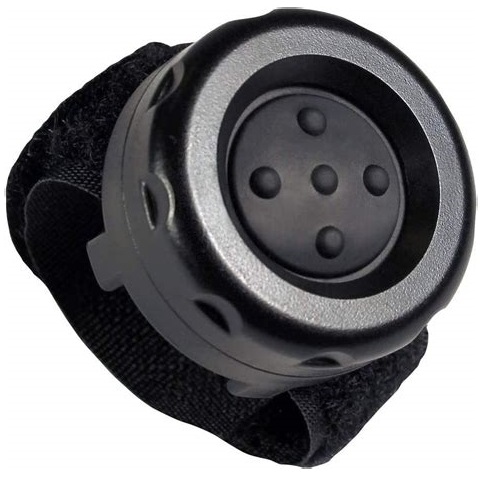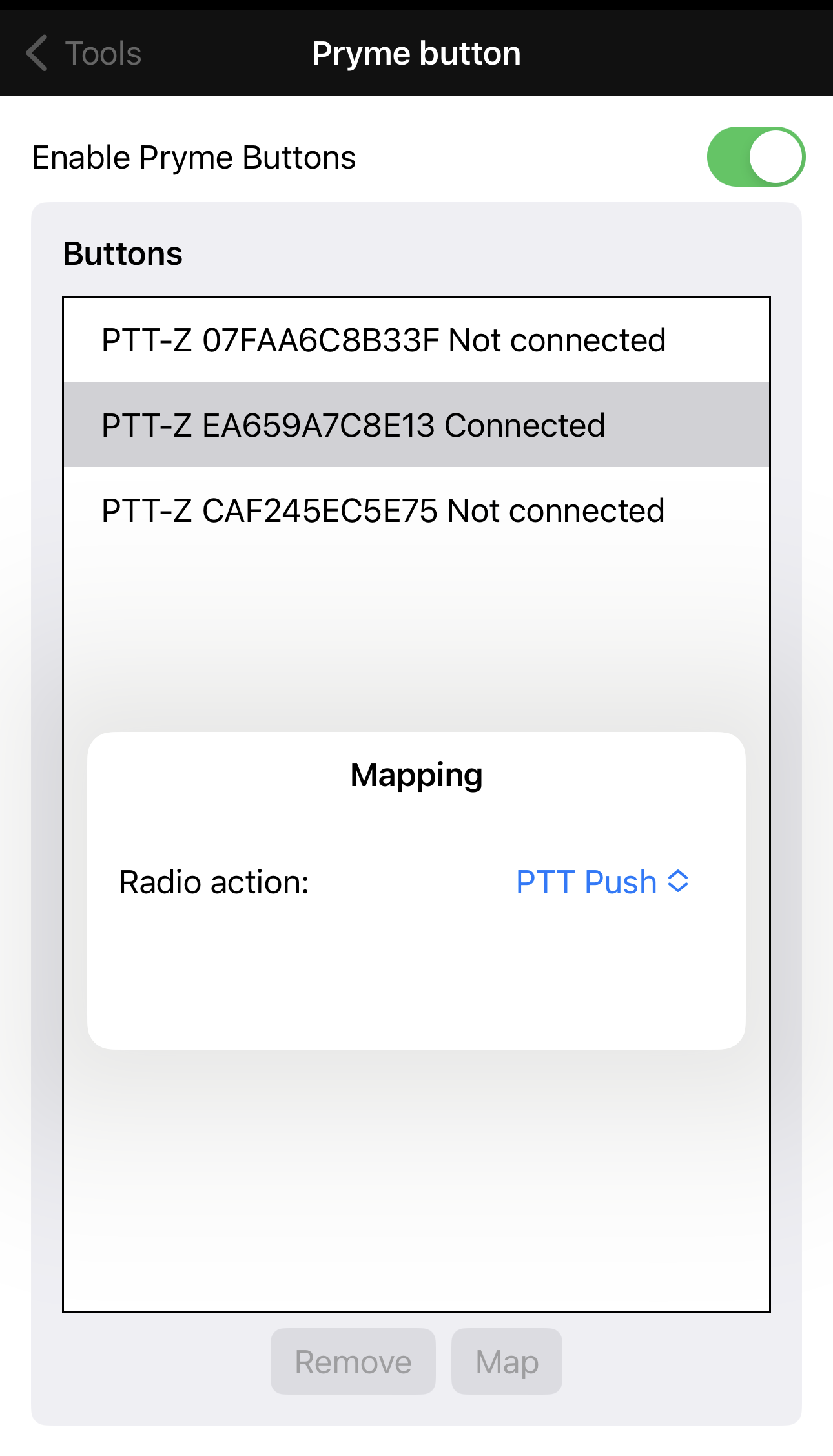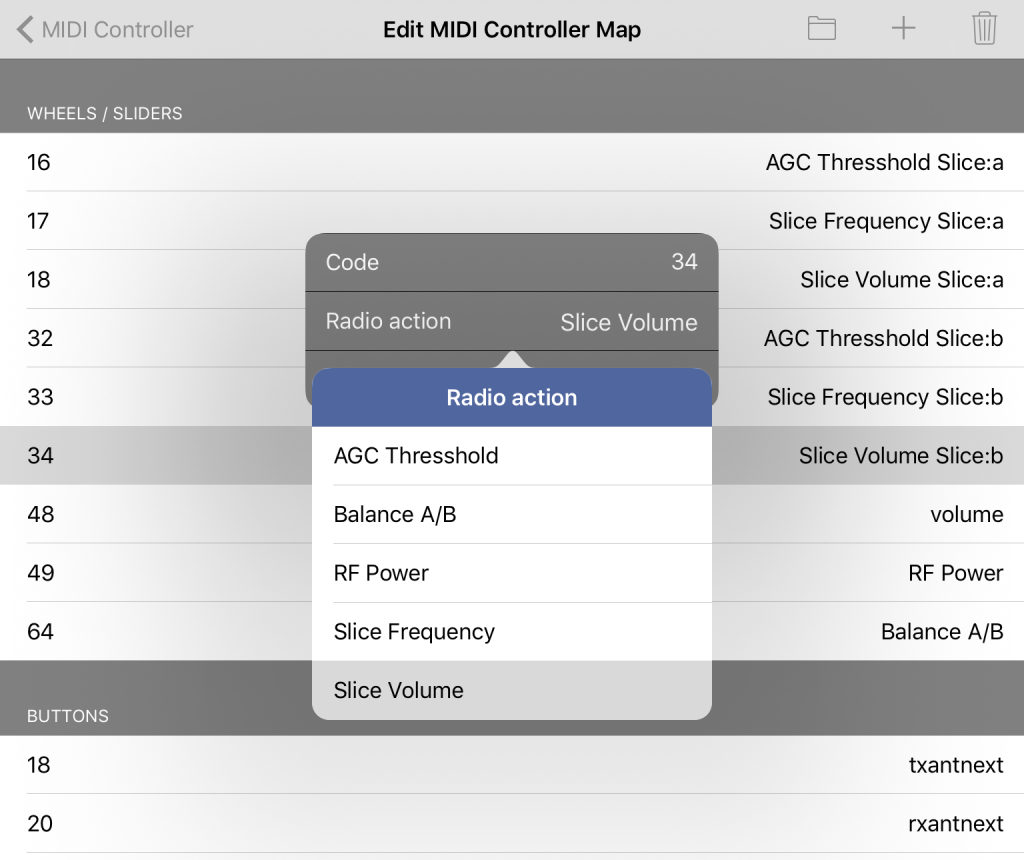SmartSDR™ for iOS - Software user guide
1. About the App
SmartSDR™ for iOS is an iOS App for your iPhone and iPad to operate your FlexRadio via network either from Home, where your FlexRadio is located or from around the world over the Internet.
I developed this App because I got used to and really like the nice, clean, and straightforward user interface of SmartSDR on my Windows PC and wanted to have the same for my iPad (and iPhone).
This goal in mind, I started developing this App around January 2016. I tried to implement as many features as possible of SmartSDR for Windows and as much as would make sense for my App. Of course, not everything from a Windows and mouse-driven software makes sense to take over to an iOS and touch-driven App. For instance, on the Windows environment, you have mouse-over or hover effects which can be used to display tooltips or additional menus, and you have a mouse scroll wheel. Such features are not available on touch devices. Also, touching screen locations is less precise than using a mouse. On the other hand, panning, zooming and other gestures are easy to use on touch environments. I tried to merge both approaches as best as possible, but the main goal was always to let my App look and feel like SmartSDR for Windows.
My second goal was to add features to the App that I am currently missing in SmartSDR for Windows or features for which I have to run additional separate software on my Windows PC. For instance, I would like to see a band-map and DX-Cluster Spots inside the Panadapter. So this is now possible with my App.
Many OMs have tested my App and have helped to make this App as useful as it is today – many thanks to you at this point!
For the future, I have several ideas, what can be added to make this App even more powerful and useful. Just recently, I added a Logging feature which was on top of my priority list but I am also interested in listening to your suggestions.
1.1. Operate in any Mode
You can operate in SSB using the iPad or iPhone internal Microphone or use a Headset like Apple’s AirPods or another Bluetooth Headset. You can also operate in CW using the integrated CWX Keyer . Furthermore, you can operate in FT8/FT4 using the integrated FT8 Tool. This all is now possible from your iPhone or iPad. No Mac or PC is needed.
1.2. Local or Remote
Besides the possibility to connect to your Flex via WiFi at home, where your Radio is located, this App also supports Remote Access to your Radio from around the world without the need for additional Hardware or Software. The easiest way to remote connect to your FlexRadio is to use a Service from FlexRadio called SmartLink. This App supports SmartLink and later in the manual, you will find an easy to follow instruction on how to setup and use SmartLink.
1.3. Troubleshooting
In case of problems, please first have a look to the Common Issues section of the manual. If you can’t find any help there, please use the App included Contact Developer feature to contact me and I will be happy to help.
2. The manual
This manual explains how to setup the App to connect to your FlexRadio and how to work with the App.
As this App is based on SmartSDR for Windows, this Manual assumes that you are already familiar with SmartSDR for Windows. It does not cover or repeat things that are almost identical to SmartSDR for Windows.
For this reason, please consult the FlexRadio SmartSDR for Windows Manuals which can be found here:
http://www.flexradio.com/support/downloads
So for this manual, it is assumed that you are familiar with terms like Slice, Panadaper and TNF but even if not, you will be able to operate your FlexRadio by this App after reading the manual.
This manual can be opened from inside the App from the Settings tab or directly following this link: https://go-to.me/smartsdr-manual .
If you prefer a printed version, just tap here. This can also be used to save a PDF file of the Manual.
But please keep in mind, that this manual will be updated from time to time.
2.1. Videos
In addition to the manual and for those who don’t like to read manuals, there are also a few videos from popular HAM Radio bloggers in English at the bottom of the App’s website: ham-radio-apps.com
3. Requirements
You need to have a FlexRadio Signature Series Rig such as the Flex-6300, 6400, 6400M, 6500, 6600, 6600M, 8400, 8400M, 8600, 8600M, 6700 or 6700R or 8400, 8400M, 8600 or 8600M device.
It needs to be connected to your local network in the same way as if you would run SmartSDR from a Windows PC. Second, you need to have a WiFi Connection to your network in the same way as you likely already have for your iPad or iPhone.
There is nothing special regarding this network or WiFi connection and most likely everything is already setup correctly if you are already using your FlexRadio along with SmartSDR and if your iPad or iPhone already uses WiFi.
The App only requires at least iOS 17 or newer; there are no additional special memory or hardware requirements.
The newest iOS Version is always preferred as the App takes advantage of some features only available in the newest version.
Note
Some tools are only available on iPads and larger iPhones (Max models).
If you have paid for the App, (thank you!) you can run it on several additional devices with any number of FlexRadios. No additional purchase is necessary. You only have to use one and the same Apple ID on all your devices.
4. Setting everything up
Note
Previously, it was necessary to acquire specific features within the app through what were called In-App purchases. Starting with version 7 of the app, this is no longer required. Once the app is purchased, all features are included and can be used without additional charges.
4.1. Connecting to your Radio
The first step should be to connect to your Flex locally, where your FlexRadio is located. After this is working, you can setup the App and your Radio for Remote access too, if you like.
The following diagram shows a typical installation.
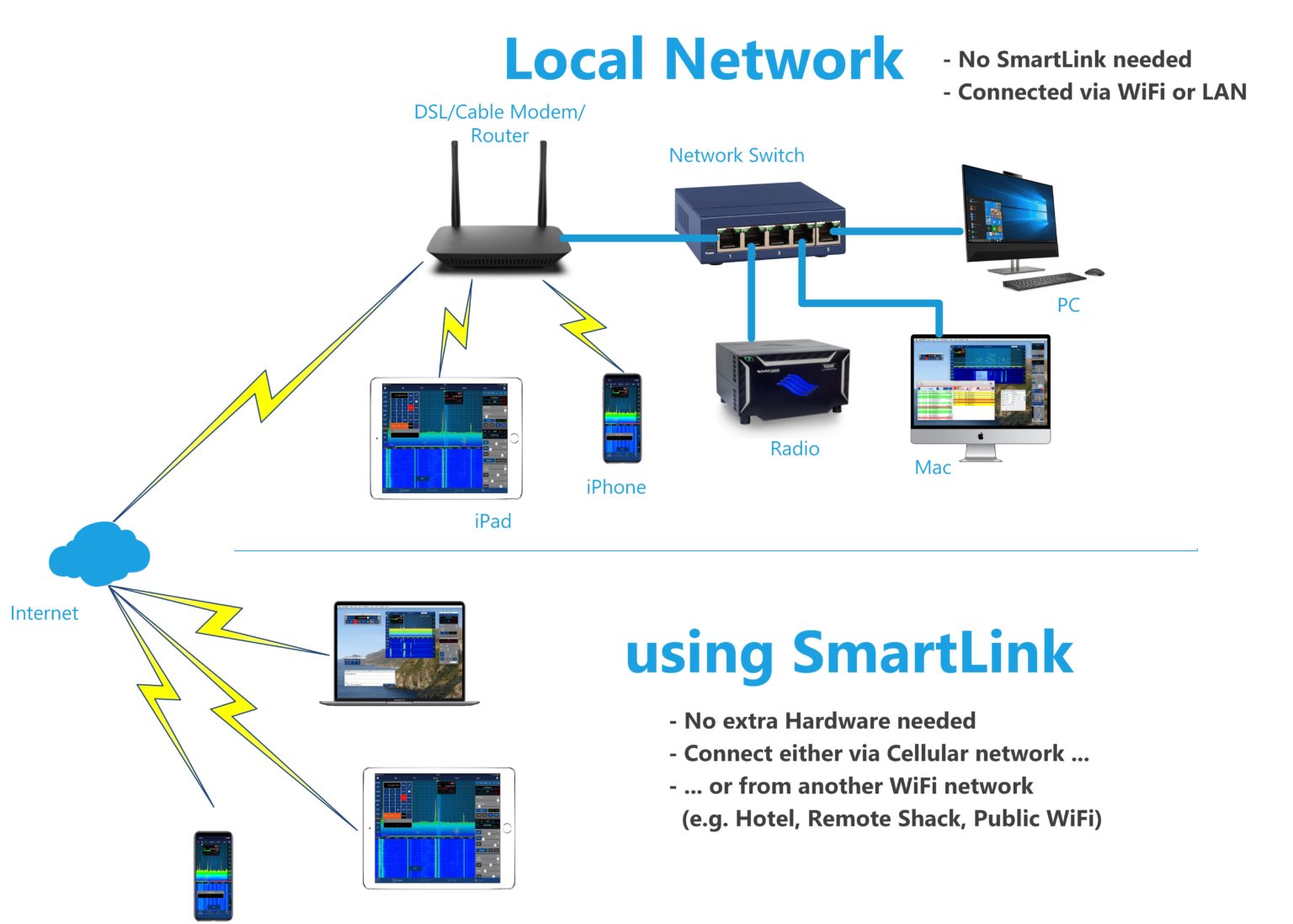
Don’t be scared. It may look complicated but it isn’t.
For the local connection, we only have to look at the upper part of the diagram.
This diagram shows a typical installation. The Radio must be connected using LAN cables to your router. It can be connected using Network Switch in-between like in the diagram but it could also be connected directly to the router.
Warning
The Radio must not be connected directly to a PC or Mac
Other devices like Computers can be connected via LAN cable as well, or WiFI. Your iPhone and iPad usually uses WiFi to connect to your network.
Once you have such a setup in place, you can start the App, tap on the leftmost Panadapter Icon at the bottom to visit the Panadapter screen (if not already selected) then tap on the center of this screen or the Con button at the top.
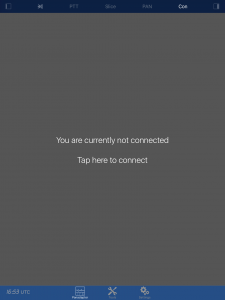
Next, you will see the Radio Selection list similar to this:
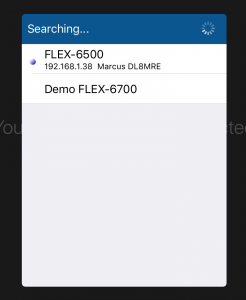
In this example, you can see a Flex-6500 on the network as well as the Demo Device. Just tap on either entry to connect to the device.
Once connected you will see the Main Window of the App showing the Panadapter.
Attention
if you don’t see your Radio in the list or it doesn’t connect, please have a look to the Common Issues section of the manual. If you can’t find any help there, please use the App included Contact Developer feature to contact me and I will be happy to help.
4.2. Remote access using SmartLink™
FlexRadio Systems has introduced a so called SmartLink™ remote access feature which facilitates the ability to securely and easily operate a FLEX-6000 SDR over the Internet without the use of VPN or specialized hardware. All of the necessary software to use SmartLink™ is integrated into SmartSDR v2.0 for Windows, Maestro, macOS and iOS clients for seamless remote operation.
In order to use SmartLink™ with this App, you will need to have at least version 2.0 of SmartSDR installed on your Radio and you will have to Register your Radio for Remote Access via SmartLink™ using SmartSDR for Windows (Please see the separate SmartLink Setup Guide for details.
Once these preconditions are met, you just need to switch on SmartLink on the Settings screen.
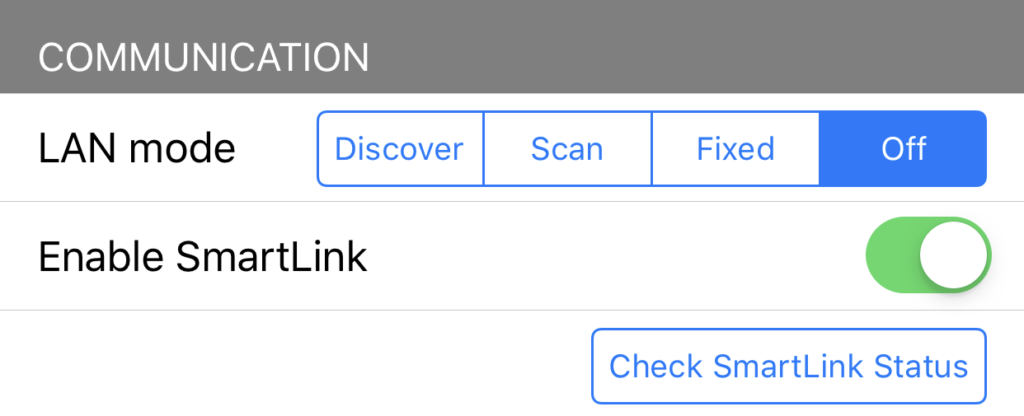
The button Check SmartLink Status can then be used to check if you can access SmartLink. Once you hit this button, you will be prompted for your SmartLink credentials:
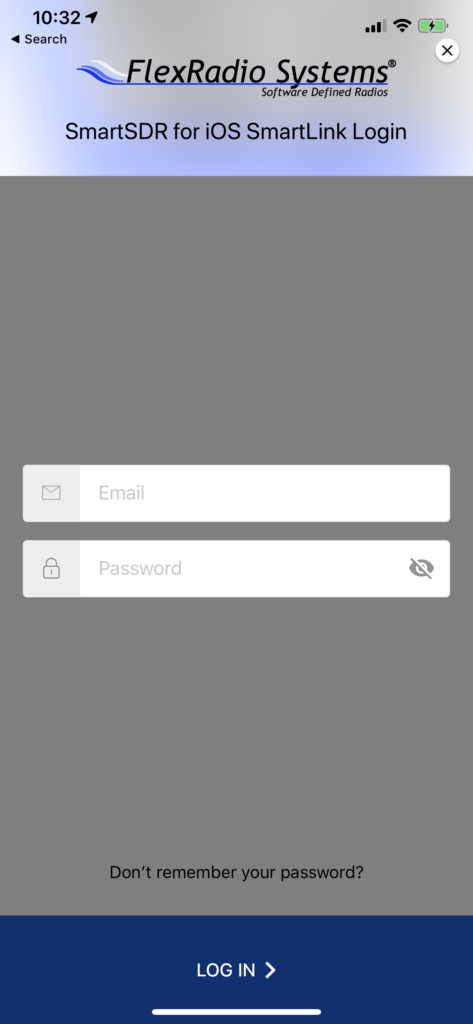
Here, you need to enter the E-mail / password pair you have used while registering your Radio for SmartLink.
Note
Your email address has to be entered in small letters.
After you entered your SmartLink credentials and tap on “Log in”, you will see some diagnostic information while the App tries to connect to SmartLink and finally you should see your connection status and user information.
If this fails for some reason, just try again and if this doesn’t resolve your issue, try to use SmartLink from your SmartSDR for Windows version.
If you are successfully able to connect to SmartLink, you now just connect to your Radio from the main Screen of your app as usual: Just tap on the Panadapter main screen or the Con button at the top.
After the SmartLink connection screen, you should see your Radio in the list of available Radios.
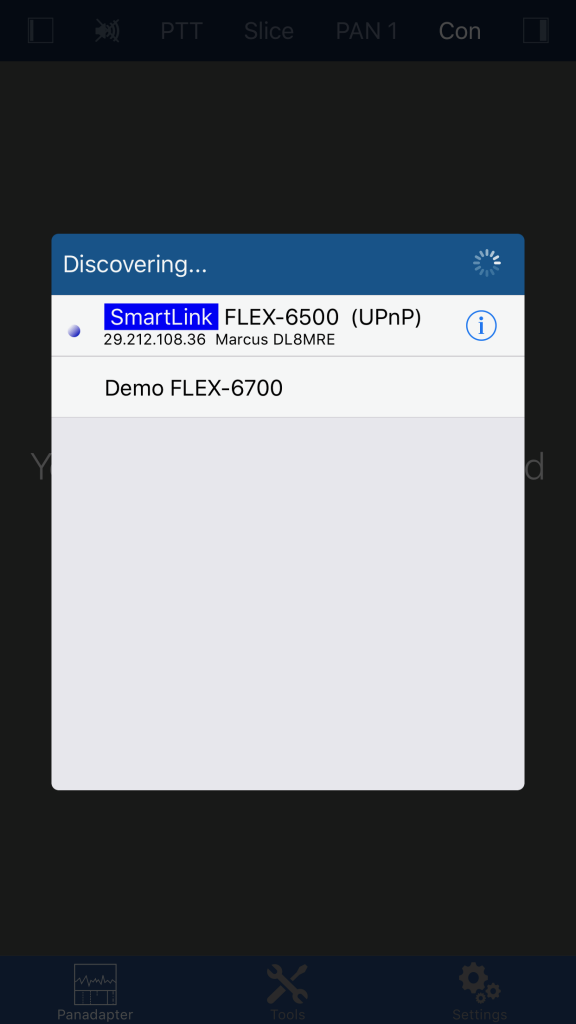
The blue SmartLink will be displayed in front of the Model to indicate that this Radio is available via SmartLink for remote access. By tapping on this entry you can connect to your Radio as usual.
Attention
In case of issues with SmartLink, please head to the Common Issues section of the manual. There is a dedicated chapter dealing with possible SmartLink issues.
4.3. Multiple SmartLink accounts
With the introduction of MultiFlex by FlexRadio it is more likely that you have more than one SmartLink account. For instance if somebody else is sharing the Radio with you or to access your Radio at your HAM Club.
Starting with App Version 3.7. it is now possible to maintain multiple SmartLink accounts in a convenient way: Each SmartLink account you once log-in will be stored automatically. A new menu allows you to easily switch between these accounts without the need for entering the credentials again.
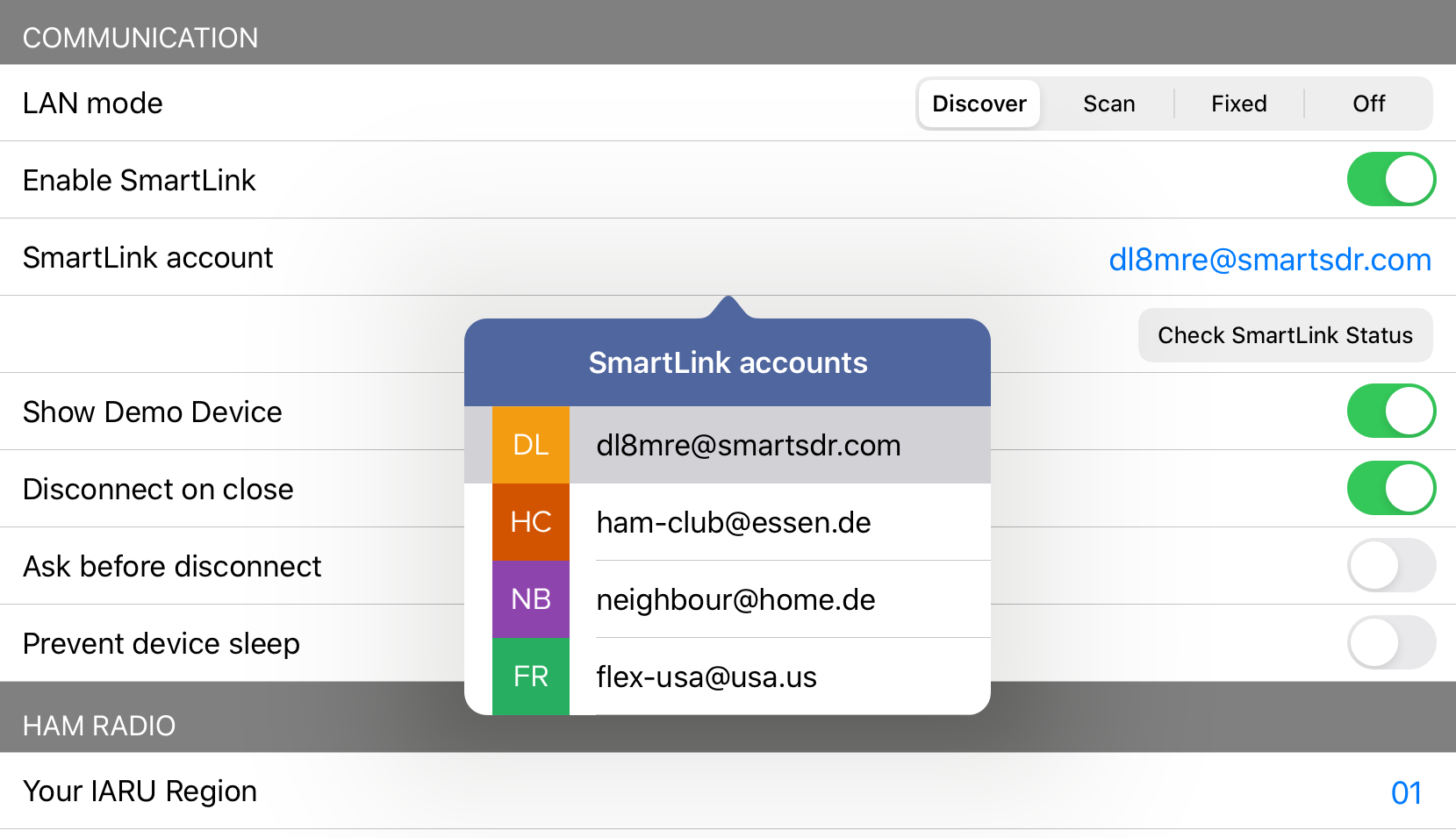
A new menu SmartLink account allows you to easily switch between these accounts without the need for entering the credentials again. Just tap on an account of the list to switch to that account. The next time you use SmartLink that account will be used.
If you want to delete an entry from the list, just swipe the entry to the left, as usual.
To add more accounts, just use the Check SmartLink Status button to Logout from the current account. Then use this button again to login to another account which will then be stored as well.
4.4. Final settings
Before using the App either local or remote, please have a look to the various App and Radio settings which are described in chapter Settings of the manual.
5. The Main Window / Panadapter
After connecting to your FlexRadio, you will see the main Window showing the Panadapter.
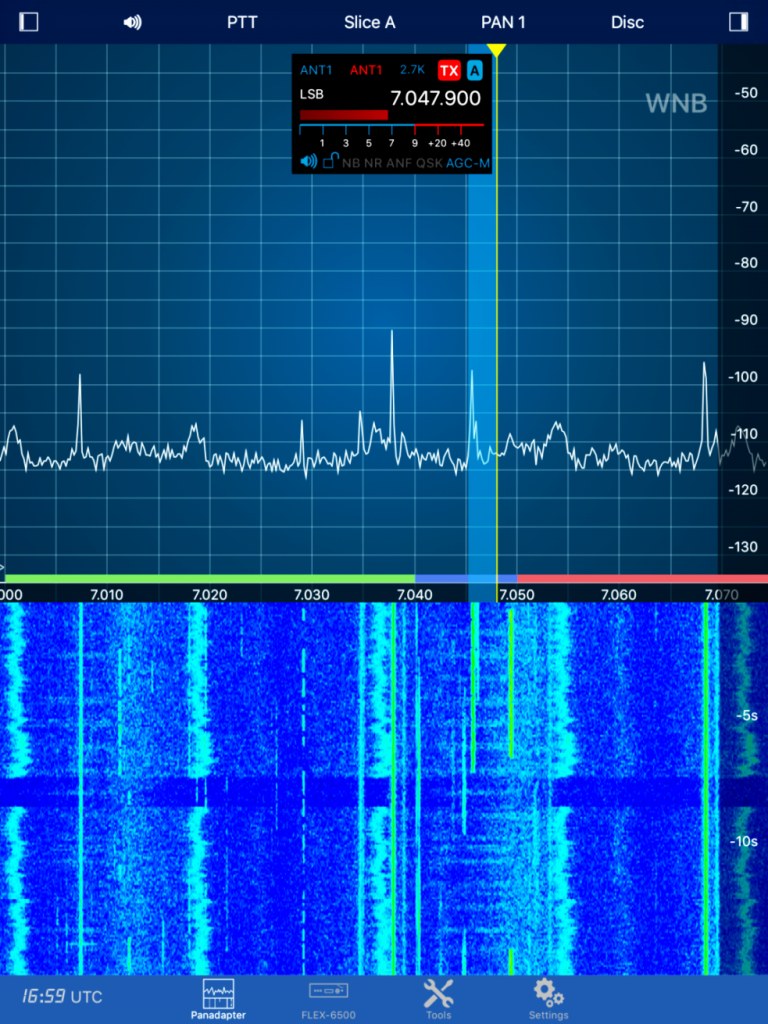
This screen looks very similar to the main screen of SmartSDR for Windows.
From here, you can maintain your FlexRadio by using the menus at the top which opens additional menus. You can also use some gestures on this screen which will be explained further below.
Using the bottom tabs, you can switch to screens which are also explained further below.
To disconnect from your device, use the “Disc” button in the top menu.
The top speaker icon can be used to mute/unmute audio.
Note
If you don’t get any Audio even if unmuted, most likely you will have to use the left Audio menu to switch from local to remote audio using the Switch called “iPad Audio” or “iPhone Audio” (depending on your device). If this switch is “On”, your iPhone/iPad audio is enabled. Otherwise your Radio Lineout Audio is enabled.
6. Additional Windows
In addition to the Main Window, you can open (and keep open) additional Windows from the View menu.
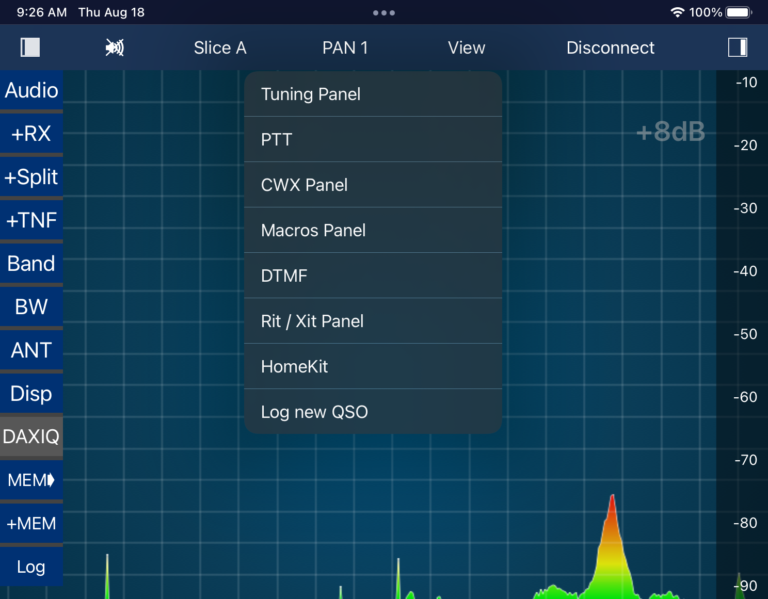
6.1. Tuning Panel
This menu will show or hide the Tuning Panel for the currently active Slice.
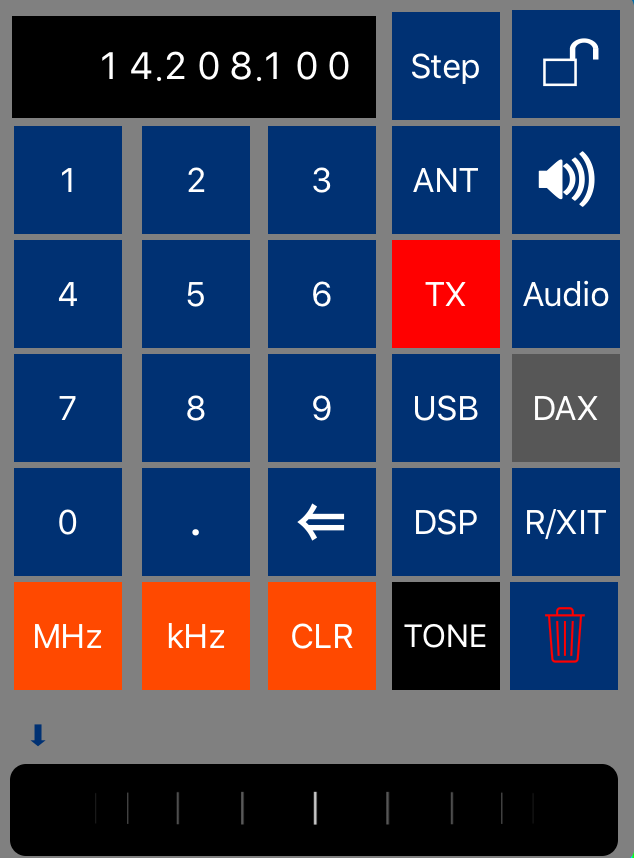
6.2. PTT
This will show or hide the PTT button. To move the PTT button to another location, just use two fingers to touch and move the button to the desired location.
6.3. CWX Panel
This window will be used to send CW. The button at the top right corner can be used to squeeze or enlarge this window.
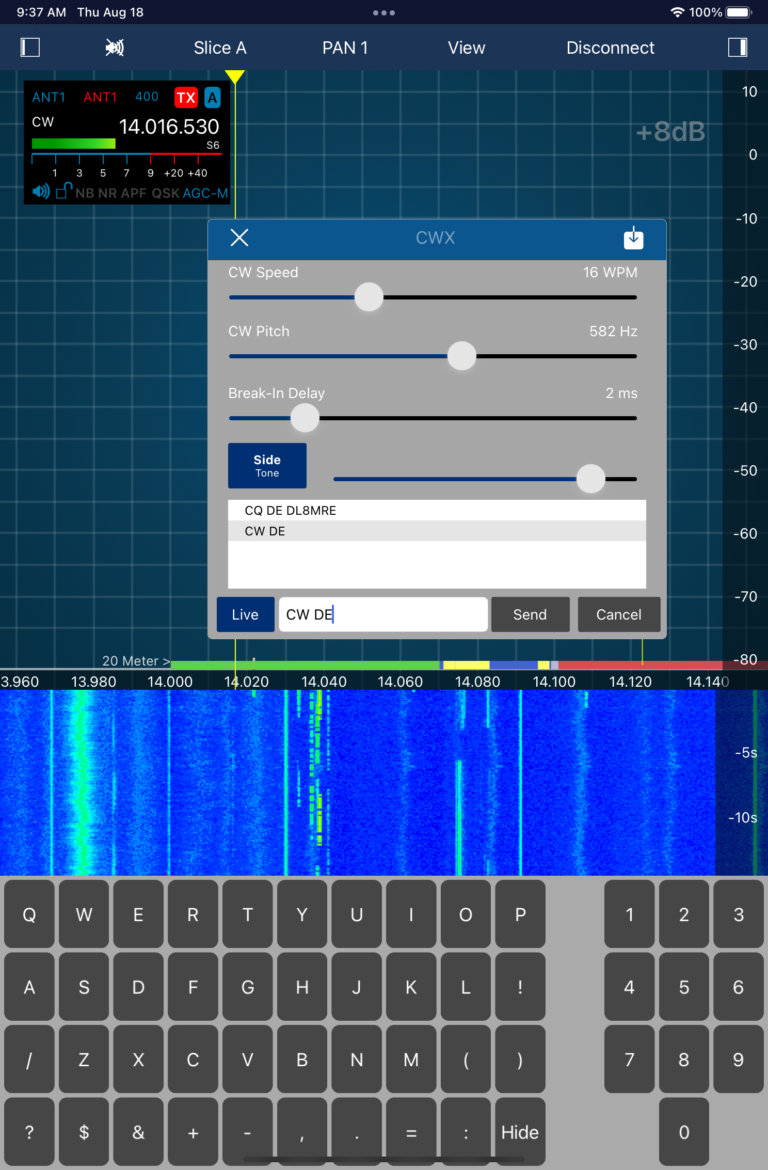
If the Live button is enabled (blue) all characters, just entered will be transmitted immediately – otherwise as soon as the Send button was hit. You can tap on a row in the list to re-transmit a certain line.
If enabled under Settings, this panel will use an alternative Keyboard which is more convenient for CW.
6.4. Macros Panel
The Macros Panel will display your CW- or Voice-Macros (depending on your current mode) as small buttons.

In order to get these buttons displayed, you need to maintain the Macro and it’s Title under Tools for each of the Macro types. By hitting a Macro button, the Macro will be transmitted. Hitting Cancel will suspend the transmission.
6.5. DTMF
This window can be used to send DTMF or a 1750 Hz repeater tone.

6.6. Rit / Xit Panel
This window can be used to maintain and operate in Rit / Xit mode
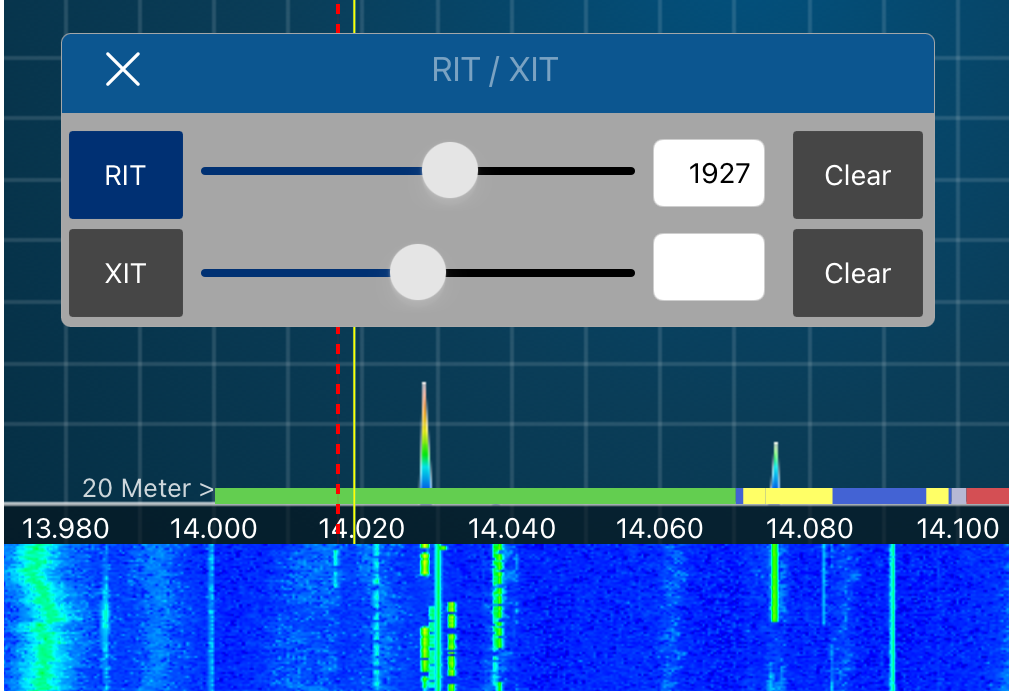
6.7. HomeKit
If you are using HomeKit and have maintained (selected) HomeKit devices under Tools, this menu will show the selected HomeKit devices e.g. to remotely switch on your PA or the Radio itself.

7. Settings
In this App, you can maintain different types of Settings. First, there are general App Settings which are App and not Radio specific such as your HAM Radio information like Call-sign, Country, Locator etc. and your credentials for the integrated Call-Sign lookup features. These settings can be maintained from the Settings tab at the bottom. Second, there are Radio specific settings which can only be maintained, once you are connected to a Radio. In this case, you will see another tab at the bottom named according your Radio type like Flex-6600 which can be used to maintain the Radio settings.
And finally, there are the Audio settings which can be used to define your Microphone and Speaker source and volume.
7.1. App settings
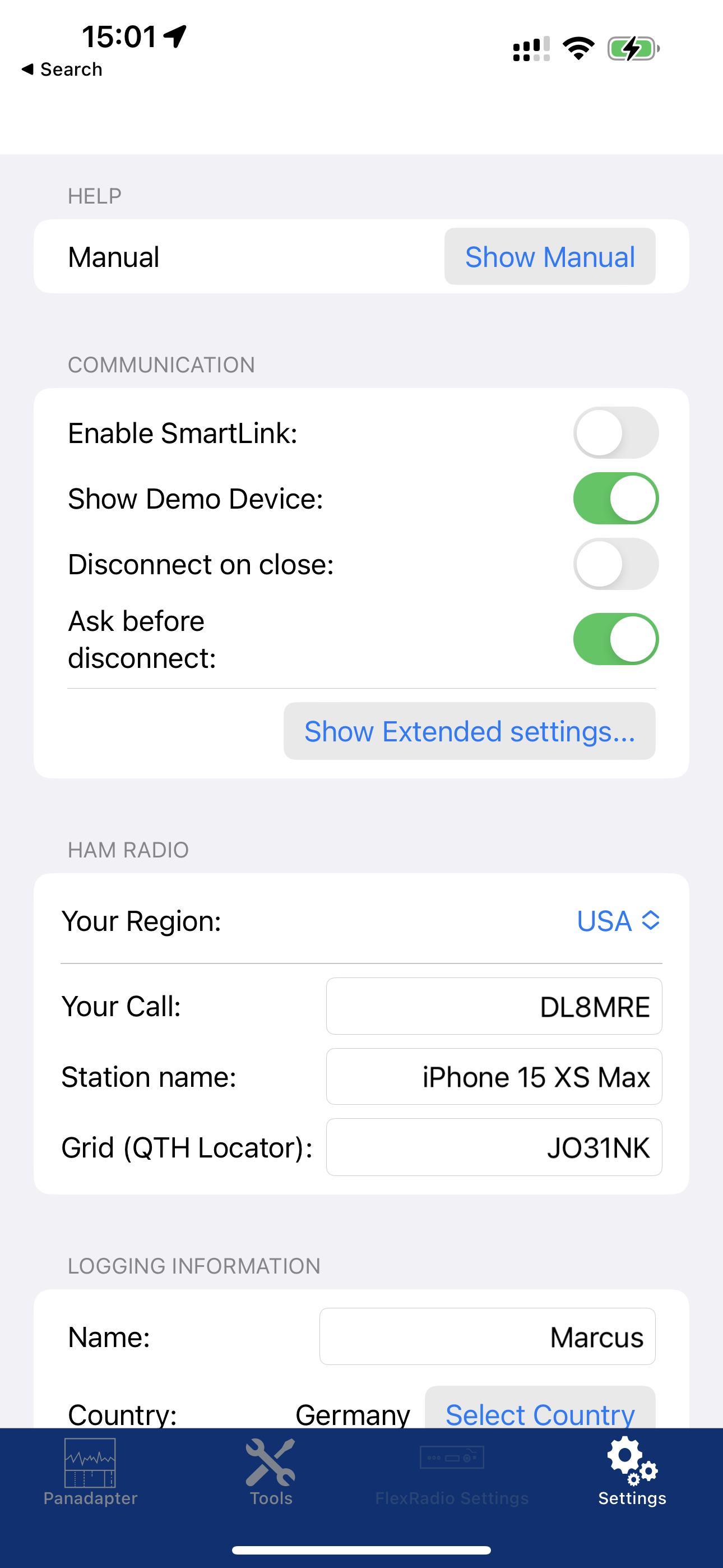
Most of these settings are self-explanatory but some are explained further below. It might be worth to go though these settings and add / select your personal information and preferences.
7.1.1. HAM Radio
Here, you can select your IARU region. This setting is currently used for the Bandmap and the DX-Cluster Tool. Please note, there is a dedicated entry for the US which offers a slightly different Bandplan to the IARU Region 2 Bandplan.
The Your Call field will be used, for instance, for the Logbook Tool to fill the corresponding ADIF Fields appropriately.
The Grid (QTH Locator) field will be used for the DX-Cluster Tool to show your current location on a Map and calculate distances and bearings.
7.1.2. Logging information
The information entered here will be used for logging your QSOs.
Attention
When using you Logbook to chase awards, it is essential that the fields below are filled out correct. Otherwise QSOs will either not be accepted or will not match with other QSOs. You could leave most fields empty but if you use them, for instance to hunt for awards, please double check the correct usage for your Country on the LOTW website. For instance, for the US, the State needs to be entered using the two-letter State abbreviation whereas the County needs to be fully written out.
7.1.3. Call Databases
Some tools like the DX-Cluster tool or logbook are providing features to lookup Calls either at HamQTH or QRZ.com. Here you can enter your credentials in order to use these features. After entering your credentials, please use the Test Button to check if the credentials are working.
Note
For using HamQTH and/or QRZ.com you need an account on each platform. For QRZ.com, in addition, you need an active XML Logbook data subscription (see https://ssl.qrz.com/products/index.html ).
Attention
If the test fails even if you have entered correct credentials, your password might be using some special characters like : & or ? which can be used when accessing the website but not for accessing the call lookup API.
7.1.4. External Software
Here, you can enable UDP Log submission to other Logging programs. Details are described in the Logbook chapter.
7.1.5. Information & Support
Here you can find the “Contact Developer” button in case you have questions or issues.
7.1.6. Extended Settings
Using the “Show Extended Settings” button you will be able to change additional settings.
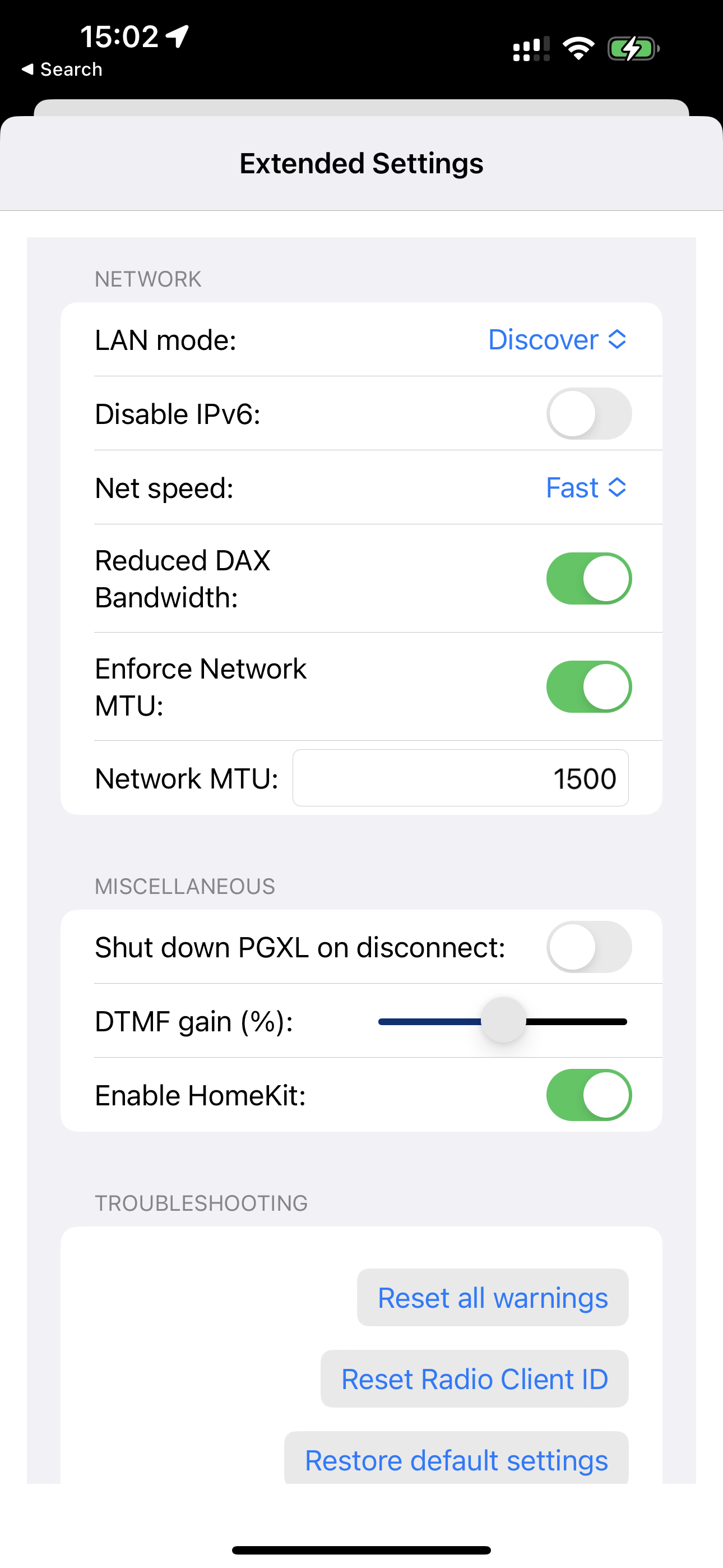
The LAN mode should usually be set to Discover.Only in situations (e.g. when using a VPN) you may need to change this setting in order to enter (or search for) the IP Address of your Radio. Also when using a VPN, you may need to alter the so called Network MTU value in order to prevent Packet fragmentation.
The “DTMF gain” slider will increase or decrease the DTMF Tone gain, when sending DTMF using the Button on the Slice Details screen.
In case of issues with your Radio (Panadapter doesn’t appear or not able to create a Slice or other oddities) you can safely use the Reset Radio Client ID button.
7.2. Radio settings
As mentioned before, the settings here depend on the currently connected Radio.
You can find these Settings by tapping the tab at the bottom which is named like the FlexRadio you are connected to.
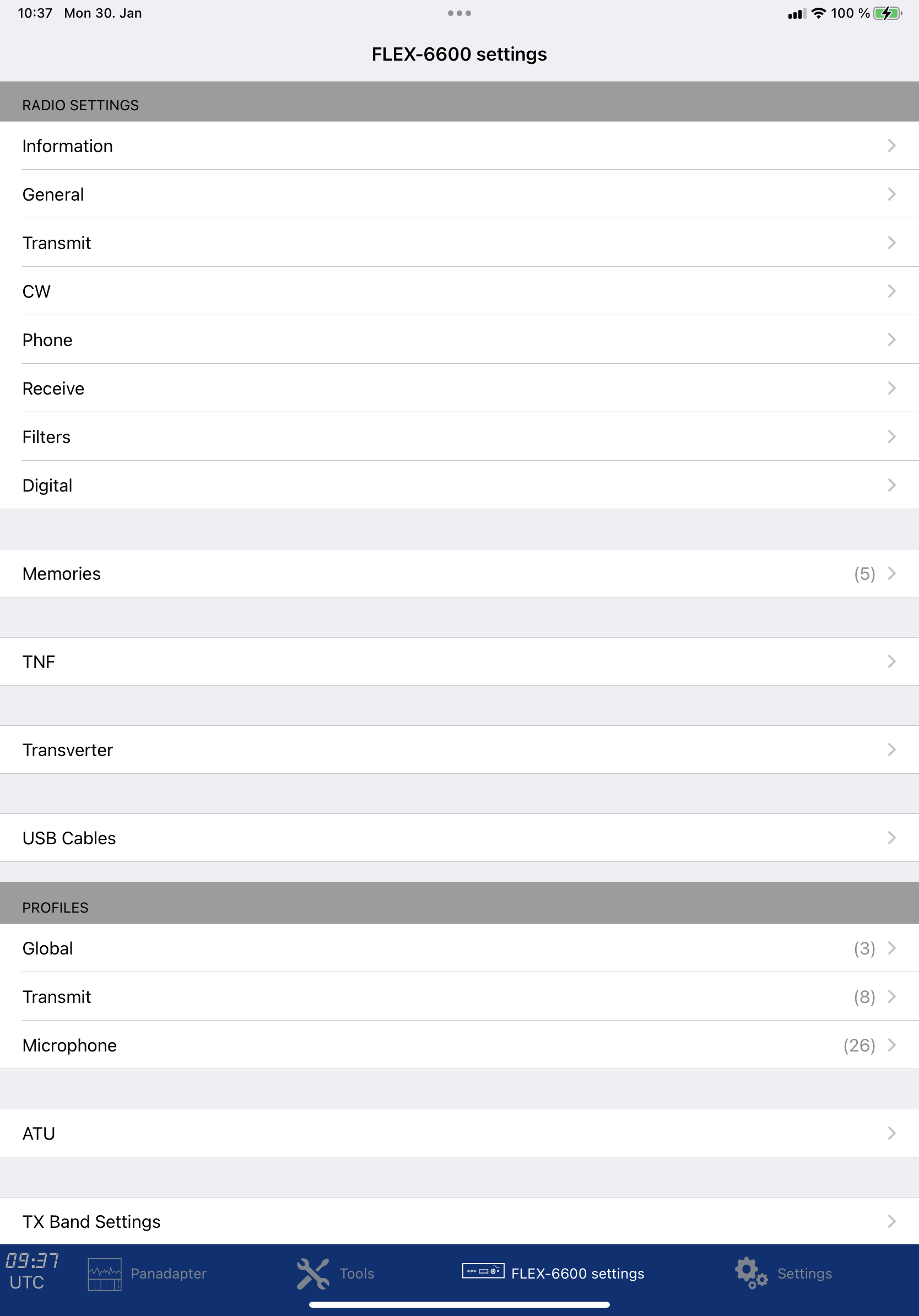
The Information menu provides information about your Device such as Region Code, Model, Serial # etc. all of which can not be altered.
The General, Transmit, CW, Phone, Receive, Filters and Digital menus are providing possibilities to alter various settings pretty much in the same way as SmartSDR for Windows does from it’s Settings menu.
7.2.1. Memories
The Memories section allows you to maintain all Memories stored on your device. Different to SmartSDR for Winwows, this App also allows you to sort the Memories by Band.
7.2.2. TNF
The TNF section can be used to maintain and select TNFs, stored in your FlexRadio. There is nothing similar available in SmartSDR so far.
7.2.3. TRANSVERTER
The Transverter section can be used to maintain the settings for your Transverters, if available. Any Transverter maintained here, can be selected using the left Band menu.
7.2.4. USB CABLE
This section allows to maintain USB Cables as introduced with SmartSDR version 1.10. More information can be found on http://www.flexradio.com/downloads/usb-cable-interface-guide-pdf .
After opening this USB Cable section, you will see a list of all available USB Cables of your FlexRadio:
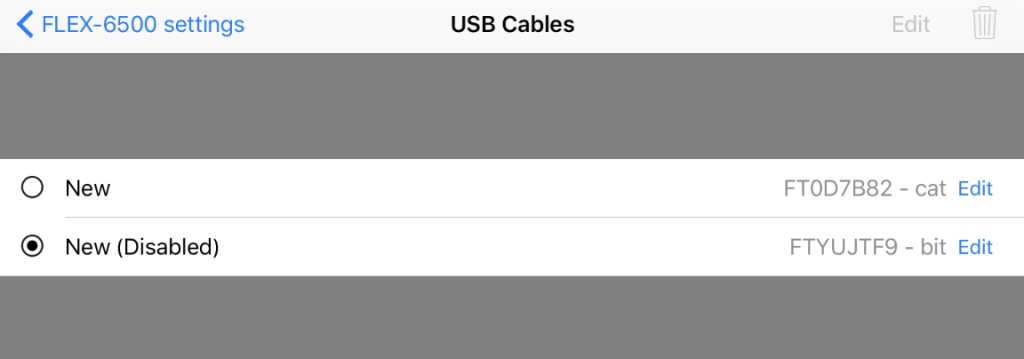
Each line in this list represents one recognized USB Cable with its assigned Name, Serial number and type. The Dot inside the circle indicates that that particular cable is currently connected.
Note
Different to SmartSDR for Windows, additional cables cannot be created manually. Instead, they just need to be connected once to the Radio and after this, the new cable will show up in this list and can be configured or even deleted again.
All configurations, including the Name are stored on the Radio. Changes from the iOS App will be available for the Windows Version as well and vice versa.
Maintaining USB Cable entries is similar to the other screens like the TNF or Transverter section. Entries can be maintained by hitting the edit button or deleted by swiping the line to the left.
The editing screen offers the same options like the Windows Version. Depending on the Type selection, you will see different additional options.
For CAT Cables you can maintain Source and CAT specific settings like Speed (Baud-rate) etc.
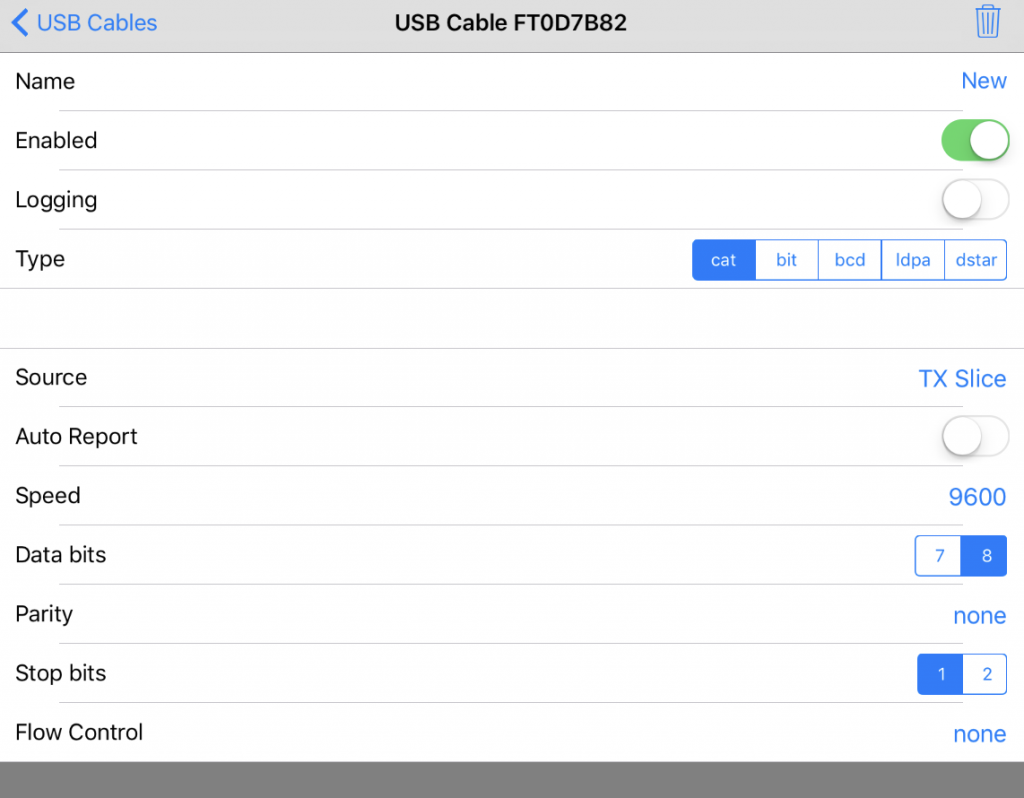
For BIT Cables, you can configure each Bit-Pin individually by tapping on Edit …
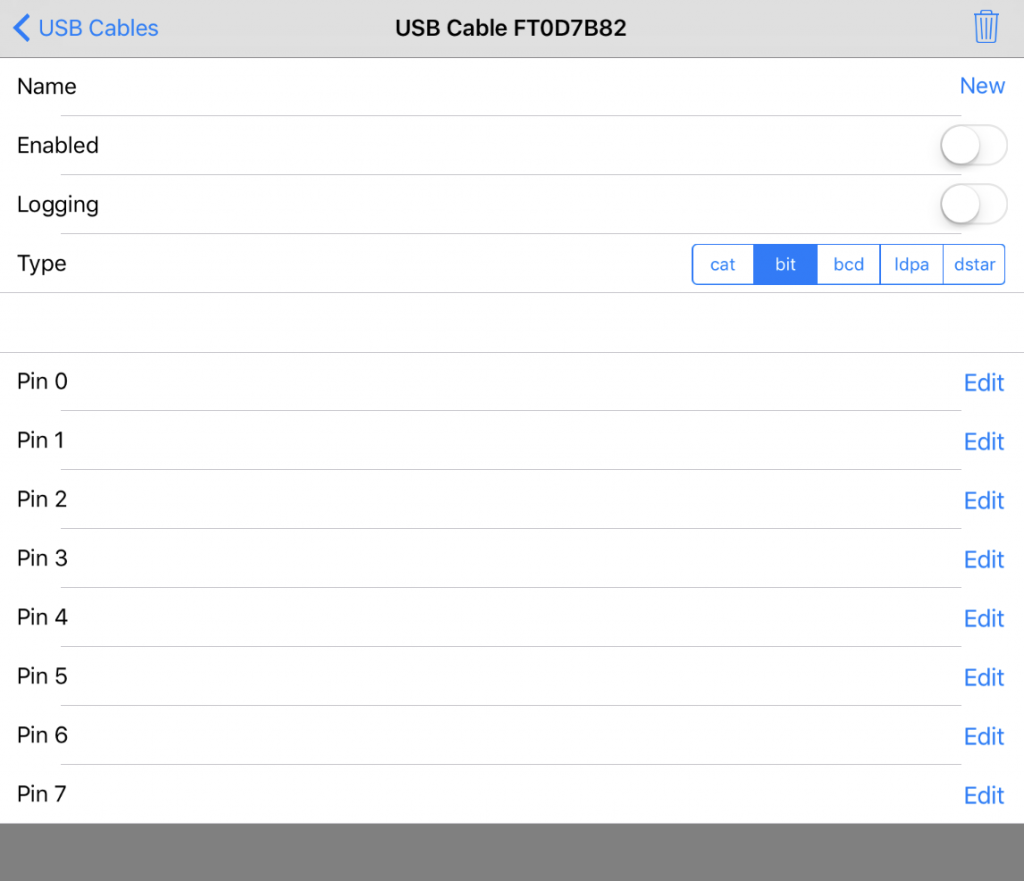
… and select the desired options for the Pin.
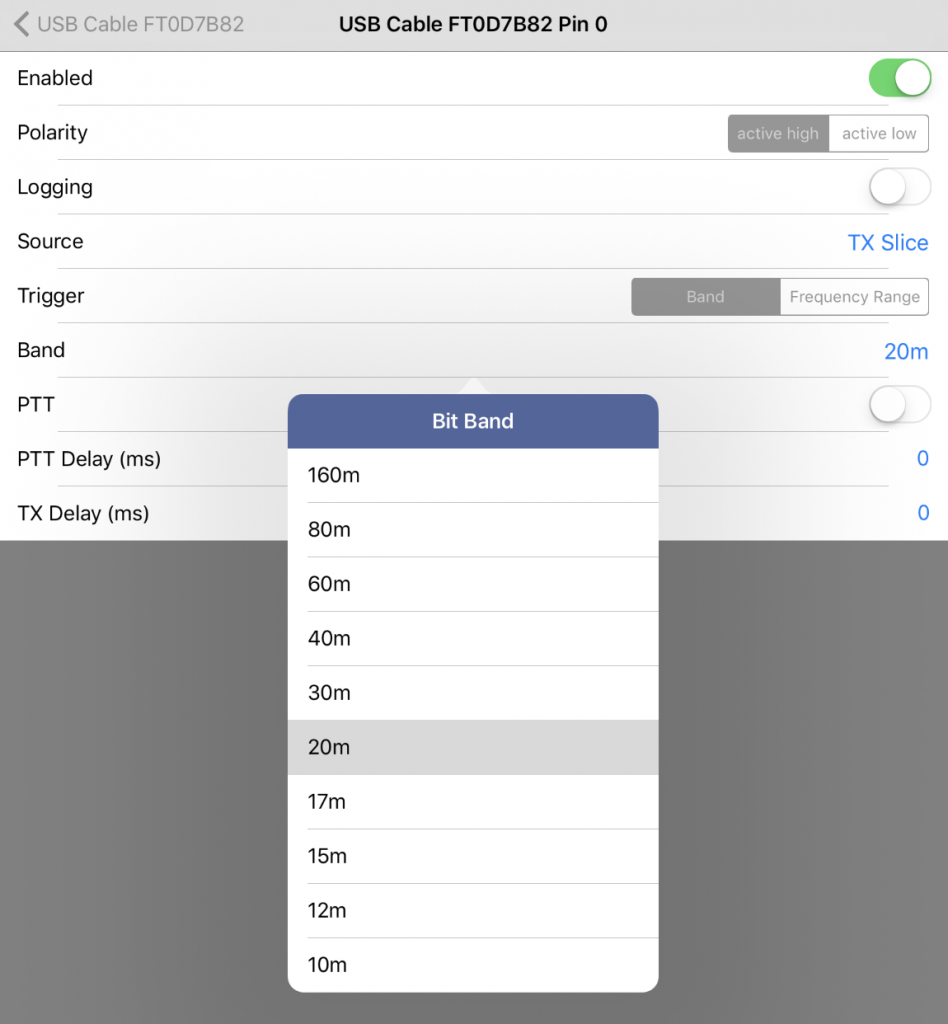
7.2.5. Profiles
Under Profiles you can maintain or select Global, Transmit or Microphone Profiles which are stored on your FlexRadio.
7.2.6. ATU
Under ATU you can find the “Clear all ATU Memories” button.
7.2.7. TX Band Settings
Here you can limit TX power per band or change other band related TX settings.
7.2.8. Multiflex
Using this menu, you can view your Multiflex settings, if you are using Multiflex.
7.3. Audio settings
The Audio Menu can be found in the left menu bar and includes various Audio settings.
If iPad (or iPhone) Audio is disabled, Audio of the Radio will be send to the Line Out socket of the Radio where you can connect your speakers.

Using button right of “Device:” you can select the audio device used by the App which can either be the internal Microphone and Speaker, a Headset or any other Audio device linked to your iPad or iPhone.
The Default to Speaker option is only available on iPhones. Enabling this button will cause Audio to go out of the Speaker of the iPhone which provides a louder output. The iPhone Speaker can also be selected using the Device button.
Attention
Default to Speaker and Enable Stereo must be turned off if you ant to use a Headset
The Listen only mode* allows to use Headsets or Speaker only device like HomePod which don’t provide a Microphone.
The Local Audio Monitor slider adjusts the volume of the microphone sound which is send back to the Speaker. Using this feature only makes sense when using a Headset.
The Microphone threshold slider can be used to eliminate ambient sounds.
At the bottom of this Menu, you can globally enable or disable all TNFs.
8. Frequency Tuning
Frequency tuning is probably one of the main activities when using the App. For this reason, there are several possibilities for frequency tuning:
Move the Slice with your finger
Double-tap somewhere on the waterfall to move the currently active Slice to that frequency
Enter the frequency manually
Use the Tuning Panel window to fine tune a frequency (View Menu → Tuning Panel or tapping on the Slice flag frequency)
Attach a MIDI controller such as the DJ2GO2 to your device via USB cable and use it for frequency tuning and more
Attach a Keyboard to your device and hold the Option Key along with , (comma) or . (dot) to change the frequency down or up by one step or 10 steps when additionally pressing the shift key.
The following screen illustrates some of the options:

8.1. Moving the slice
You can move the slice directly with your finger up and down. For this, just tap and hold your finger on the slice, the slice starts blinking, then you can move the finger to the left or right to adjust the frequency.
8.2. Use the tuning wheel – the Tuning Panel
First, tap on the Slice flag to open the Slice detail screen or use the view Menu → Tuning Panel.

At the bottom of the screen you can see the tuning wheel. Now you can spin this wheel clock- or counter-clockwise to adjust the frequency. This wheel regards the Step setting which can be changed using the blue Step button.
The Speaker Icon will mute this particular slice. To mute all other slices, except for the current slice, just double-tap on the Speaker Icon. Double-tapping again will reverse this.
Under Settings, you can chose to reverse the tuning direction if you like. Direct Frequency input
You can also directly enter the desired frequency. For faster input, there is no Enter key. Instead, you can just type the Frequency digits, including a decimal point if necessary then finish by either pressing on MHz or kHz. Depending on this, the entered value will be regarded as MHz or kHz accordingly.
For instance, enter [3][.][5][MHz] for 3.5MHz or [7][1][2][5][kHz] for 7.125 MHz.
The [<=] Button is the Backspace button and the [CLR] button will clear all input.
Note
This slice detail screen can be moved to any location (e.g. if it covers the area on the Waterfall you like to see) by just touching and moving the screen.
Also, there is a smaller version (with less options) available from the right menu when tapping the frequency.
By using the small arrow button in the lower left corner (not shown in the video above) you can toggle between two different layouts of this screen.
It is also possible to connect Hardware Controllers to the iPad or iPhone which can be used for tuning and other Radio controls. Please see the separate Tools Manual for details about hardware Controllers.
8.3. Slice Filter and TNF maintenance
Filters and TNFs can be maintained in a similar way.
Besides the aforementioned possibilities to create a Slice or TNF, you can also long-press at any location (Frequency) on the Panadapter. This will show a small menu asking whether you like to create a Slice or TNF.
If you tap on the lower end of a Slice or TNF marker, a filter screen appear that allows to step filter values up and down or to enter the desired values directly.
From here, it is also possible to delete a Slice or TNF.
TNFs can also be moved on the Panadapter just like Slices and there is also a separate TNF Menu on the FLEX Settings Screen where all created TNFs can be maintained individually.

8.4. Panadapter
The Panadapter screen can be adjusted by many ways:
Scroll the visible frequency window by scrolling the screen left and right
Extend or narrow down the bandwidth by two-finger squeezing or expanding (horizontally)
Change the bandwidth by using the BW button on the left side menu
Change the dB Range offset by sliding up or down the right hand dB range scale
Change the dB Range by two-finger squeezing or expanding (vertically)
If the DX-Cluster Tool has been unlocked, Spots can be displayed on the Panadapter. To adjust the frequency of the currently active slice to the frequency of a Spot, just tap once on the Spot.
If you double-tap on a Spot, the Spot Details including detailed Spot information and HamQTH/QRZ.com lookup will be available.
1. Tools
Under the tools tab you will find several helpful features which are extending this App.

Note
Some tools need to be unlocked (purchased). Some tools are only available on iPads like the Genius Devices Tool.
Some tools like the Network Stats Tool are for informational and debugging purposes. Some tools like the MIDI Controller will add additional controlling capabilities to the App. Other tools like the Logbook can even be used separately, without being connected to the Radio but all tools are fully integrated and work seamlessly together with the App and your Radio.
2. FlexRadio access
The main purpose of this Tool is to enable (unlock) the possibility to connect to your FlexRadio device as explained earlier.
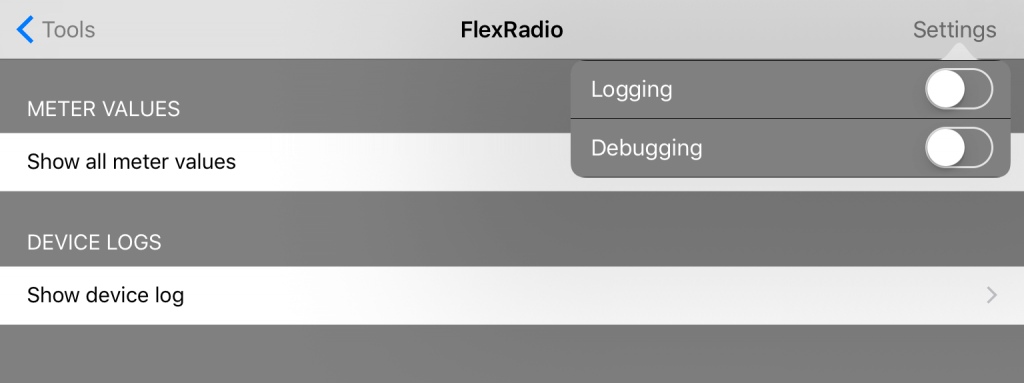
In addition, this tool offers two features that help to identify issues with or along with your FlexRadio.
The Show all meter values section provides values of all meters of your FlexRadio, not only those meters displayed in the main screen of this App but also Voltages, Power and Temperature value.
If turned on, the App will also log additional information which can be viewed and cleared using the Show device log menu.
3. MIDI Controller
Using the MIDI Controller Tool you can configure so called MIDI Controllers such as the DJ2GO2 or Behringer CMD Micro MIDI Controller for use with the Radio.

The following MIDI Controllers are supported:
Numark DJ2GO2
Behringer CMD Micro
Behringer CMD PL-1
Hercules DJ Controller Compact
Other controllers may work as well but they are not tested.
The MIDI Controller needs to be connected to your device using a USB Cable. You may need an Adapter to connect the controller supplied USB cable to your device (e.g. USB-A to USB-C or USB-A to Lightning). The DJ2GO2 doesn’t need extra power so a direct connection would be all you need. Other Controllers may need more power so you may need to use a powered USB Adapter. If you need a USB/Lightning Adapter, better use Apples original Adapter. For the iPad Pro and new iPad Mini with USB-C connector, no adapter might be needed.
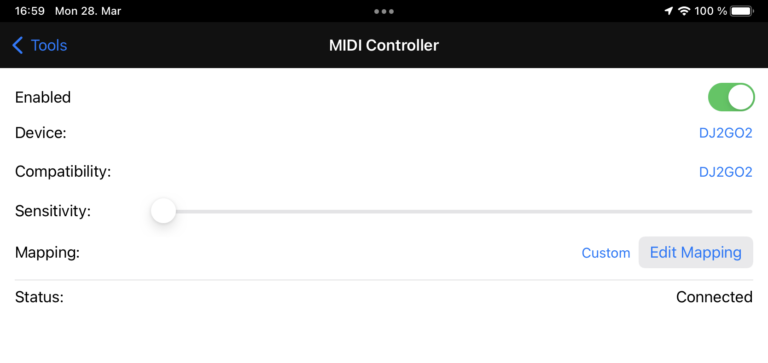
Once your MIDI controller is connected, you should be able select your Controller in the Device: selection.
If you then switch on the Enabled: switch, the Status should change to Connected as shown above.
To assign functions to each button, you need to open the Mapping Editor by tapping on Edit Mapping which is explained in the attachment under Mapping Editor .
4. CTR2 MIDI and Dial Controller
These two tools enable the use of the CTR2-MIDI and CTR2-Dial Controllers, which are available for purchase from Lynn Hansen, KU7Q at https://ctr2.lynovation.com.
The controller serves as an interface for the radio, allowing operators to tune frequencies, adjust volume, activate PTT, and access several other features.
Additionally, it provides the capability to connect a CW paddle to your device.
The CTR2-Controller offers the flexibility of wireless connectivity via Bluetooth-LE or a wired connection through a USB adapter.


To pair a CTR-MIDI with your device via Bluetooth, ensure that the controller is powered on and in proximity to your device. Then, launch the CTR2 Controller or CTR2-Dial tool and click the “Find Bluetooth-LE Device” button at the top. The CTR2 should be detected within a few seconds and appear in the Device list. If the initial attempt is unsuccessful, close the tool, reopen it, and try again. Once the controller is detected, you can select it from the Device list under the name CTR2_xxxx whereas xxxx is a unique identifier different for each controller.
If you are connecting the CTR2 via USB, it will be listed as XIAO_ESP32S3 for the CR2-MIDI or STAMP-S3 for the CTR2-Dial Controller in the Device list.
After selecting the appropriate device and toggling the Enabled switch on, the status should update to Connected.
The controller comes with default mappings that allow you to use the knob for tuning, volume adjustment, and more. You can view and modify these mappings to suit your specific needs by clicking the Edit Mapping button.
Should you wish to revert to the default mappings after making changes in the Mapping editor, simply delete all mappings, close the editor, and reopen it.
When a paddle is connected to the CTR2-MIDI, it is ready for immediate CW operation. To adjust CW and paddle settings, such as CW Speed, Iambic mode, or paddle swapping, open the CW Decoder Mode Tool and click the Options button in the TX section.
For additional information and a comprehensive manual, please visit Lynn’s website. Lynn has also predefined mappings available for the different Controller variants.
5. Flic
The Flic tool adds support for the so called Flic Smart Bluetooth Buttons (More information can be found on flic.io ).
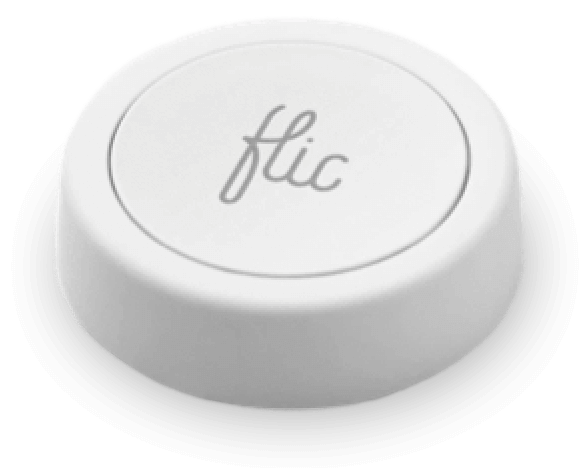
You can add as many buttons you like and can assign various Radio functions like PTT, Tune, Mute, CWX Macros for press and release, double click or hold.
After unlocking this tool and purchasing a Button, you need to register an account on flick.io and need to install the flick iOS App from the AppStore. Next Add your new Flic Button to the Flic App. If you have more than one Button, it is recommended to assign names for the Buttons (please see the Flic Manual for details).
No further action is required on the Flic App. You don’t have to assign actions from inside the Flic App unless you want to use the Button for other purposes than for SmartSDR for iOS.
Next, open the Flic tool of SmartSDR for iOS and switch on the Enabled setting.

Now, when pressing a Flic button (the physical button), the Button ID will appear in the list. You can also use the Scan button to add a new, unregistered Flic button.
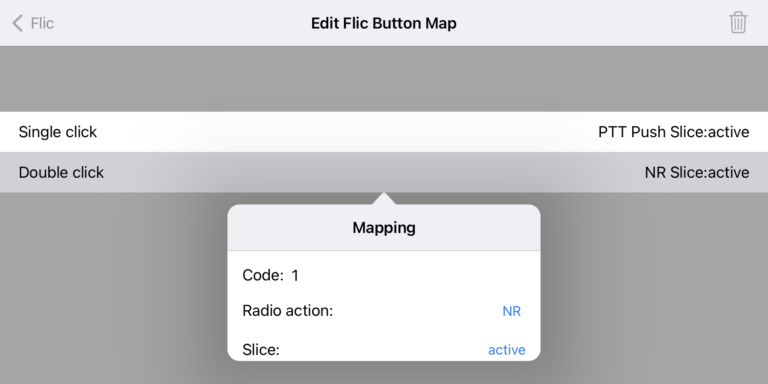
On this screen, you can assign Button mappings for the three Button options:
Single click (which has an Up and Down state)
Double click
Long press
Note
Double click and Long press will also always generate a Single click so in most cases, where you want to assign functions for Double click or long press, it makes no sense to also assign functions to single click.
If you want to remove an assignment, you can swipe the line left or just select “Not assigned”.
To delete the whole button, just tap on the wastebasket at the top of the screen.
Details about the possible Mappings are explained in the attachment under Mapping Editor .
7. Griffin PowerMate
This Tool allows to configure and use the so called “Griffin PowerMate Multi-Media Control Knob with Bluetooth Connectivity” for controlling the FlexRadio.

Attention
This button is no longer in production and even though several alternatives have been tested, there is no other button like this which can be integrated under iOS. With some luck you may be able to get this button on eBay
This Controller has no cable and will be connected via Bluetooth LE to your iPhone or iPad.
Hint
So don’t forget to turn on Bluetooth on your device.
Note
Only the the Bluetooth LE variant of the PowerMate is supported. Not the USB variant.
This Controller has one Wheel, one Button (pressing the Wheel) and an LED. All three can be configured individually by using the “Edit Mapping” function, but to get started, first select “PowerMate default” as Mapping.

Now, you can switch “Enabled” to on. The first time, you may get the message “Turn on Bluetooth to Allow “SmartSDR” to connect to your Accessories”.
Next, under Status, you will see “Connecting…“. Now, you need to tap once on your PowerMate and the Status should change from “Connecting…” to “Connected”.
With the “PowerMate default” Mapping, the PowerMate is configured to to use the Wheel for tuning the Active Slice frequency and the Button will toggle TX. The LED will indicate the MOX status.
To alter this default Mapping, just tap on “Edit Mapping” and the Mapping Editor will be opened. The Mapping editor is explained in the attachment under Mapping Editor .
8. HomeKit
This App supports HomeKit to control peripherals in your Shack such as Antenna Switches, PAs or even power up FlexRadio remotely.
There is a wide range of different HomeKit devices (so called accessories) available. All accessories that can either be switched, powered-on or even dimmed are supported by this App. For instance, you can use a HomeKit compatible power outlet for switching your FlexRadio on and off.
More about HomeKit can be found on Apples HomeKit website.
Before using HomeKit accessories from inside the App, they need to be registered and available from Apple’s HomeKit App.
The way how SmartSDR for iOS supports such HomeKit Accessories is to allow you to select the accessories you like to use from inside the App and then, SmartSDR for iOS offers a Home Icon at the top of the Panadapter screen which can be used to access these accessories conveniently to turn them on or off.
Given you already have HomeKit and your accessories readily setup, just start the HomeKit Tool of SmartSDR for iOS.
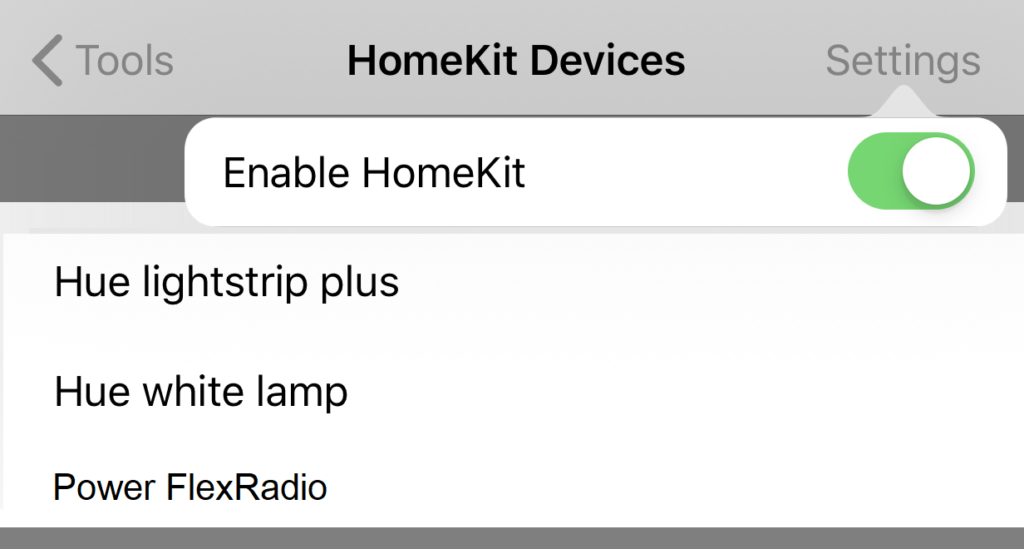
After selecting “Enable HomeKit” using the Settings menu at the top right corner, you should see all available HomeKit accessories in the list.
If that’s not the case immediately, just wait a few seconds or pull the list to refresh it.
Once you see the list, you just need to tap on the accessories you like to use from inside the App. A selected accessory will show a check-mark on the right side. Tapping again will remove the check-mark.
Once that’s done, you can jump to the Panadapter (lower left tab) and use the View → HomeKit Menu to show and toggle the selected HomeKit components.

Note
SmartLink is not necessary for HomeKit. You can access any HomeKitdevice without previously connecting to your Radio via SmartLink (or VPN). This way, you can even power on your Radio before you can connect to it using SmartLink. If connected via Cell, HomeKit may initially respond a bit slow for the first attempt. It may also show a wrong or undetermined status (on or off) of your accessory.
9. Command Bar
The Command Bar feature is designed to maintain buttons that can be displayed on the Waterfall Main Screen. These buttons can open websites, start other apps, or send CAT commands to the radio. It is also possible to use keyboard shortcuts for start these commands.
The feature consists of two parts: the screen where you maintain the buttons which can be opened from the Tools screen.

And the screen where the buttons are displayed.

To maintain a button, you can enter a Title, select a Type such as Start App, Open Website, or Send CAT Command. Depending on the type, you must enter a parameter which represents the app name, the website URL, or the CAT command.
The Title will be displayed on the Command Bar when shown on the Waterfall. You can leave the Title blank, in which case the button will not appear on the Command Bar, although it’s still possible to use keyboard shortcuts to start it.
To start apps, you need to enter the so called URL-Scheme for the app. For Apple’s Mail app the urlscheme is mail, for the Maps app it is maps. The most useful URL-Scheme on iOS is schortcuts://run-shortcut?name=<Name of the Shortcut>&<parameter> which can be used to start a Shortcut on your device. For this, replace <Name of the Shortcut>> by the title of the Shortcut. If the title contains spaces, replace a space by %20. Replace <parameter> by a possible parameter of your Shortcut. If the shortcut doesn’t require a parameter, just leave it out but keep the & character.
Other apps you have downloaded from the App Store may offer additional URL-Schemes.
The commands to enter for the Send CAT Command type depend on the radio you are using. Please refer to the radio’s programmer’s reference documentation to learn which commands can be used.
10. Ultra Beam
This feature is designed to control Ultra Beam Antennas. For more information on the different models and specifications, visit WiMo’s Ultra Beam page https://go-to.me/ultrabeam.
The Ultra Beam is often regarded as a more robust and dependable European alternative to the Stepp-IR.
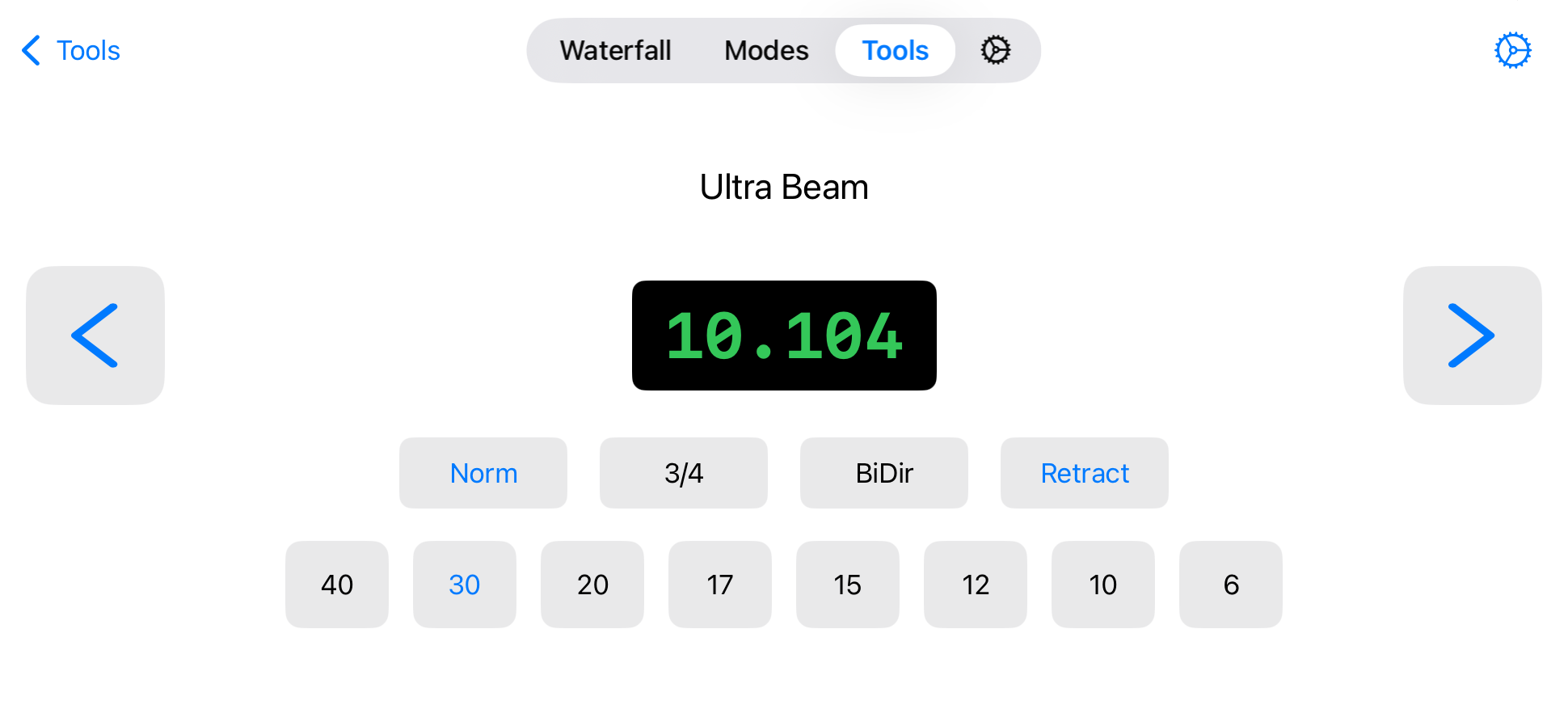
10.1. Requirements
To utilize this feature, you need an Ultra Beam RCU-06 Control Unit and the UltraBeam Remote Controller software installed on a Raspberry Pi.
To set up this tool, hit the settings icon at the top of the interface.
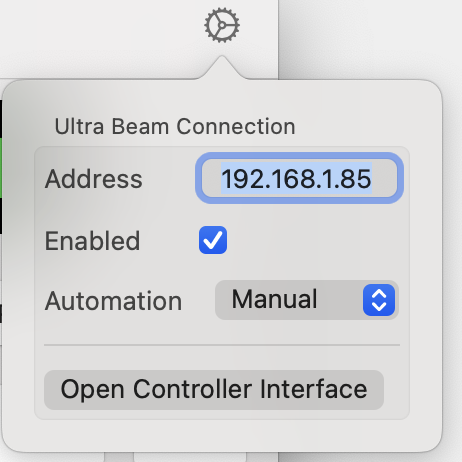
Here, input the IP address of your UltraBeam Remote Controller (the Raspberry Pi).
To test the IP Address, click the Open Controller Interface button to access the Controller’s web interface.
The ‘Automation’ section offers three options: ‘Manual’ allows you to control the frequency of your Ultra Beam directly from the main Tool screen. ‘Follow RX’ or ‘Follow TX’ will automatically adjust the frequency based on the current RX or TX frequency, respectively.
To control the frequency on the main Tool screen, simply hit one of the Band buttons or hit the frequency display at the center to manually enter a frequency. You can also adjust the frequency in 5 kHz increments by hitting the buttons to the left and right of the frequency display.
You can also remote-access your Ultra Beam over the internet. To do this, open port 80 on your router for the IP address of your Ultra Beam Controller. It is recommended to use a different port than 80 externally, for example, 20001. In this tool, you would then need to enter your public IP address (or a DynDNS name - see the chapter Remote Access for more details) followed by a colon and the port number (20001 in the example).
Note
No CAT cable or CAT connection to the Ultra Beam Controller is required for this tool to function. You can switch radios and still be able to adjust the frequency for the radio you are currently connected to.
For further details, please refer to the Ultra Beam manuals.
11. S.A.T. Controller
This feature enables you to operate satellites using the S.A.T. Controller from CSN Technologies directly within the app.
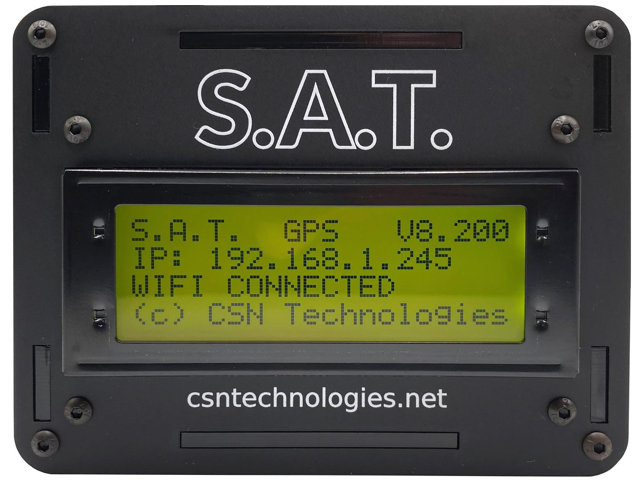
For more information about this product, visit http://csntechnologies.net/sat
The S.A.T. device is a compact unit that connects to your antenna rotator for elevation and azimuth control, simplifying satellite operations. It features a network interface used by the app and an integrated web interface, eliminating the need for additional cables like a CAT cable.
11.1. Prerequisites / Requirements
Before using the S.A.T. tool, ensure you have:
A S.A.T. device
A compatible rotator, such as the G5500, connected to the S.A.T. device via a cable
The rotator should control your SAT antennas, which are connected to your radio
The S.A.T. device should be set up and operational as described in its user manual. You can skip the section about connecting a CAT cable to the radio, as this is managed by the app and this tool.
Once these prerequisites are met, launch the S.A.T. tool in the app and tap the gear icon to access the settings. Here, you will need to enter the IP address of the S.A.T. device, displayed on its small screen.
Next, press the Enable button. It may take a few seconds for the message “no SAT selected” to appear in the lower status bar of the tool. If the connection fails, perhaps due to an incorrect IP address, an error message will display instead.
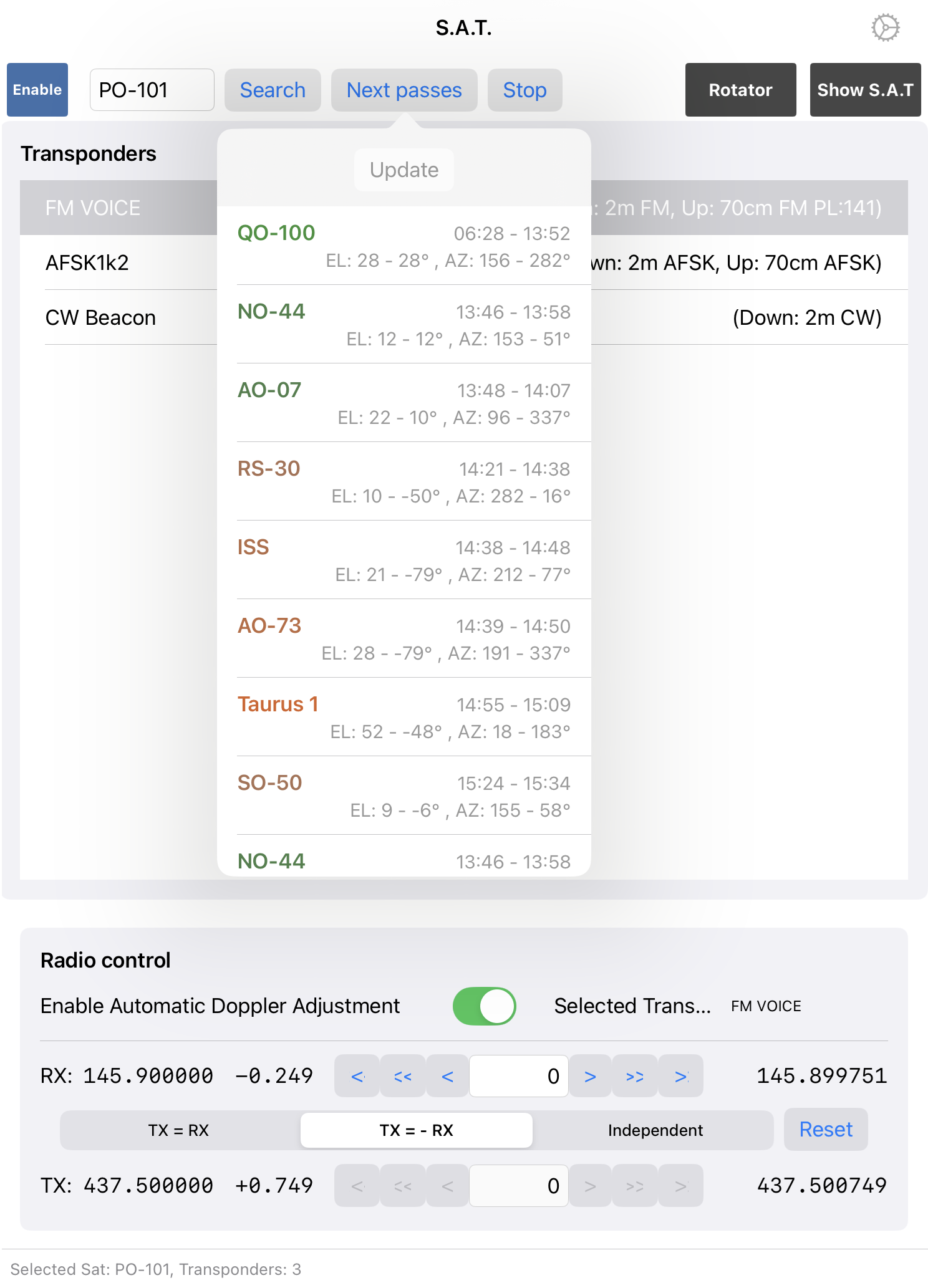
11.2. Operating a Satellite
To operate a satellite, tap the “Next Passes” button at the top. You will see a list of satellites currently passing over your location. The color coding indicates the ease or likelihood of establishing a connection. Select a satellite from this list, and the S.A.T. controller will adjust the antenna to point towards it.
After selecting a satellite, a list of its transponders will appear. Choose the desired transponder. Below, the downlink (RX) and uplink (TX) frequencies, including the Doppler-adjusted frequencies, will be displayed.
Once connected to your radio, you can enable the “Enable automatic Doppler Adjustment” setting, and the radio will automatically adjust its RX and TX frequencies based on the satellite’s location and whether it is approaching or moving away from your position. Simultaneously, the S.A.T. device will adjust the antenna’s elevation and azimuth to maintain alignment with the satellite.
To adjust an additional offset for RX and TX, simply click the arrow buttons located to the left or right of the entry field for manually entering an offset. You can set different offsets for RX and TX, or choose either TX = RX or TX = -RX (which is the most common scenario).
The RX and TX offset can also conveniently adjusted using one of the supported Controller such as the CTR2.
For the radio, consider the following settings:
To operate on bands like 2m or 70cm (except for the Flex-6700 with 2m), you will need a transverter. Set up your transverter and label it as ‘2m’ for the 2m band and ‘70cm’ for the 70cm band, respectively. Make sure you can manually tune to the corresponding frequencies on these bands.
Note
Doppler correction always applies to the currently active Slice for the Downlink and to the TX Slice for the Uplink. Therefore, if you switch Slices, ensure that the active Slice is the one you wish to receive on, and the TX Slice is the one you intend to use for transmitting on the Uplink.
Satellites typically operate on different frequencies for the Downlink and Uplink. Hence, you need to create two Slices: one for RX (the active Slice) and one for TX (the TX Slice).
If the satellite operates even on different bands (e.g., 2m for the Downlink and 70cm for the Uplink), these two slices should be on different Panadapters, each set to the appropriate band.
Note
You can always hit the Stop button at the top to halt the S.A.T. device from moving the antenna rotator and tracking a satellite.
You can also enter the name of a satellite and tap the Search button to look for a specific satellite.
11.3. Hints for Operating in FT4
Operating in FT4 is achievable using the S.A.T. tool with doppler correction, alongside the included FT8 Tool in the app. This setup is effective even when the Uplink and Downlink are on different bands and utilize different modes (e.g., 70cm USB for Downlink and 2m LSB for Uplink). To ensure smooth operation, follow the steps outlined above and confirm that the RX and TX frequencies are correctly set. Have the two separate Slices on two separate Panadapters as described above.
Open the FT8 Tool and switch the band selection to Manual. Then, select the desired mode (e.g., FT4) and press RX. At this point, the modes for RX and TX will switch to DIGU/DIGL, allowing you to operate in FT4 as usual. The radio will automatically switch to the appropriate panadapter when toggling between RX and TX.
If you encounter incorrect frequency changes, ensure that the intended Slice for transmitting is still set as the TX slice (indicated by a red TX icon in the Slice flag), and confirm that the other Slice in a different Panadapter remains the active Slice (highlighted by a yellow line). If a single Slice is designated as both the active and TX slice, the frequencies cannot be set independently.
11.4. Manual Rotator Control
If you wish to manually adjust the satellite’s position, move to a specific satellite manually, or simply use the S.A.T. device as a basic rotator controller, tap the Rotator button to open the manual rotator control interface in the app.
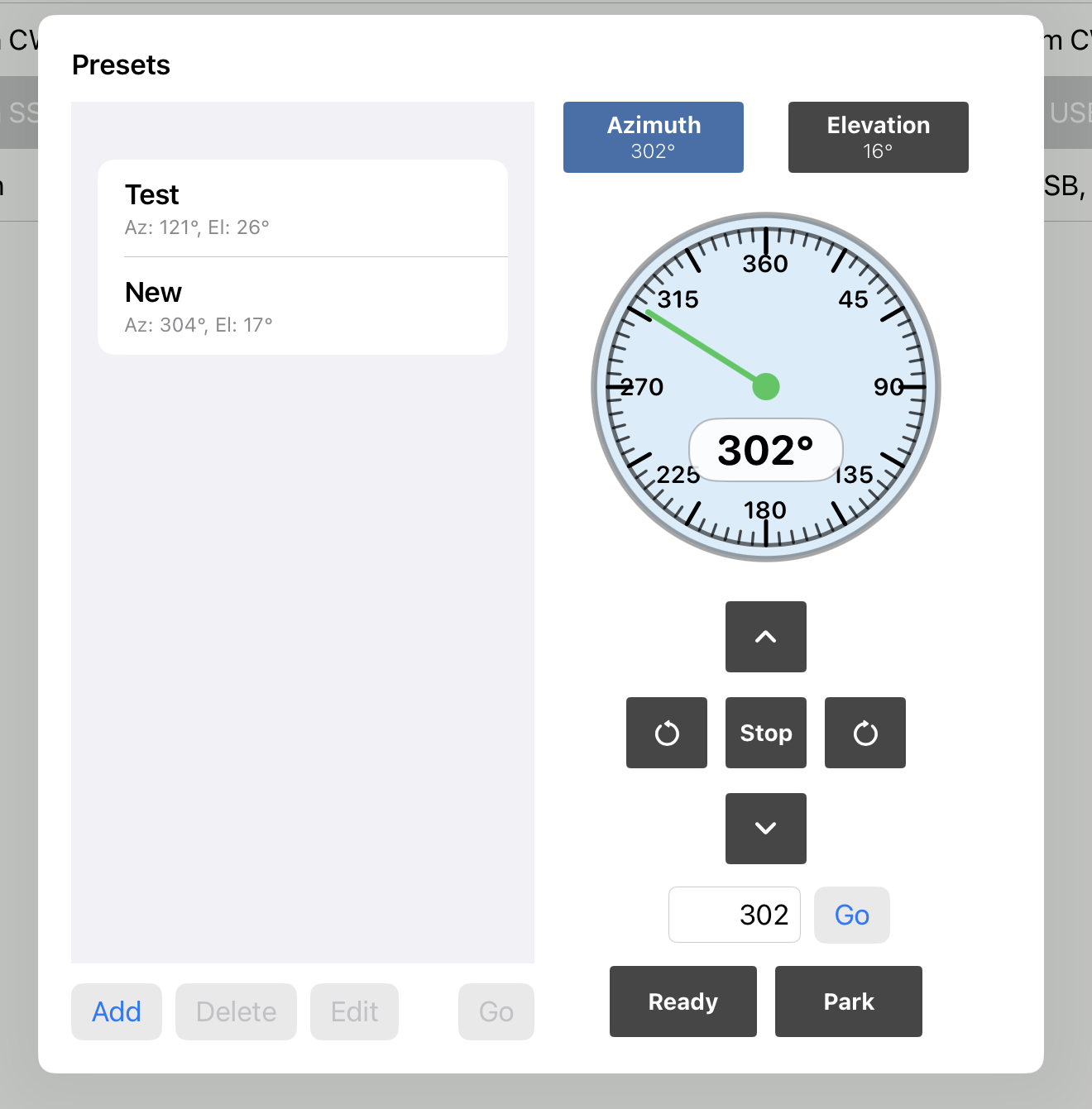
From here, you can direct the rotator to move in any direction using the directional buttons or move to a specific elevation or azimuth angle. Additionally, you can store and recall favorite positions on the left side of this screen.
The Ready and Park buttons will move the antennas to the corresponding locations stored in the S.A.T. device.
11.5. S.A.T. Web Interface
The Show S.A.T. button at the top will open the S.A.T. device’s web interface.
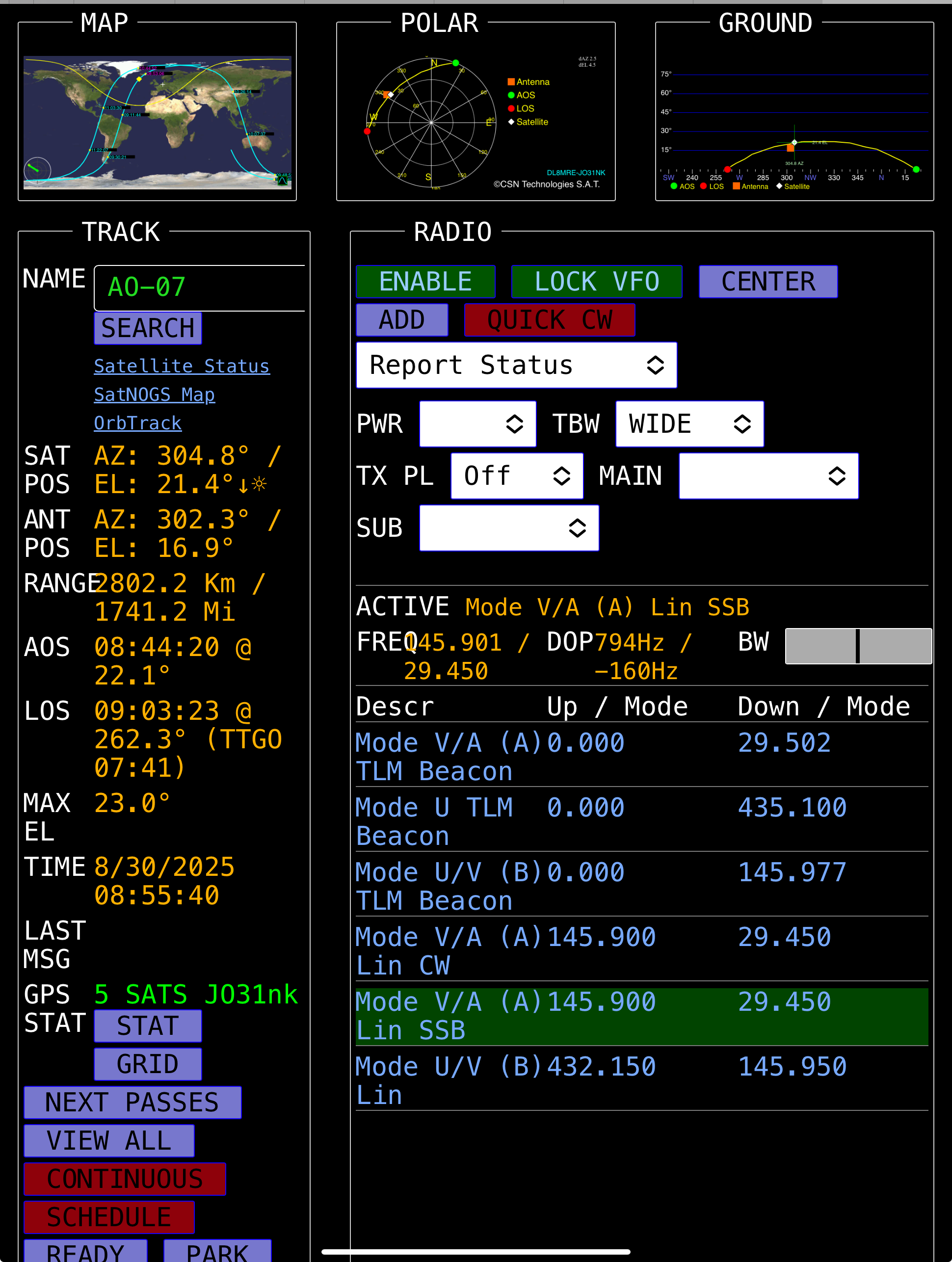
11.6. Logging a SAT QSO
When logging a QSO, the app automatically adds three additional fields for SAT operation: SAT Name, SAT Mode, and Prop Mode.
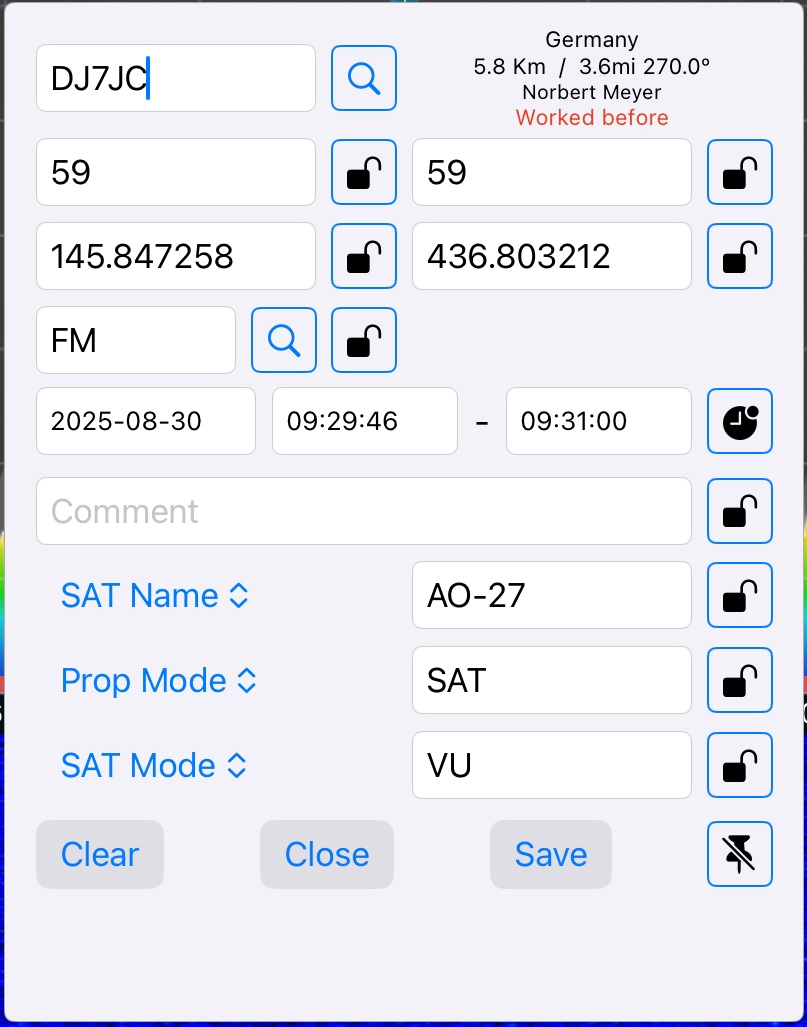
11.7. Remote access
Accessing the S.A.T. device within your local network poses no issues. However, accessing the S.A.T. over the internet requires a VPN, as the internal server of the S.A.T. device needs to be accessible. This cannot be securely achieved by merely opening a port or via SmartLink. Therefore, if you wish to access the S.A.T. device over the internet, you must set up a VPN and ensuring that your S.A.T. device is reachable from a remote location with the same IP address as if you were at home.
12. Network Stats
This Tool can help to analyze network issues.
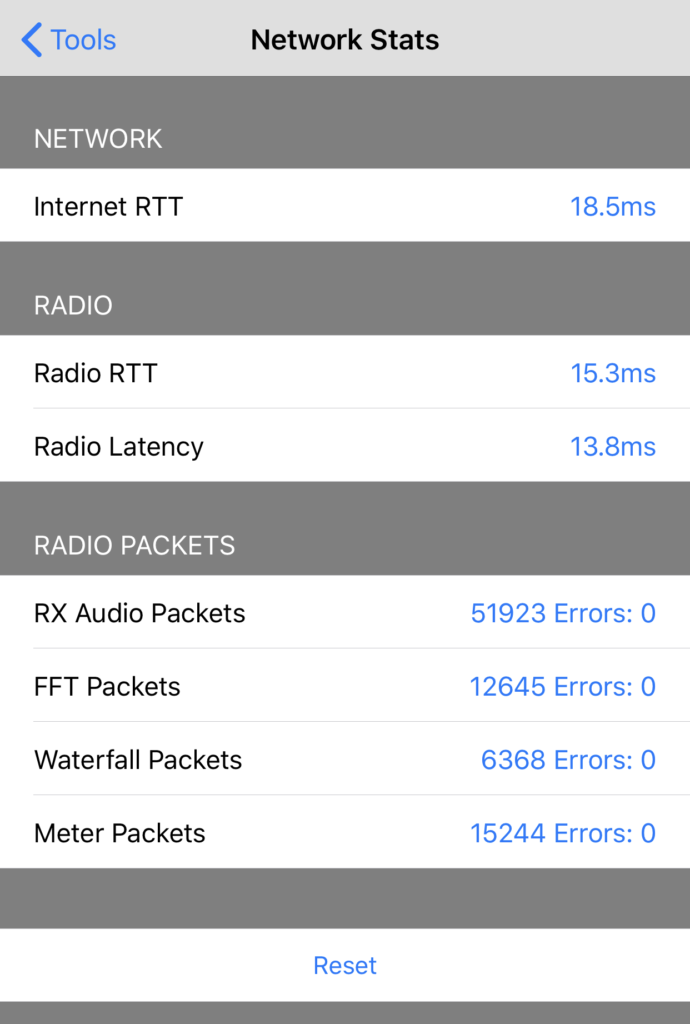
It displays information about the network traffic from and to your Radio.
Internet RTT is the Round-Trip-Time (the time to the server and back) to a server on the Internet. This value should be lower than 30 – 50ms. Higher values indicate general issues with your network connection. However, this value is only important for Call Lookups or other activities over the internet.
Higher values indicate general issues with your network connection.
Radio RTT is the Round-Trip-Time to your Transceiver. These should be below 20ms on local networks. However, this value should always be lower or at least equal than the Internet RTT. If this value is significantly higher (e.g. 1.5 or twice as high as your Internet RTT) there are issues with your local network (e.g. wrong LAN Cables or wrong FullDuplex/HalfDuplex network settings etc.)
The Radio Latency is the time your Radio answers to Commands. This value should be similar to the Radio RTT. If this value is significantly higher (e.g. 1.5 or twice as high as your Radio RTT) your Radio is responding very slow and you may want to try to Power Cycle your Radio.
The Radio Packets section shows the number of packets received for certain packet types along with the Error count and percentage.
If the number of Packets remains zero even after you are connected (and even when there are reasonable RTT and Latency values), there will be issues with the Radio UDP communication.
A certain Error percentage (1-5%) is normal and usually covered by the automatic error correction and often not even noticeable. Errors may even temporary happen if the device is too busy (e.g. while temporary switching to another App). However, continuous Errors might be an indication of network issues (either Cell when using SmartLink or and/or on your local network).
The Reset button can be used to set the error counter to zero which is useful to see if there are any changes after changing some settings.
In case of Network issues, please consult the Common Issues section in the SmartSDR for iOS Manual.
13. Genius Devices
FlexRadio and 4O3A are offering several network controlled accessories such as the Power Genius XL (PGXL), Tuner Genius (TGXL), Antenna Genius (AGXL) and Rotator Genius (RGXL) which can also be maintained from within the App.
Note
This feature is only available for iPads
Attention
This App requires the following Firmware versions for correct operation: PGXL: 3.6.x or 3.7.x, TGXL: 1.1.x, AGXL: 3.1.x or 4.1.x and RGXL: 1.5.x
Each Genius device needs to be added to the Genius Devices list. To add a device, use the (+) button.
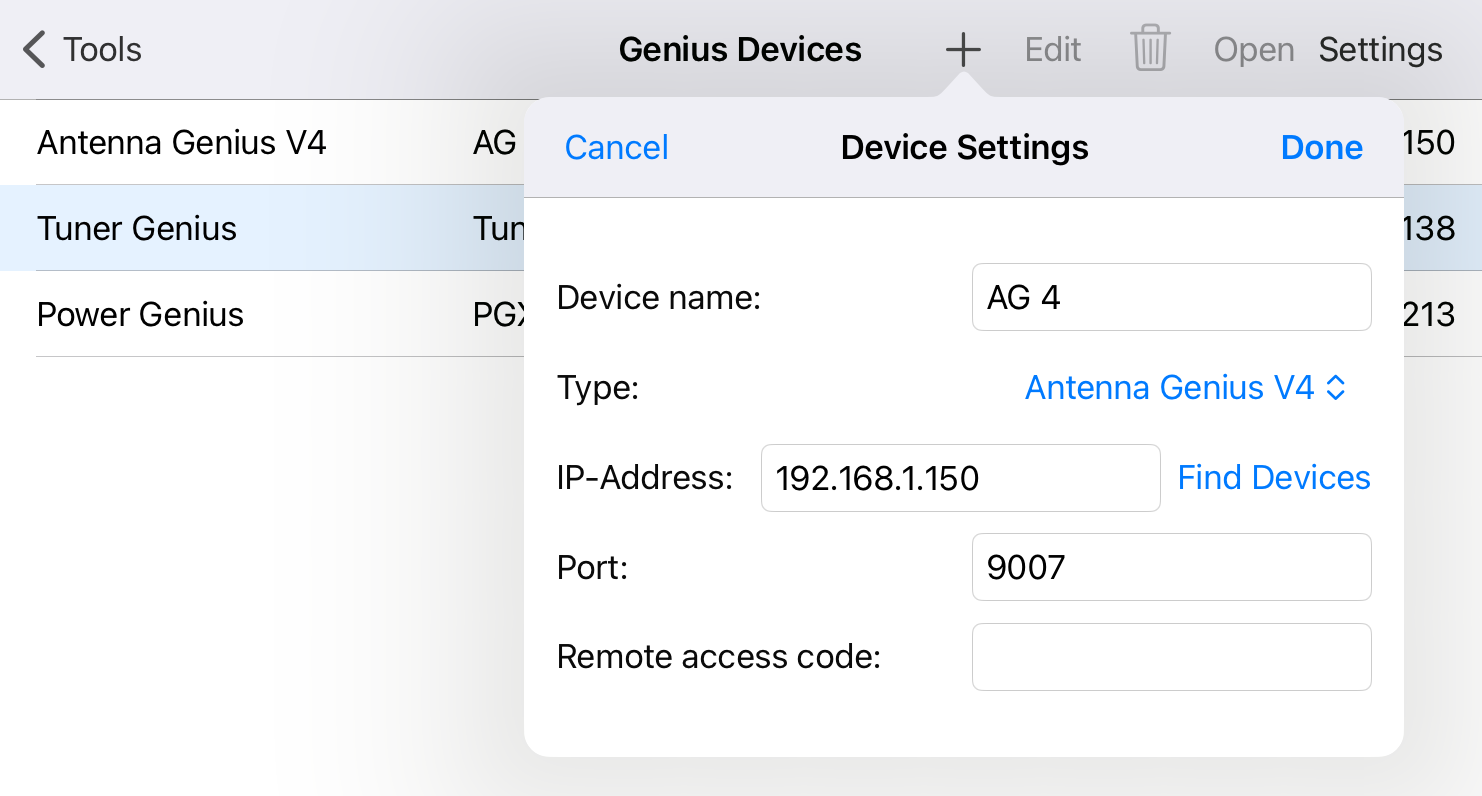
For each device you can enter a name, select the type and enter the IP Address. The port will be pre-filled once a type is selected. The Remote access code will be needed when connecting to your device remotely (see separate chapter further below).
For convenience and if the device you like to add is on your local network, you can leave all fields empty and hit the Find Device button to try to discover it. Once it has been found, you can select it from the list and most of the information will be filled out automatically.
If the device can not be discovered or if the device is not on your local network and should be added for remote access, you need to enter this information manually.
Note
For an TGXL, check or uncheck the “Is 3-Antenna Device” depending on whether or not you are using a SO2R version.
Attention
Your router may assign a new, different IP Address to your devices on your local network after some while. So when entering an IP Address to one of your Genius devices here, it may work for a while but fail at a later time when your router changes the IP Address. Most router have the possibility to force that from not happening. Sometimes this feature is called Static Lease or Always use this / the same IP Address.
By double-tapping on a device in the list or selecting a device and clicking the open button, the App will connect to the device and open the device control screen.
13.1. Settings
The Open Device on Panadapter setting will open the genius control screens on the Panadapter tab instead of this tools tab.
13.2. The PGXL control screen
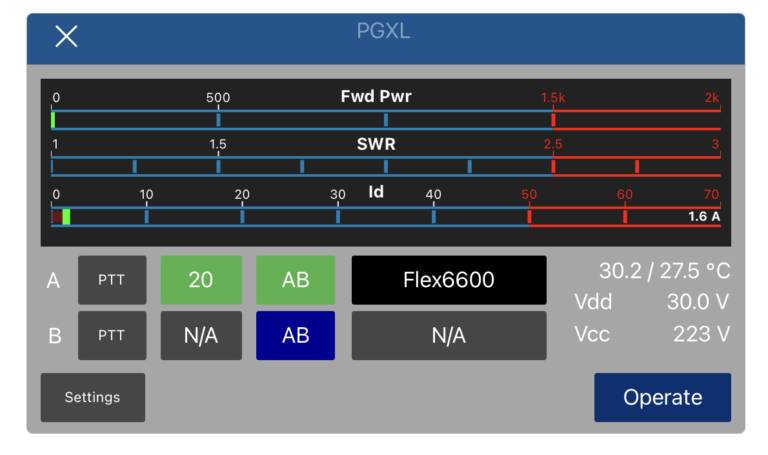
From here, you can monitor the operation of the PGXL and change the PGXL settings.

In order to use the PGXL along with your FlexRadio you need to pair one or both ports with your Radio. For this, you need to be connected to your PGXL and your Radio locally and click the “Pair with Radio” button.
Note
If you are using PGXL firmware 3.7. an remote access code is required when connecting the PGXL from outside your home network. This code can be entered here as well on the device information screen for connecting to the PGXL.
13.3. The TGXL control screen
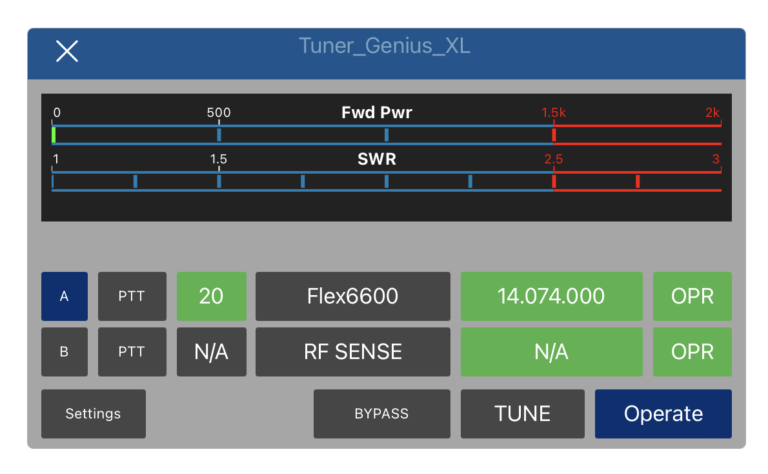
The TGXL control view has a similar layout like the PGXL control view and offers buttons for Tuning or setting the Tuner on Bypass.

Also the TGXL settings screen looks similar to the PGXL settings screen. Also pairing the Radio with the TGXL works the same way by using the “Pair with Radio” button.
13.4. AGXL Control Screen
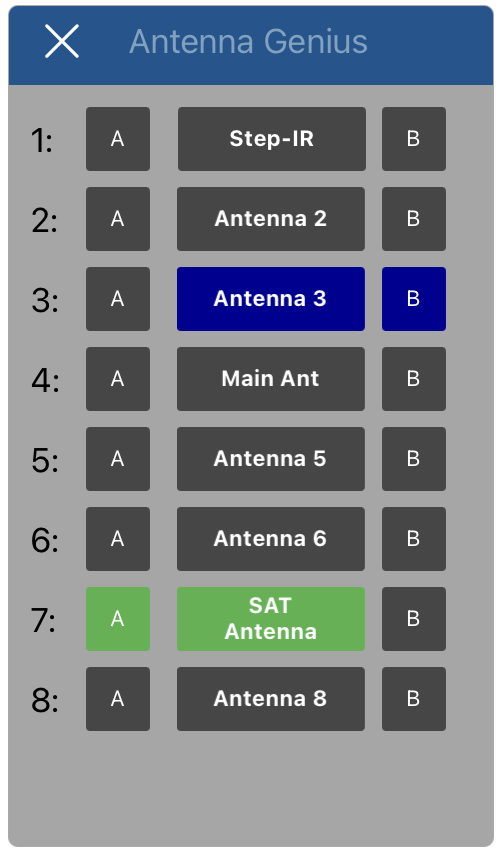
From here, you can assign port A or port B to one of the eight Antenna sockets of the AGXL.
13.5. RGXL Control Screen
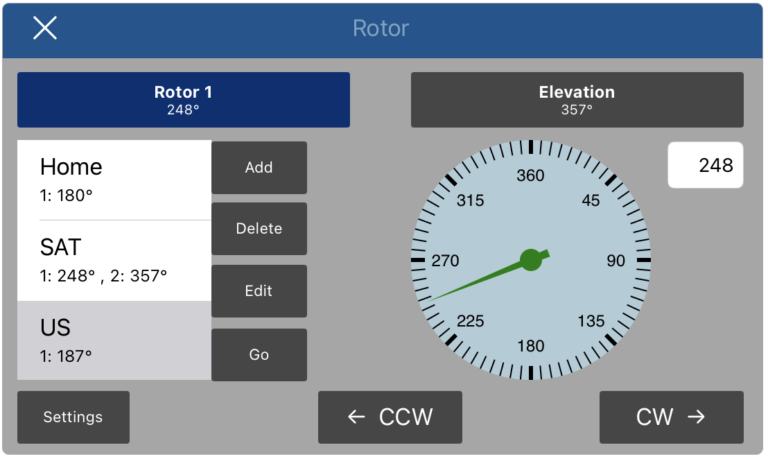
From here you can enter a certain rotor direction or rotate the rotor counter-clockwise or clockwise. On the left you can add presets for quick rotation to certain directions. Different to the Windows App, you can also enter predefined directions of a single, both together or both rotors individually if you have more than one rotor.
Hitting Settings will open the settings for the currently selected rotor where you can rename it and change limits and offset.
Different to the Windows App, you can also change the Rotor mode to Elevation.
13.6. Genius Device remote access
Genius devices can not automatically be connected when using SmartLink. However, they can be accessed over the internet if you would open the corresponding ports in your router for each device and either have a static Public IP Address or use services like ddns.org to generate a unique (not changing) address to your router’s (changing) public IP Address.
In order to enable a Genius device for remote access, just add another entry to the list by hitting the + button.
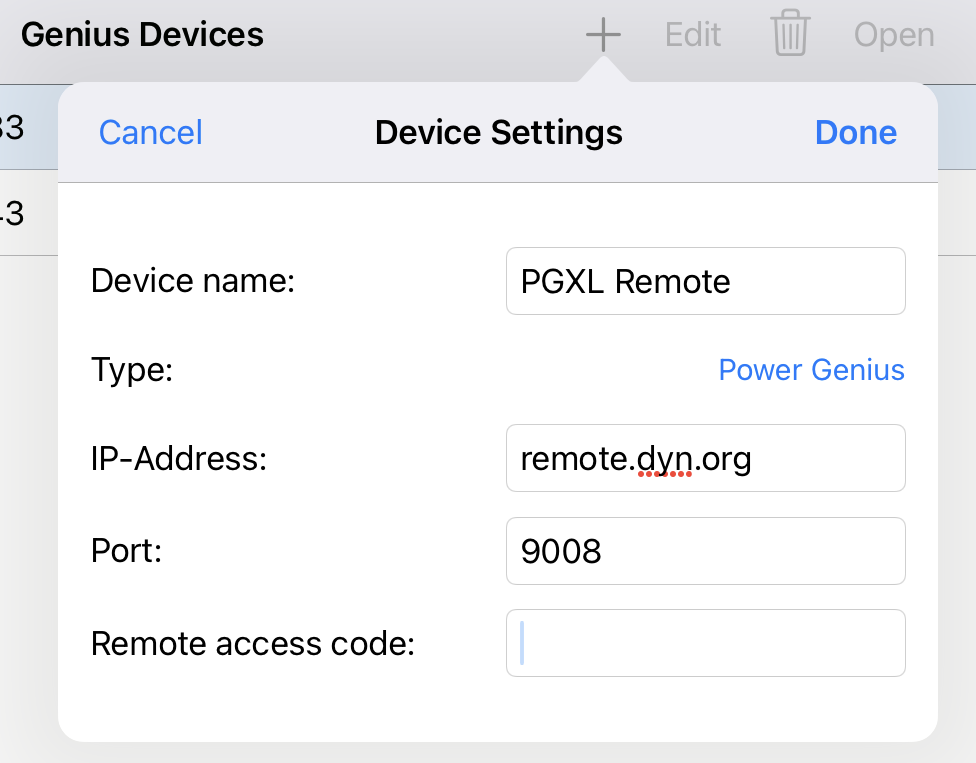
Similar to adding the device for local access where you have entered the local device IP Address, you have now to enter either your static public IP Address or your ddns.org (or similar) address instead.
So you will finally have two entries for each device. One entry which needs to be used when connecting the device local, the other for remote access of the device.
What you need to do in addition, before you can remote access o your Genius device is to open one port for each device.
The following table shows the ports to be used for each device:
Port |
Device |
|---|---|
9008 |
PGXL |
9010 |
TGXL |
9006 |
RGXL |
9007 |
AGXL |
These ports need to be opened only for the TCP protocol.
Finally, for the TGXL and PGXL, a security code is required to prevent unauthorized access.
You first need to enter this code under Settings of the Device control Screen. Second, the same code needs to be entered for accessing the device from the device list.
14. Band Plan
The Band Plan tool provides a frequency overview of all HF HAM Bands for your particular region as well as the modes and maximum bandwidth as suggested by the IARU.
Note
You need to select your particular IARU region under the App Settings in order to see the correct Band Plan for your region.
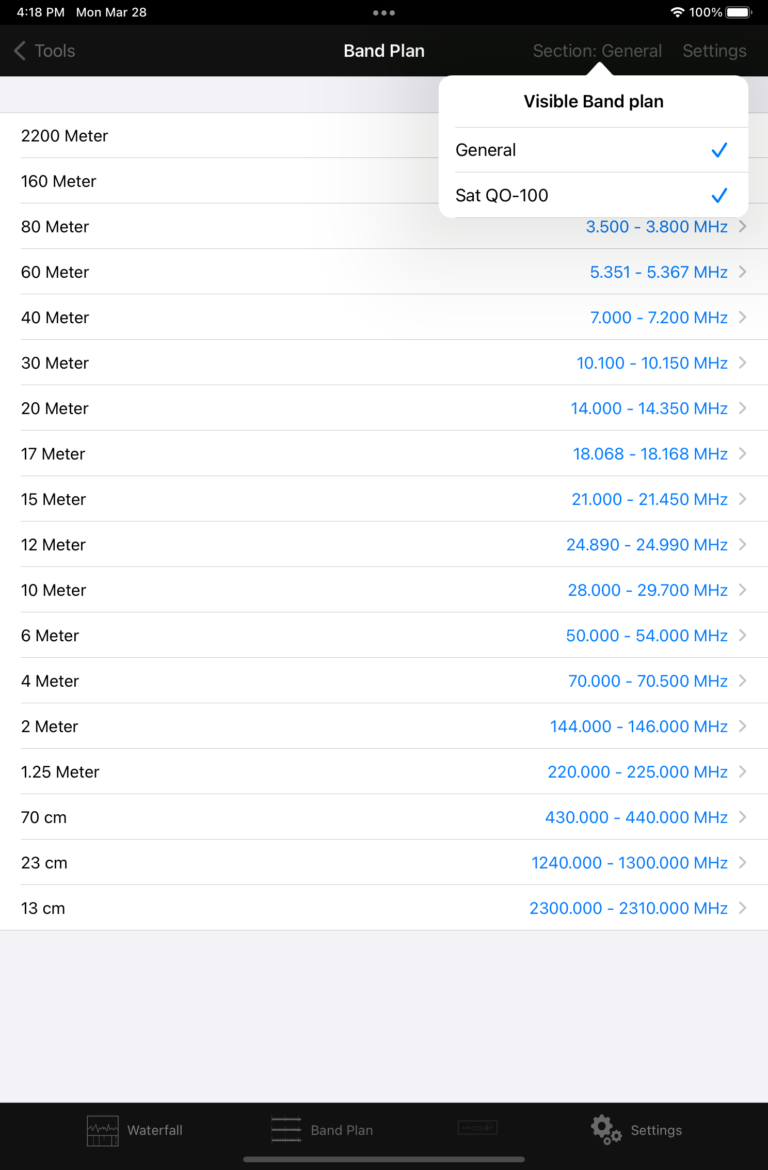
At the top, you can select if you like to see the General or QO-100 Sat Band Plan, which is also included.
If you tap on a band, you can see more details for the selected band.
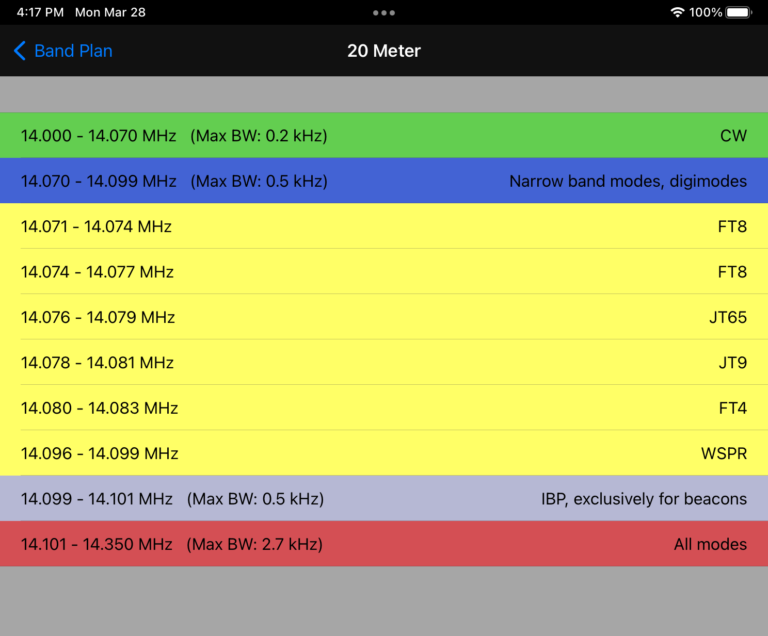
If enabled under Settings, the Band limits and modes will be visible within the Waterfall as seen below:

The “10 Meter >” information represents the Band limits information and the colored line represent the various modes like CW (green), Digimodes (blue), Narrow modes (Cyan), All modes (red), Satellite (yellow), others such as Beacons or guard channels (gray).
15. Call lookup
The Call lookup Tool can be used to learn more about a certain call-sign.
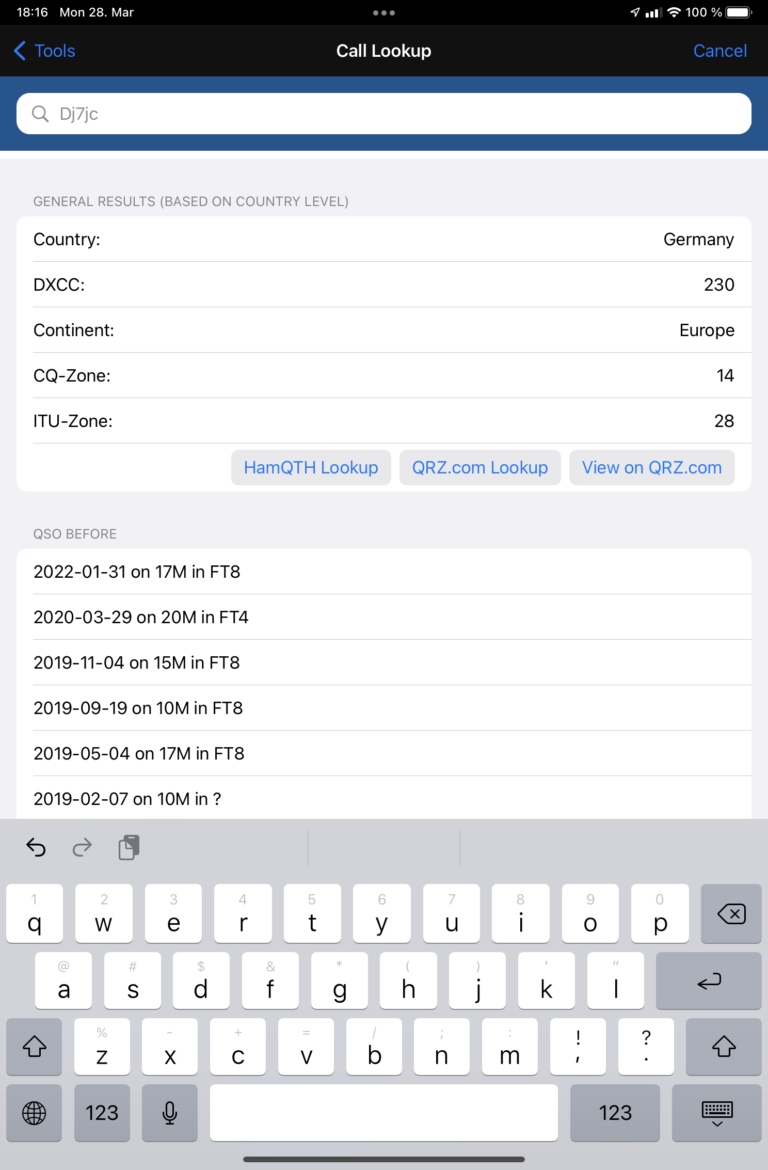
After entering the Call-sign in the top entry field, Basic information like Country, DXCC, CQ- and ITU-Zone will be displayed immediately. This information comes from an internal Database of the App which will be updated from time to time.
Note
This information is only accurate down to a country level. The location within a country will always be the location of the capital city of the country.
Further below you will get a list of previous QSOs to the entered Call-sign.
For more accurate and detailed information like the name, exact location or even Email address, you can use one of the integrated call lookup services like HamQTH or QRZ.com. If you have an account on one or both of these services, please enter your account information in the App Settings. In that case, you can use the HamQTH or QRZ.com lookup buttons for best results and most convenient display. If you don’t have accounts for these services, you can at least use the View on QRZ.com button which will show the QRZ.com website for the particular call-sign.
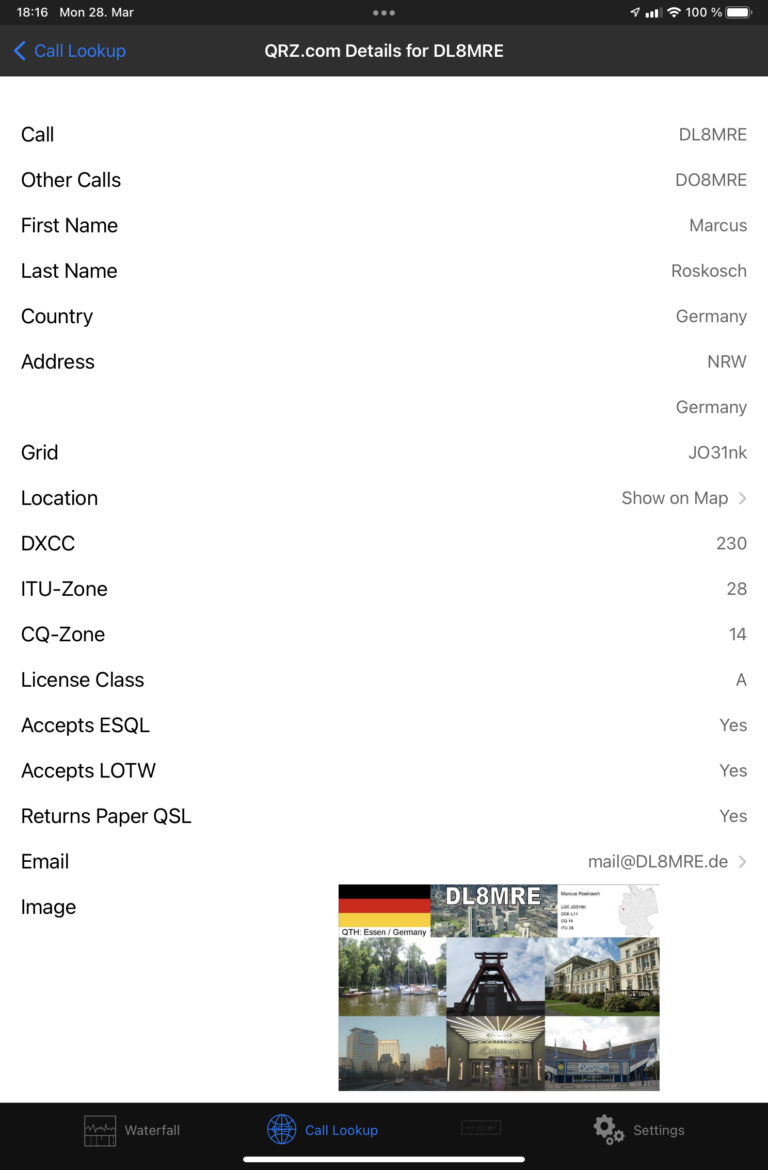
Once you have used the call lookup using HamQTH or QRZ.com, the results in the upper part will be updated.
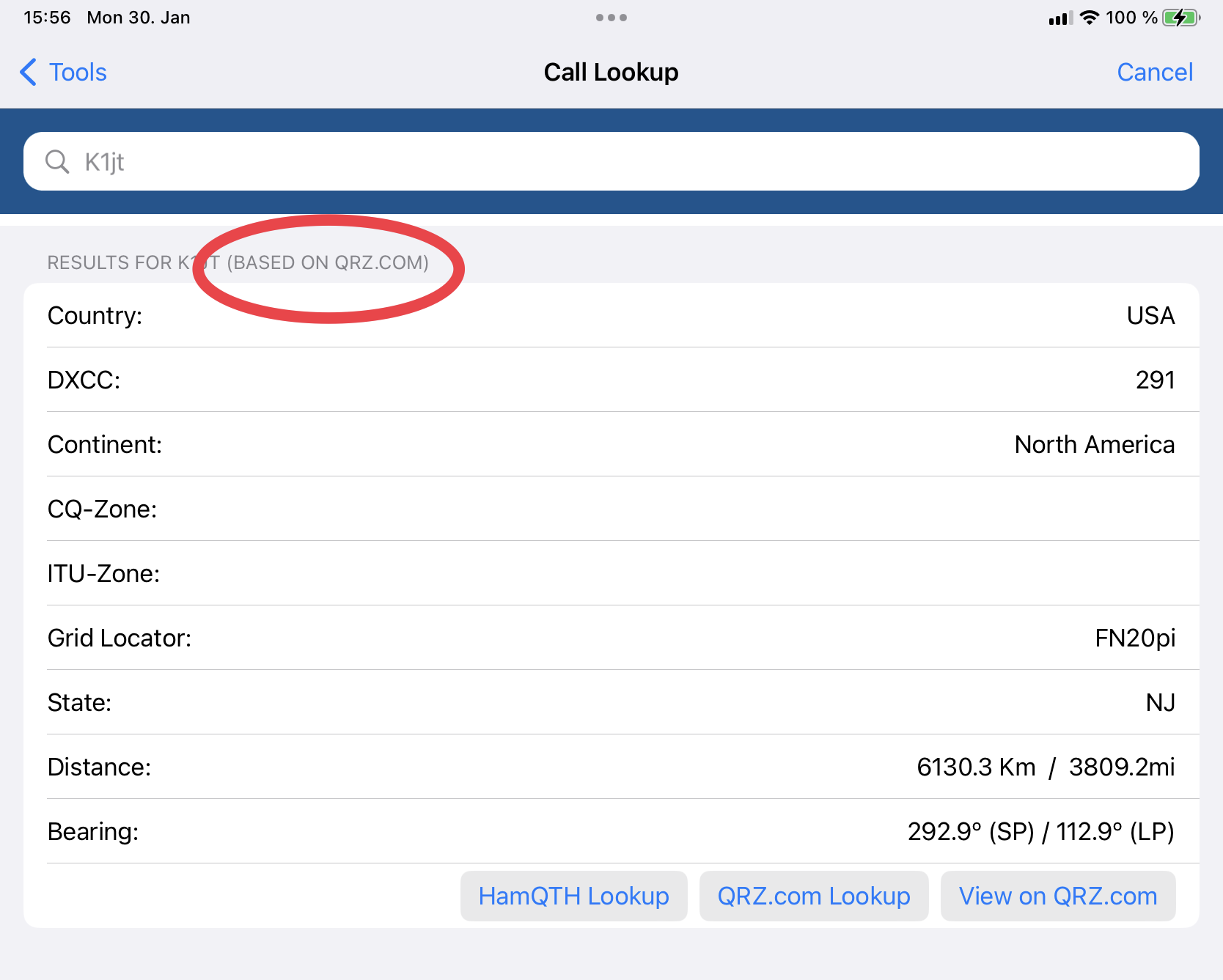
This also includes Distance and Bearing.
16. DX-Cluster
The DX-Cluster Tool connects to any of several pre-defined worldwide DX-Cluster Databases or even your local CW-Skimmer and displays results (Spots) directly on the Waterfall or let’s you directly jump to the frequency of a particular Spot by just tapping on an entry in the list.
After starting the DX-Cluster Tool, you need to click on Start to start querying the selected DX-Cluster server.
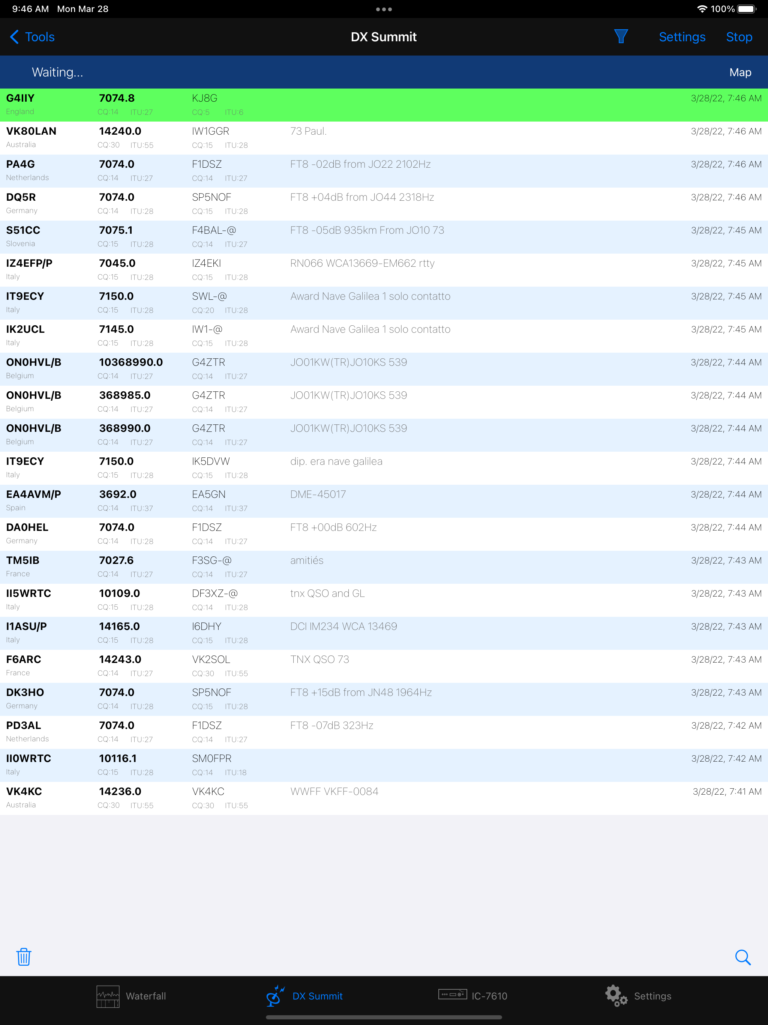
If you double-tap on a line in this list, the Transceiver will tune to the particular frequency of this spot.
If you single-tap a line, you will see more details about the Spotter and Call.
Tapping on the Filter Icon at the top will show the various Filter options:
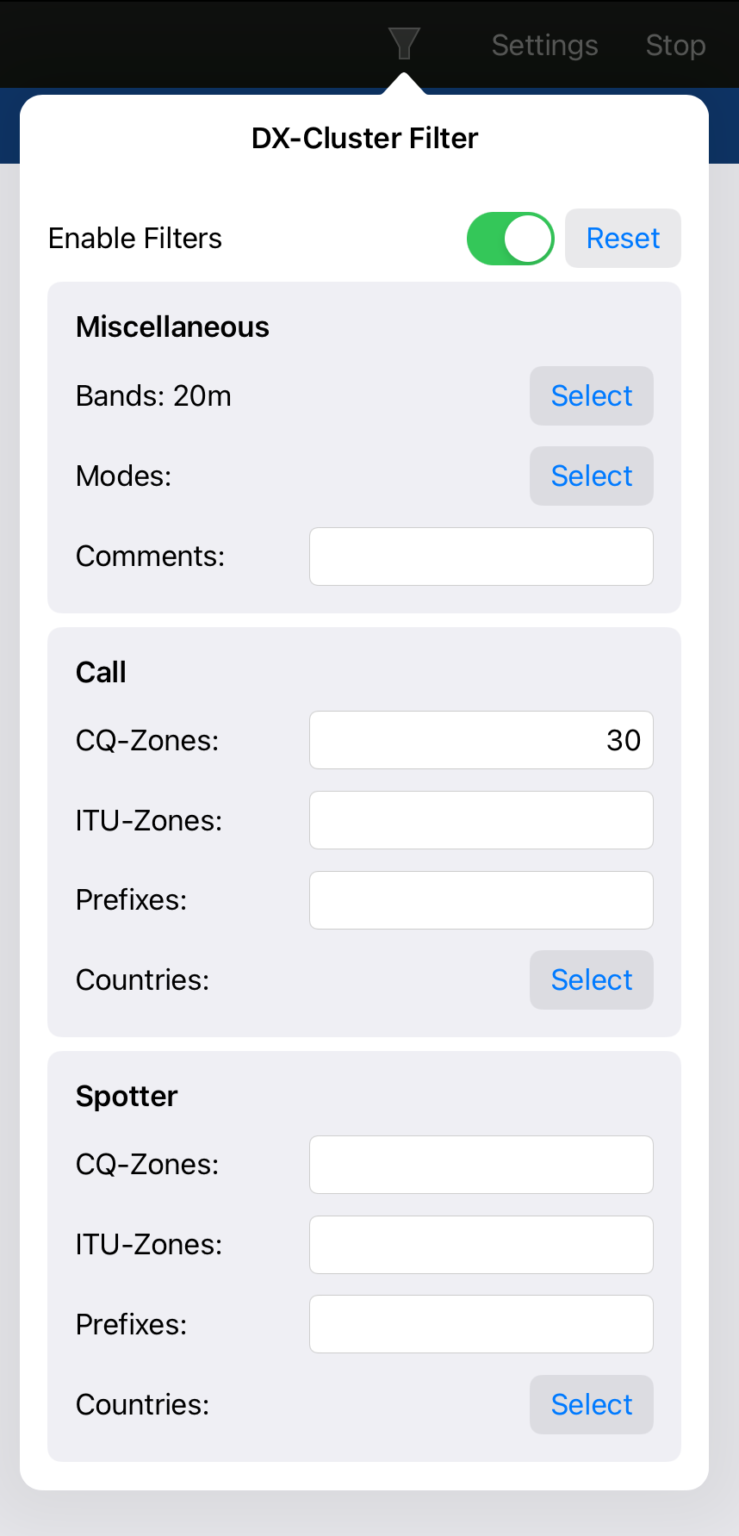
Here, you can select the Bands or Modes or Countries you are only interested in or enter CQ-Zones, ITU-Zones or prefixed of Spotter or Calls you only want to see. For those you can enter multiple values, separated by comma.
At the top of these filter settings, you can either enable or disable these filters.
The Settings menu will let you alter several options of the DX-Cluster Tool. From here, you can select a one of the predefined servers or add your own by clicking the Add button.
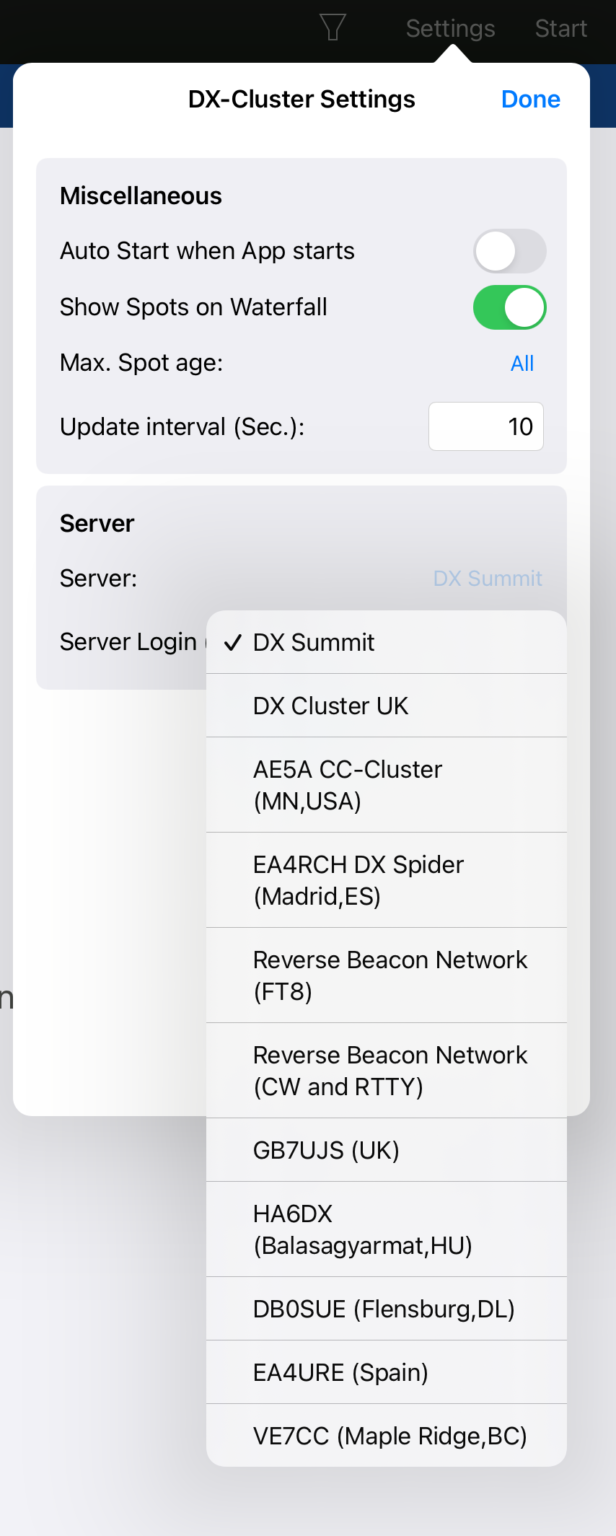
16.1. Map
You can either see a list of all current DX-Cluster entries or a Map by tapping the Map / List button at the top.
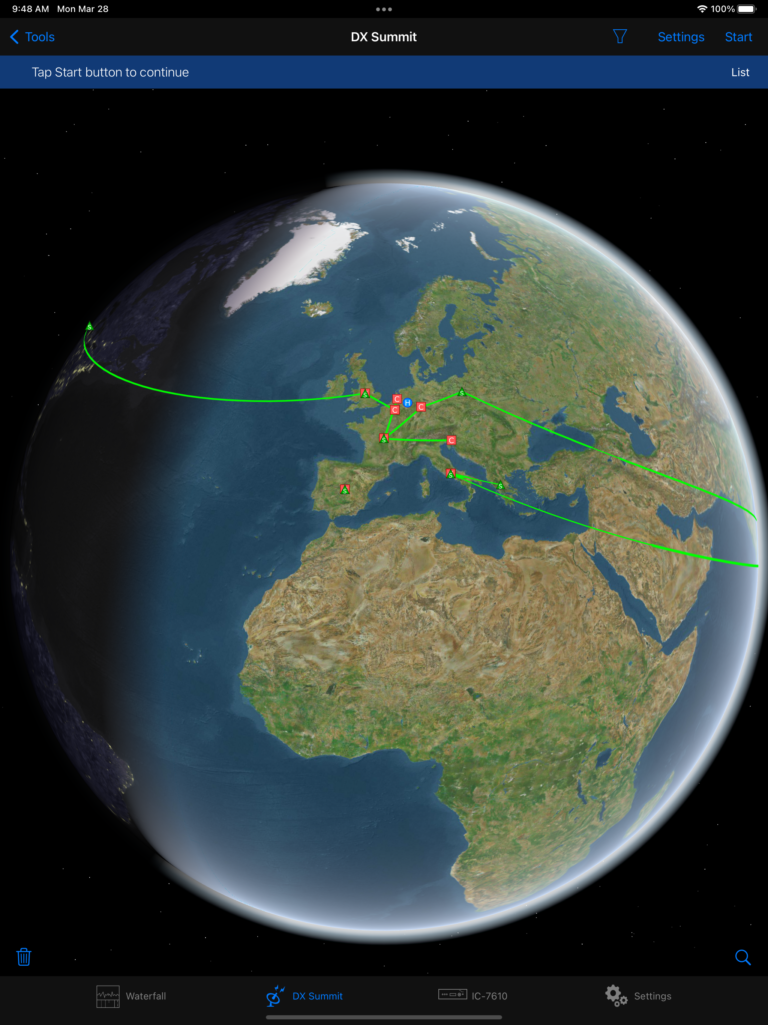
17. POTA
The POTA Tool shows Parks on the Air (POTA) spots in a similar way like the DX-Cluster tool does for regular spots.
POTA Spots and be displayed on the Waterfall. You can directly jump to a certain frequency of a POTA Spot and take over Park information to the Logging Window.
Note
The POTA Tool can be unlocked along with the DX-Cluster Tool. Once any of these two tools have been unlocked, the other is unlocked too.
After starting the POTA Tool, after a short while, you will see all spotted POTA stations

If you double-tap on a line in this list, the Radio will tune to the particular frequency of this spot.
Note
Tuning to the spot will not work for FT8 as the announced frequency is never the exact FT8 frequency. For FT8 Spots, you will need to open the FT8 Tool manually and look out for the POTA Activator.
Second, logging information will be prefilled to the logging window, if it had been opened before.
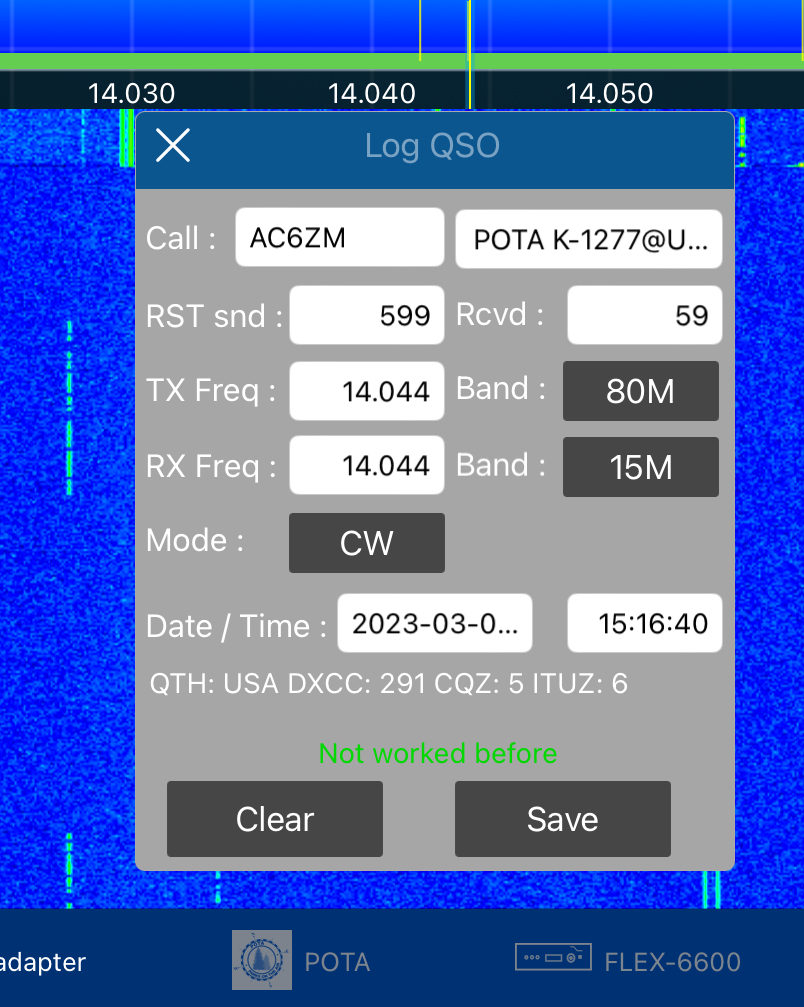
Note
For FT8 and for using this feature, you need to turn both auto logging settings off as otherwise FT8 QSOs will be logged without the additional POTA information.
17.1. Map
You can also get all current POTA stations displayed on a Map by hitting the MAP button
18. PSK Reporter
PSK Reporter is a great automatic propagation reporter for digital modes, including FT8 / FT4.
You can use PSK Reporter to get an almost instant idea about the current DX conditions and who is able to copy you around the world.
This App integrates PSK Reporter in two ways.
18.1. Submitting PSK Reporter spots
PSK Reporter lives from the fact that many HAMs are contributing their reception reports to PSK Reporter. This App can automatically send FT8 reports to PSK reporter when enabled (under Settings inside the FT8 Tool or the PSK Reporter Tool).
If enabled, a list of received FT8/FT4 signals will be submitted to PSK Reporter every five minutes. Except for the information about your antenna (which is optional), nothing else has to be configured.
18.2. Viewing PSK Reporter results
The opposite side of PSK Reporter is to view a list of all stations who received your signal. This is, what the PSK Reporter Tool is for.
To get a report of stations that are able to copy you, first have a QSO or a test transmission on a band you are interested in. Next open this Tool and enter your callsign at the top of the window (it not already per-filled) and click on the start button.
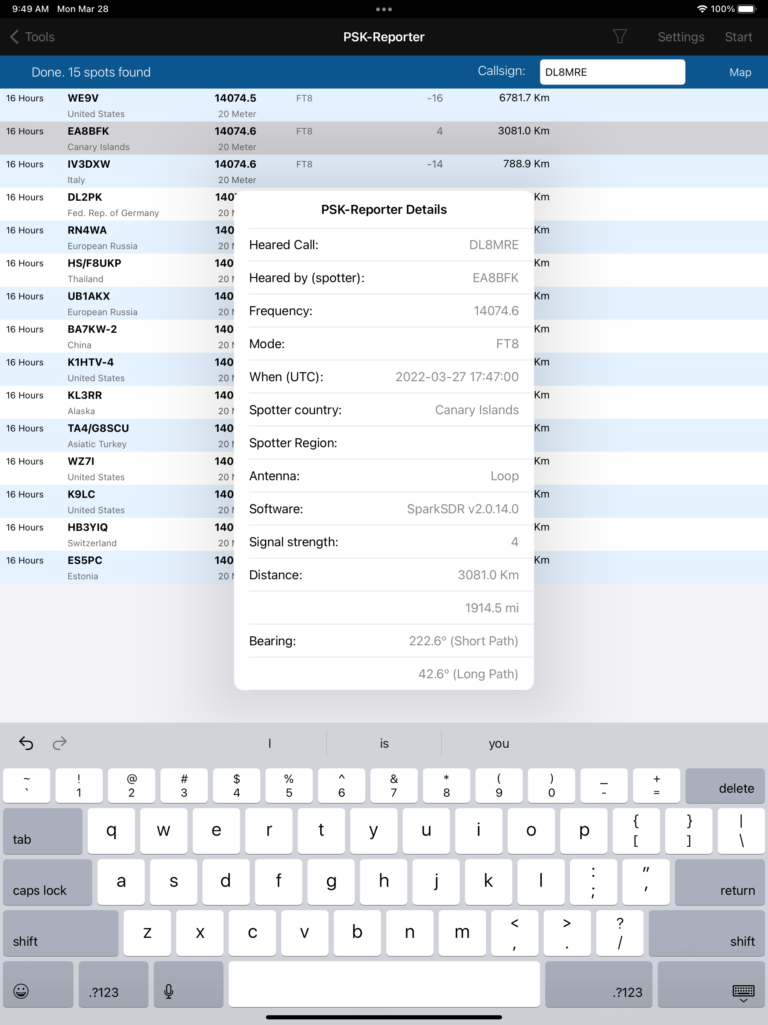
Once the list is filled with reports you can tap on a line for more details.
It may take up to 15 minutes after your transmission until you will see your results. This is because every contributing listener will update their reports every five minutes and it is not possible to download reports from PSK Reporter sooner than every 5 minutes as well. If you would request an update sooner than after five minutes, you will see an according message at the bottom of this window.
You can narrow down the results by using the Filter Icon at the top and selecting a Mode and Time.
You can also visualize all locations on a map by switching to the map mode using the Icon at the top.
19. Voice Macros
The Voice Macro feature allows to record voice using your iPhone / iPad built in microphone or connected headset. Such voice macros can be played back later on while in QSOs.
This feature works similar to the CWX Macro feature but plays back audio while in phone mode (SSB, AM or FM).

19.1. Recording a Voice Macro
To record a Voice Macro, open the Voice Macro Tool and tap on Edit on one of the 12 available Macros.
Next, tap on Record on the Recording Editing screen
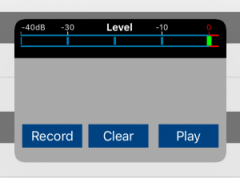
While recording, watch the level meter at the top.
Next, you can tap Play to test your recording or Record to start over again.
When tapping on Settings in the upper right corner of the Voice Macro screen, you can change various settings:
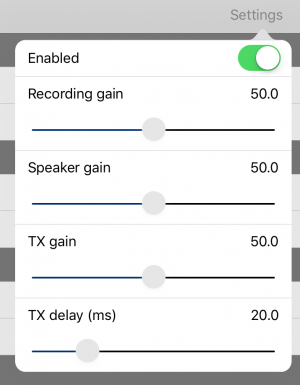
Recording gain can be used to adjust the microphone volume.
Speaker gain can be used to adjust the playback volume on your local device. If you don’t want to hear your recording while transmitting, just turn this slider completely to the left.
TX gain represents the transmitting volume.
TX delay can be used to add a delay after PTT keying, before the voice macro starts to play.
Note
For best results, use an external microphone (headset) and try to find the right balance between the Recording (Microphone) gain and TX gain.
20. CW Macros
It is possible to create CW-Macros for your CW QSOs. After opening the CW-Macros tool, you can maintain up to ten different macros which can use Placeholders like {MYCALL} which will be replaced before the Macro gets sent.
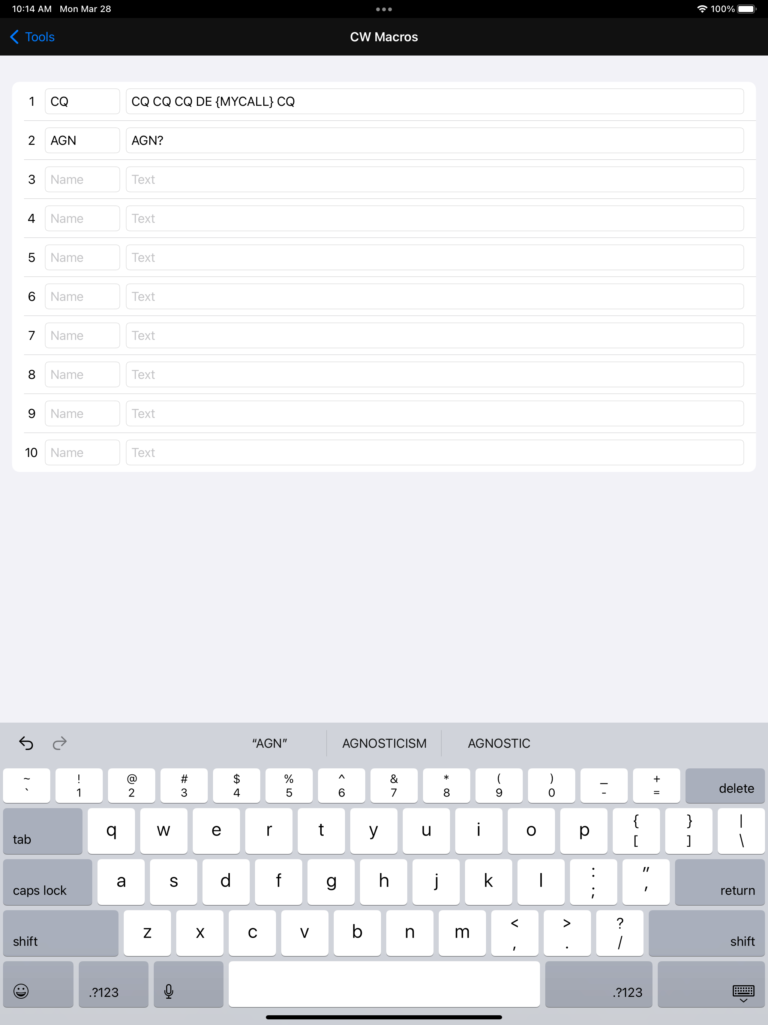
A list of available Variables can be found in the Attachment of this manual.
To use CW-Macros, you can open the supplemental Macros window (View → Macros) for easy access as seen below.
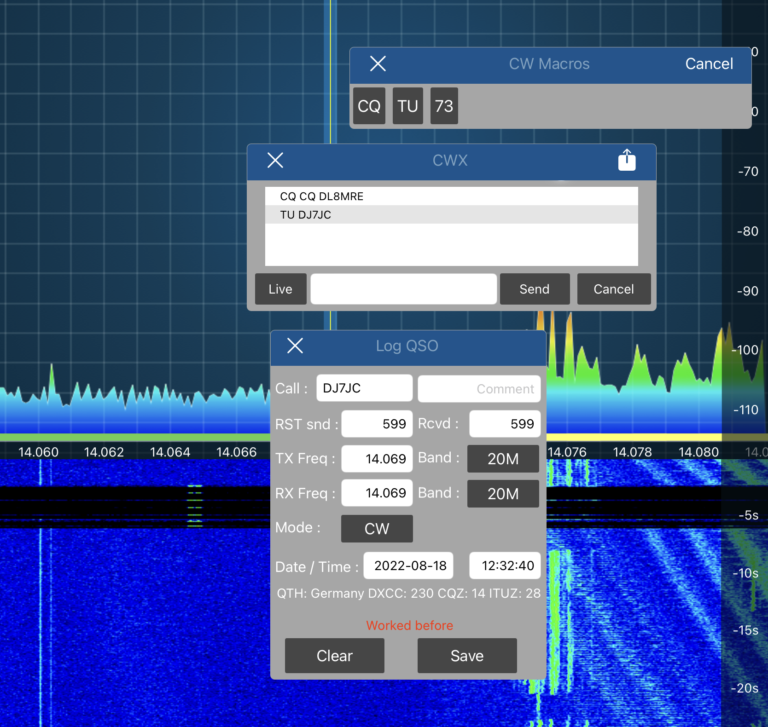
Macros can also be sent using a physical keyboard and pressing the keys 1 to 0 along with the option key or a MIDI controller.
21. Logbook
The included Logbook was implemented with the idea in mind to offer a quick and easy logging feature to this App which should already provide all basic requirements for day to day logging.
You can export (and import) ADIF files to exchange logbook contents with other logbook software.
Note
If you wish to export only a portion of your complete log file, utilize a filter to refine your logbook and enable the Export only filtered Log entries setting under Settings.
After starting the Logbook tool you will see your last logs.
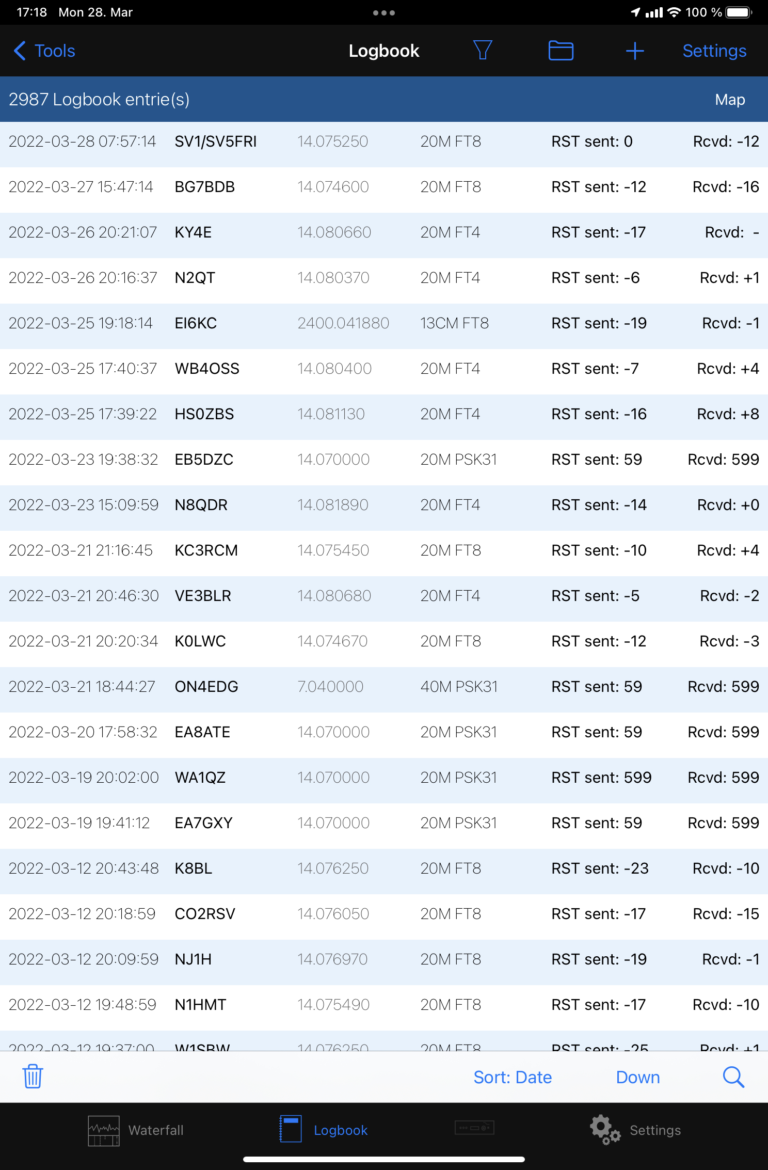
At the bottom, you see a trash-can which can be use to delete the whole logbook if you like and a sort menu. The Spy-glass will open a search field where you can enter a call-sign you are looking for.
To edit an already logged QSO, just tap on a line.
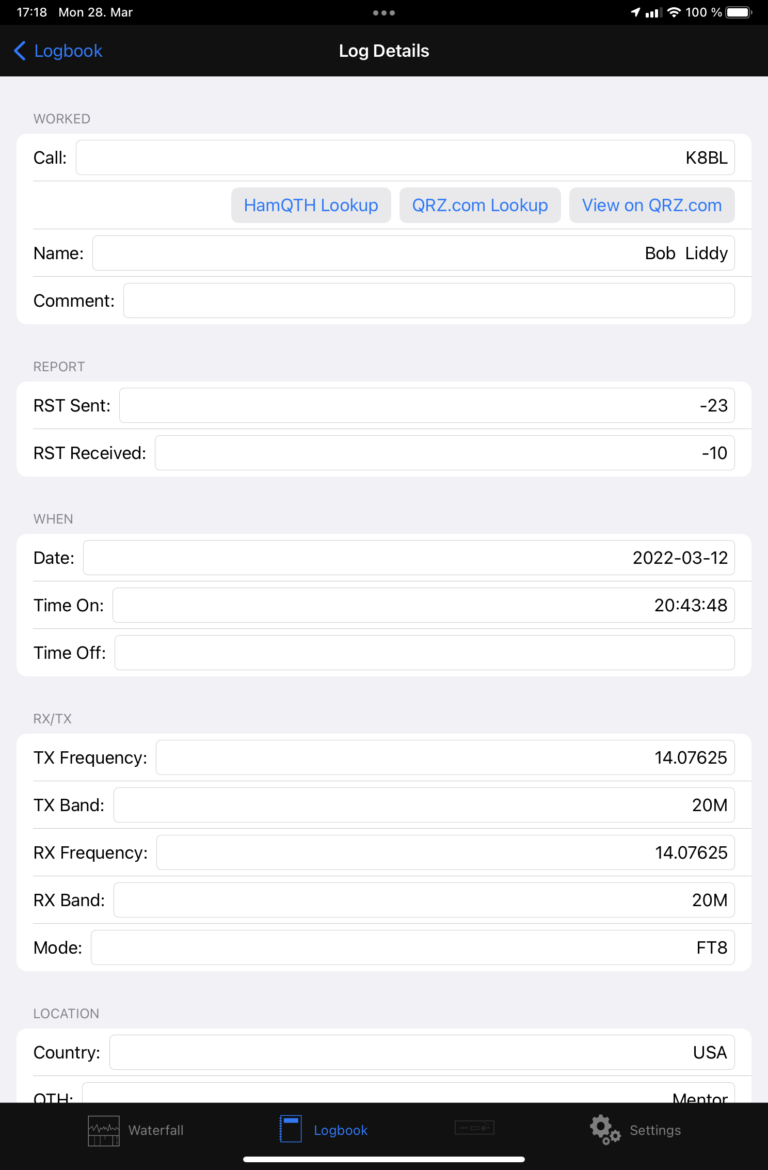
From here, you can alter all fields of the log manually or let them be filled using the HamQTH or QRZ.com lookup feature. For this, just tap on the corresponding button.
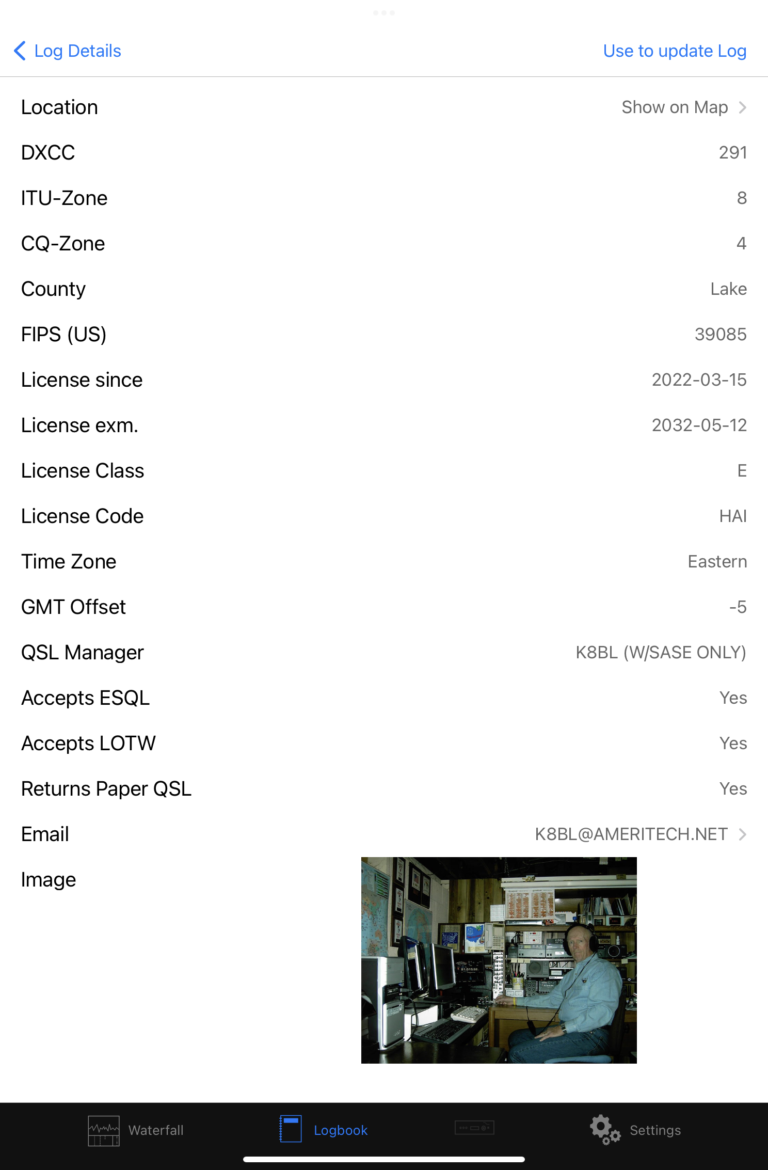
And you will see the details provided by these Call lookup services. Hit the Use to update Log button at the top to take over these values for all empty field of your Log.
There are several settings for customizing the logbook using the Settings button at the top.
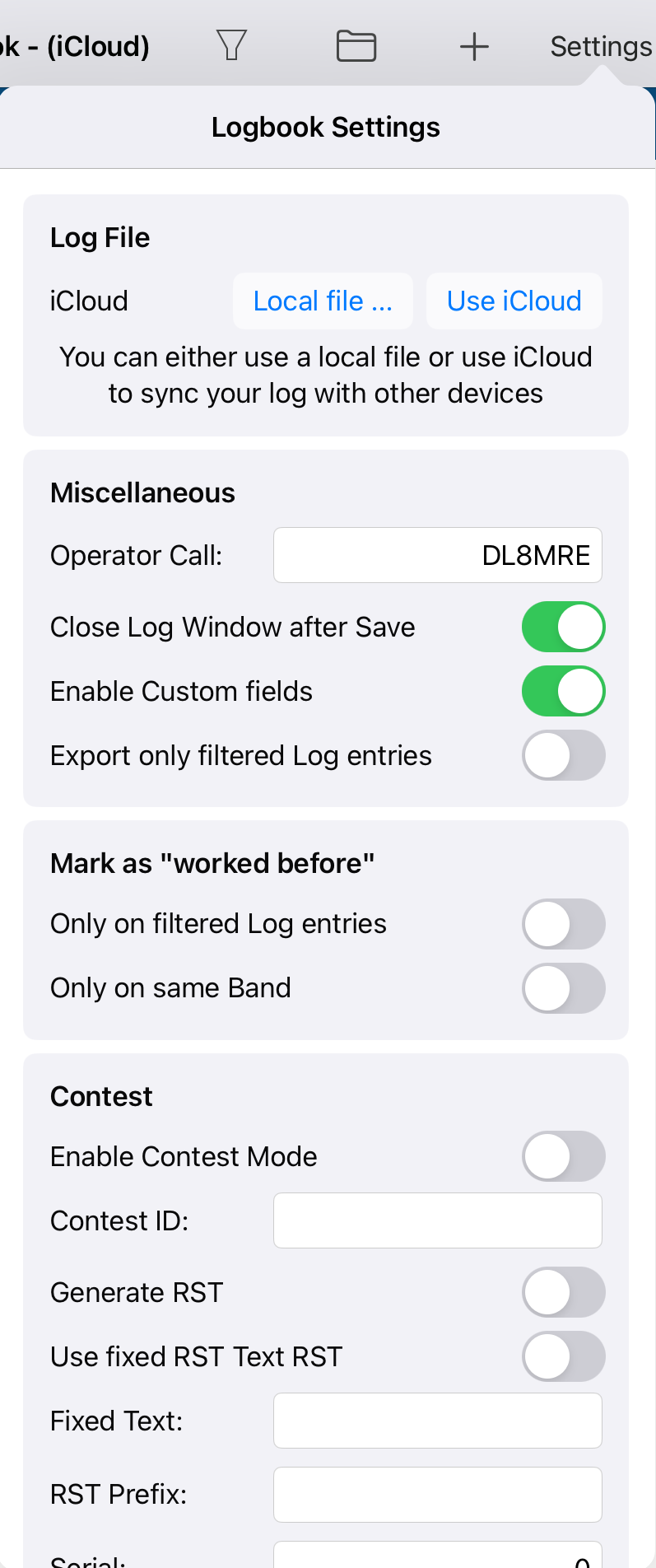
When enabled, your Logbook will be synchronized across your devices. This synchronization uses iCloud Drive which needs to be enabled on your Device and will work even with the Mac Version of this App or the SmartSDR Apps.
Other Tools like the FT8 Tool will display Call signs marked in a different color if you have worked a call before. In the above settings you can define when a Call sign should be regarded as “worked before”.
Under Contest, you can let the logging Tool automatically generate text for the RST entries.
You can also filter the Logbook using the Filter button.
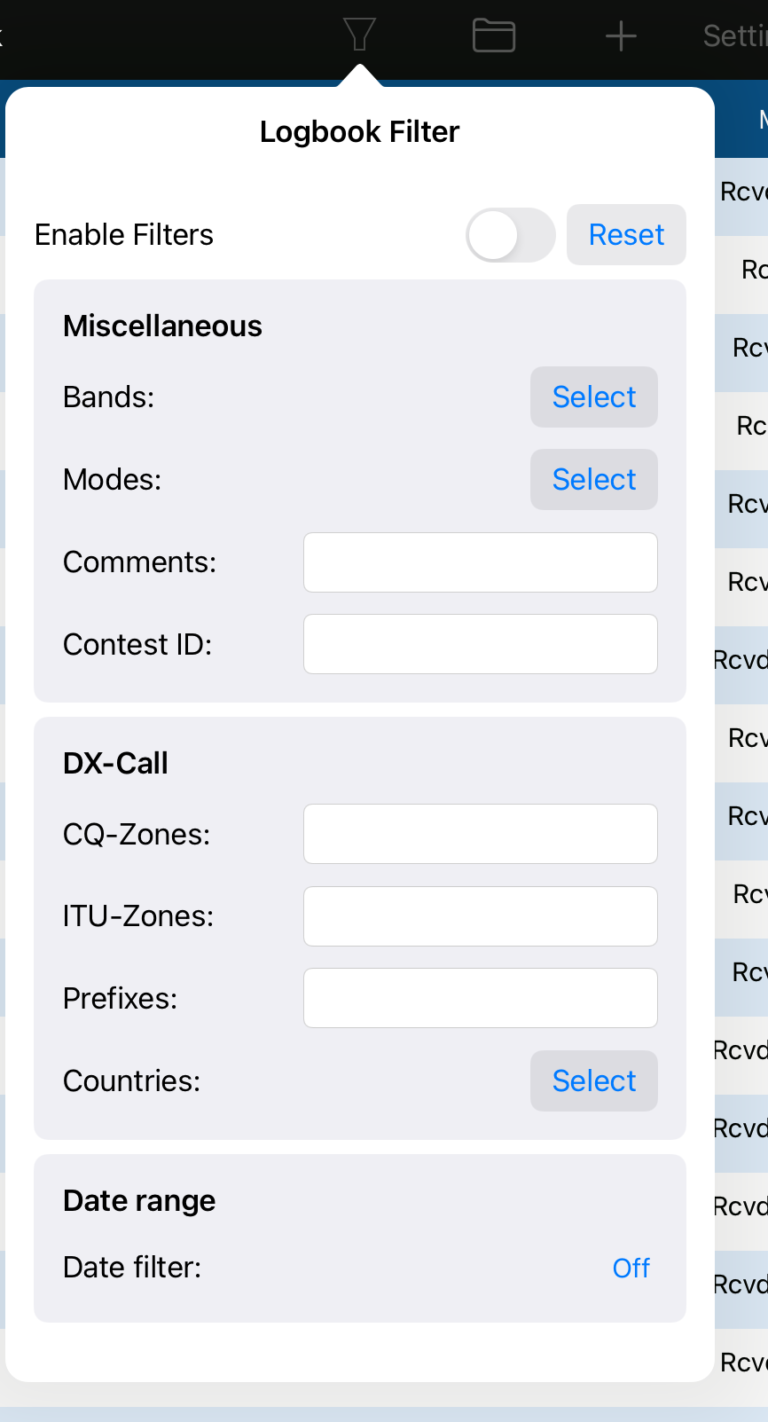
21.1. Logging a new QSO
For logging a new QSO, you have a couple of options:
From inside the Logbook Tool, tapping the + Icon
From View menu of the Waterfall tab and selecting “Log new QSO”
If a physical keyboard is attached to your iPad, by using the Option and L keys
The FT8 Tool will open the logging Window after finishing a QSO
The displayed logging window will be pre-populated with values based on the current VFO:
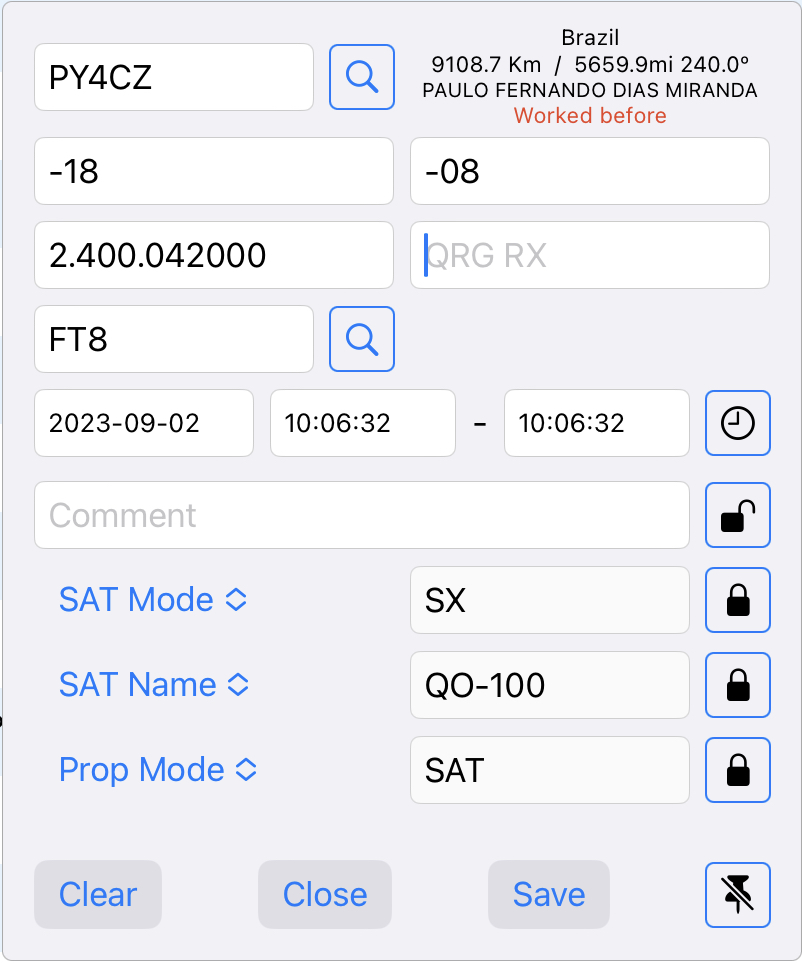
To log a new QSO (Contact), simply enter the call sign of your QSO partner and tap the “Save” button. This action will save the contact details to your Logbook.
To the right of the call sign entry field, you’ll find additional information about the entered call sign, including QTH (location), distance measured in both kilometers and miles, as well as details for both short and long path (LP) calculations. This area also indicates whether the call sign is already present in your logbook.
You can tap the Spy-Glass button for an in-depth lookup of the entered call sign, providing you with further details.
21.1.1. Time Stamps
The QSO Start Time automatically reflects the moment you opened the log entry window. To continuously update the QSO End Time, tap the black clock icon located to the right of the time display; this will cause the end time to update every second.
21.1.2. Field Locking
Certain fields feature a lock icon on their right side. Activating this lock ensures that the information you’ve entered into these fields remains constant, even after saving and moving on to a new QSO entry. This can be useful for information that remains consistent across multiple contacts.
21.1.3. Custom Fields
When you enable Custom Fields in the Logbook Settings, three additional input fields will appear. You can select the appropriate ADIF (Amateur Data Interchange Format) field for each from a dropdown menu on the left side.
Custom fields are especially useful for specialized operations like POTA (Parks on the Air), SOTA (Summits on the Air), SAT-Mode (Satellite Mode), or any other scenarios requiring you to log QSO values that are typically not needed.
21.1.4. Keep the log window open
Located at the bottom-right corner of the screen is a push-pin icon that controls the behavior of the window after saving a QSO. If the push-pin icon is crossed out, the window will automatically close once you tap the “Save” button. If the icon is not crossed out, the window will clear the fields for your next QSO entry but remain open, allowing for quick and consecutive logging.
21.2. Log submission to other Apps via UDP
If you are using your iPad on your local network and want to continue to use another Logging software on your Mac or even your Windows PC, you can use a feature of this App which submits all new log entries to other software via UDP.
This feature can be enabled in the App Setting. If enabled, whenever you are adding a new Log entry, this log entry will be submitted simultaneously to the other Logging program. In addition, there is a “UDP Broadcast” button on the Log detail screen which can be used to submit any older or amended log entry as well.
For UDP Log transmission, you need to enter the IP Address of the PC/Mac where your other Logging program is running and the required UDP Port. If the program is running on the same Mac, just enter 127.0.0.1 as IP Address.
Unfortunately, there are different standards for submitting log entries via UDP. This App supports two different standards:
1.) For N1MM or Log4OM format
This standard is understood by N1MM or Log4OM and others, mainly PC based logging programs.
2.) WSJT-X format
This standard is used by WSJT-X. Every logging software that can receive WSJT-X UDP logging information can be used.
The ports that need to be used for each standard depends on the Logging program. Some will let you enter an individual port number, some have a fixed port number. In any case, the port number used by the logging software needs to be identical to the port entered here.
When clicking the Test button, a sample log entry will be submitted so you can verify if the log entry will be received in your logging program.
21.3. Logbook export
When tapping the Folder Icon at the top you can chose how to import or export your logbook. It is recommended to create export files vie Email or iCloud Drive to keep a backup of your Logbook.
1. Modes
The Modes tab will be visible once you are connected to a Radio. It includes tools for operating in certain modes like CW or FT8.

Note
Some of these tools need to be unlocked (purchased). The purchase of the FT8 Tool also unlocks the FT8-Skimmer and CW Tool. Some tools are only available on iPads like the FT8-Skimmer Tool.
2. FT8
This tool allows to use and operate the popular FT8 and FT4 mode, invented by Nobel prize winner Joe Taylor, K1JT.
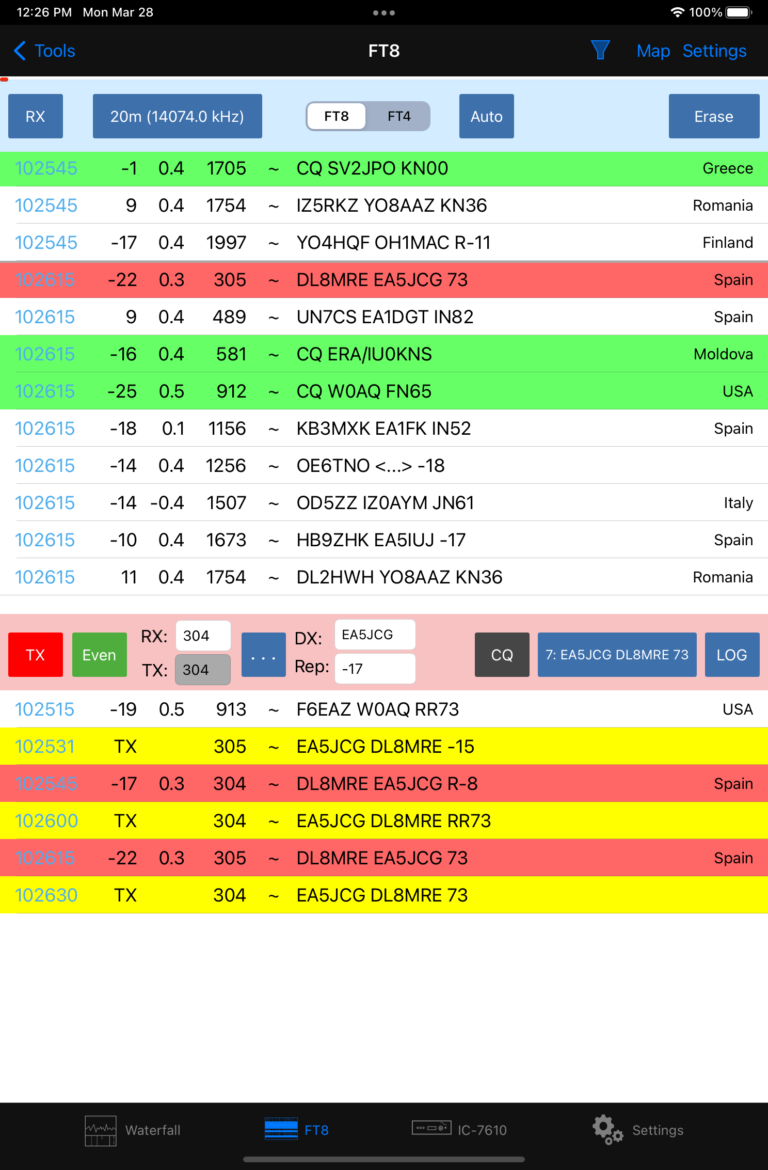
The screen above shows a typical FT8 QSO.
2.1. Foreword (please read)
I had the pleasure of meeting Joe in Dayton in 2019. His lecture was the catalyst for me to prioritize the integration of this feature into my SmartSDR iOS App. Grasping his method for encoding and decoding FT8 messages was a learning curve, involving a deep dive into FFT (fast Fourier transformation). I’m proud to say that all my Apps now boasts a comprehensive FT8/FT4 Tool.
We owe a debt of gratitude to Joe Taylor , the architect of this exceptional mode.
2.2. Requirements / Features
So far, the App only supports FT4 and FT8. Also, no Contest or DX-Pedition mode is supported. It just supports standard QSO’s which are about 95% of all FT4 and FT8 QSOs.
The App supports AUTO mode to automatically generate answer messages based on received messages. It also supports Auto Logging and prompts to log a QSO with all entries pre-filled based on the recent QSO. Worked before Calls will be marked to prevent working them again. CQ Calls will also be displayed on the Waterfall just like DX-Cluster Spots.
2.3. How to use
My approach was to offer FT8 with minimal or no configuration and operation effort. If you are already familiar with WSJT-X, you will immediately know how to operate in FT8 with my App. If you have never worked FT8 before or found it too complicated, just read the following basics and you should be set.
My hope is, to encourage more HAMs to join this fantastic new way to get in contact with each other by providing a simple and easy to use FT8 tool. Even if you found FT8 too complicated in the past, just give it a try with this tool. No cable fiddling, audio interfaces, strange settings or CAT commands.
Just open this tool and start your first FT8 QSO.
2.4. A few FT8 Basics
A typical FT8 QSO starts by somebody (say K1CQ) calling CQ, next somebody like you (say DC1ME) is answering. Both will then exchange their signal reports and optionally end the QSO by saying 73.
Here is how it typically looks like:
Caller |
You |
Meaning |
|---|---|---|
CQ K1CQ EN61 |
K1CQ is Calling CQ. His Grid locator is EN61 |
|
K1CQ DC1ME JO12 |
You are replying to him with your Grid locator |
|
DC1ME K1CQ -11 |
K1CQ responds to you with a signal report |
|
K1CQ DC1ME R-10 |
You, confirming his report and send your own report |
Now, there are two typical options:
Option 1 (the fastest and more common):
DC1ME K1CQ RR73 |
K1CQ confirmed the reception of your report and says best regards. The QSO is done now. No need to respond again |
Option 2 (more polite option which takes longer):
CDC1ME K1CQ RRR |
K1CQ confirmed the reception of your report |
|
K1CQ DC1ME 73 |
You say best regards |
|
DC1ME K1CQ 73 |
K1CQ send his best regards and the QSO is over |
If you would like to call CQ yourself instead, the procedure is the same. Just swap the Callsigns in the above table.
These so-called FT8 messages cannot be longer than 13 Characters. It takes 13 seconds to transfer these messages and they will be exchanged every 15 seconds. Thus, there can be 4 messages per minute. When sending at second zero or 30 it is called “even” or “first”. When sending at second 15 or 45, it is called “odd”.
Besides these aforementioned typical QSO messages, there is additional information that will be added to messages in Contests Mode or DXpedition mode. These modes are not supported by this FT8 tool.
CQ Callers may also add either DX or the desired destination to their CQ message if they just want to get an answer from certain stations.
For example:
CQ DX K1CQ EN61 |
K1CQ just wants to have DX QSOs |
CQ JA K1CQ EN61 |
K1CQ just want to have contact with Japan |
And that’s pretty much it. That’s all you need to know to operate in FT8 with this App.
If you want to learn more, just head to G4IFBs website which includes a fantastic FT8 Operating guide, written by Gary Hinson, ZL2IFB : www.g4ifb.com which is also available in other languages.
2.5. Using the FT8 tool
You can start the FT8 Tool from the Tools menu as usual.
There are two window parts, the Receive window with the blue header and the Transmit window with the red header. Both are explained more in details below.
2.6. Quick start
If you can’t wait and have no time to read further, the following sequence will perform a quick FT8 qso:
Select a Frequency (next of the RX Button)
Hit the RX button and wait until the list fills
Double-tap on any of the entries of the list
… and wait, the whole QSO will be completed automatically and ending with the logging window as shown below:
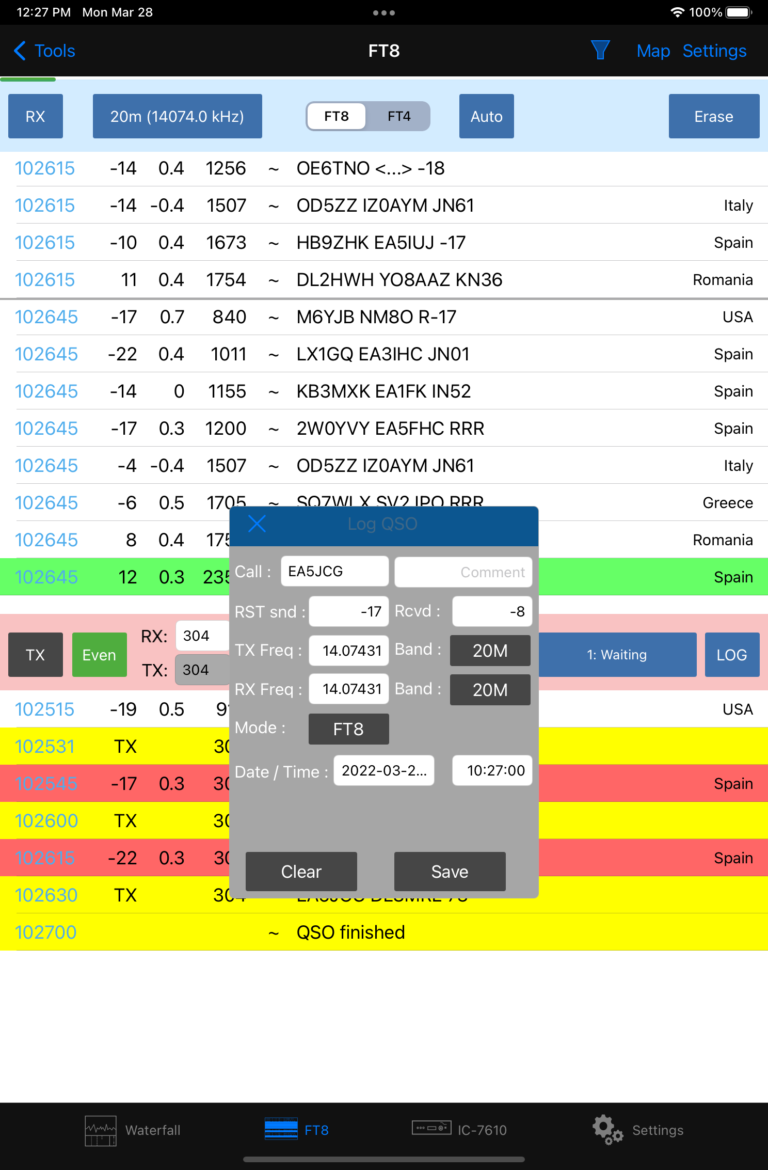
… if all goes well of course. But there can be situations where something goes wrong or you want to call CQ yourself. The following chapters will describe everything more in detail.
2.7. The Receive Window
On the top half you will see the RX window with the blue header.

All received messages are displayed on this part of the screen. The following colors are being used:
Green background: Somebody is calling CQ
Gray background: You already worked that station
Red background: your call-sign appears in that message (or you are in TX mode and message was sent on your TX frequency)
2.7.2. The Frequency selection
If you tap on the Frequency selection next to the RX button, you can select the Band or Frequency you want to operate. These Frequencies are fixed and you should only operate on these predefined frequencies.
Note
The frequencies may differ depending on your location so please ensure that you set the correct IARU Region in the Preferences for the location from where you want to operate. Please also ensure that you did set your Callsign and your Grid (QTH) locator in the App Settings.
Hint
If you want to operate on another, not supported Frequency, for example to work DX-Pedition stations, you can always select Manual to tune to any frequency.
Once you hit RX, the Radio will not just tune to the right frequency. Also, all necessary parameters such as Mode, Filter width etc. will be set automatically. So should you accidentally have changed some settings, just tap the RX button twice to get the right settings back.
After at least 15 seconds, you may see the first FT8 conversations in the upper receiving part of the screen.
2.7.3. FT8 / FT4
Use these buttons to switch between FT8 and FT4
2.7.4. AUTO
Because QSOs are standardized in FT8 (except for the two options to finish a QSO either by RRR or RR73), FT8 QSOs can be automated.
Whenever a message has been received, it the App knows which message needs to be sent next.
If you turn on the AUTO button at the top (make it blue), the App will automatically select the next message to be sent depending on the received message (even in case of an RRR or RR73) and sent the appropriate message automatically in the next transmission phase.
If you need more flexibility or want to finish a broken QSO, just turn off AUTO and select the message you like to be send.
If you select Message 9 {Individual}, you can even enter anything else as message which you would like to send.
2.7.5. Filter
On a busy frequency, the receive list can quickly get full and you may easily miss some interesting calls. The App provides a filter, described more in details later, to limit the number of calls in the list. Tapping the Filter Icon will open the filter settings from where you can toggle activation of the filter with immediate effect to the list below.
2.7.6. Erase
Tapping the Erase button once, will clear the TX Window (described below) and all QSO fields like DX and Report. A double-tap will also clear the RX Window.
You may want to use this Button, once you have finished a QSO for example.
2.7.7. tapping on an entry of the list
If you tap on an entry of the receiving list, Frequency, the odd/even setting, the Callsign and dB report will be transferred to the TX Window (see below).
If you would double-tap on the line, in addition, the TX button will be enabled so you will automatically start your transmission at the next odd or even slot.
2.8. The Transmit Window
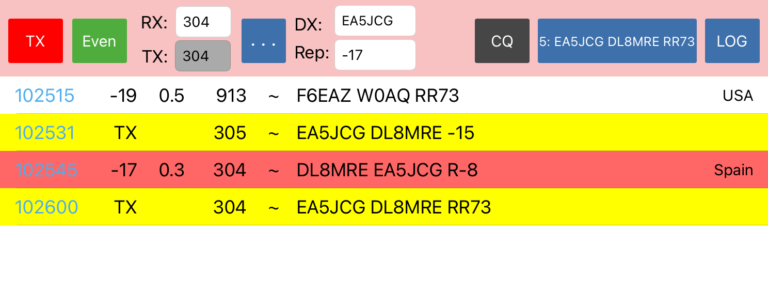
The list in this window contains all your sent messages in yellow and marked with “TX” instead of a dB value.
In addition, it contains all messages that have been received on your RX frequency or messages that are containing your callsign.
This way, you can better focus on your QSO partner and will also see if somebody else is transmitting on the same frequency so you can interrupt your QSO or transmission.
2.8.1. TX
If you tap on this button, transmission will start at the next odd- or even- time slot. If active, the button has a blue background, if you are currently transmitting, the button is red, otherwise it is gray, indicating a listen only mode.
2.8.2. Odd/Even
FT8/FT4 messages can either be sent at an even- or odd time slot. The other station is receiving and transmitting at the opposite time slot. This button indicates your transmission time slot. You can hit the button to change from even to odd or vice verse. If you are not in CQ mode and answering somebody from the receiving list by tapping (or double tapping) on an entry from the receiving list, this button will be set automatically (to the opposite of the calling station you tapped). So normally, you will only need this button if you are calling CQ yourself and want to start calling either in the even- or odd time slot. If the frequency is free, it is common to start in the even slot but that’s up to you.
The colors for odd (green) and even (blue) are corresponding with the colors of the UTC time in the lists.
2.8.3. RX: TX: Frequencies
The two entry fields are used to enter your RX and TX frequency in Hz relative to the Slice frequency. The values usually ranges from 100 to 2900 Hz.
If you tap on a line in the receive list, the frequencies will be taken over from the line you have tapped.
Usually, you may want to transmit on the same frequency where your destination is transmitting. Using the […] button right of the two frequency entry fields, you can either enable or disable TX being equal to RX.
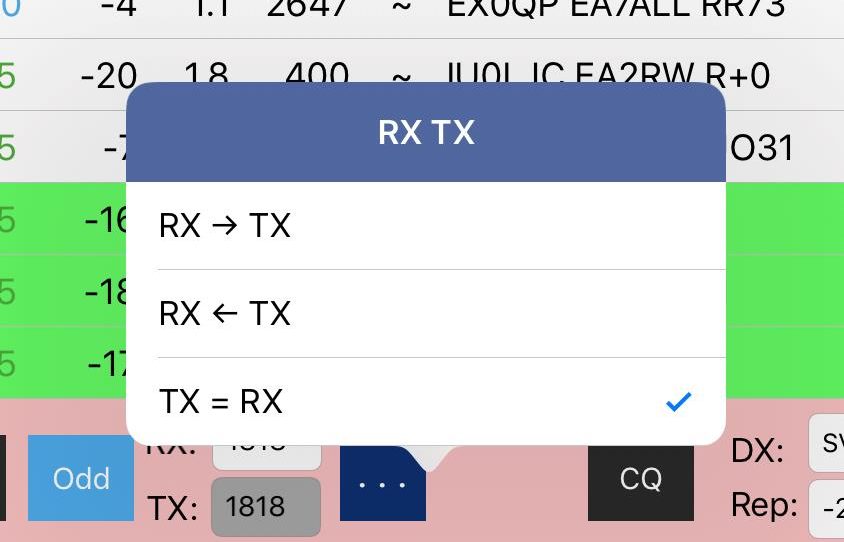
By tapping on TX = RX, the check-mark will be set or removed. If the check-mark is removed you can adjust TX and RX frequency individually. If it is checked, the TX frequency will always be equal to RX. Using the other options here will move the value of one field RX or TX to the other field.
Hint
Using the same RX and TX frequency is the regular operating mode when answering calls. Only if the other station can’t hear you, you may want to use a different TX frequency. On the other hand, when calling CQ you should always operate in Split mode. For this, tap the […] button. Remove the checkmark for the top entry TX = RX in the list. This means TX must not be equal to RX. Tapping this entry again will add a checkmark in front of TX = RX which means TX is always equal to RX so if you cange your RX frequency, the TX frequency will be changed as well.
You can also select the FT8 frequency conveniently from the Waterfall by long-tapping at the desired frequency and selecting “Set FT8 TX”.
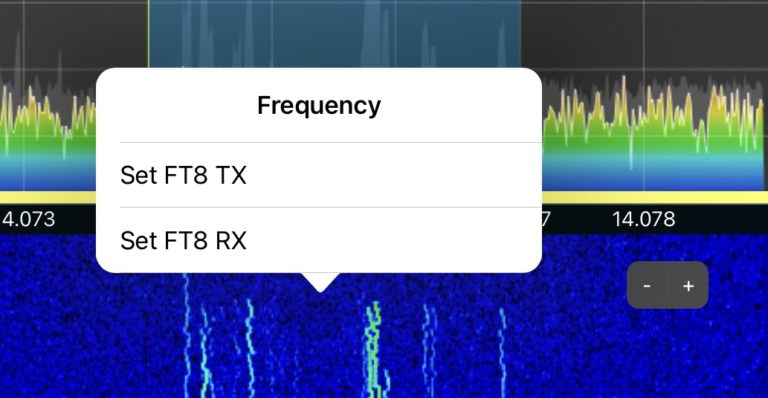
2.8.4. DX
This field is for the Call-sign of the other station and will be pre-filled when tapping on an entry of the receiving list.
2.8.5. Rep
This field is the dB report of the other station which will also be pre-filled.
2.8.6. CQ
Using this button, you can switch between CQ mode or answering mode. A blue button indicates the activated CQ mode.
2.8.7. Message selection
Right from the CQ button, you can select a message which will be sent in the next odd or even slot.
If you are in AUTO mode, you usually don’t need to change this message, only if you are in manual mode or want to correct / repeat a previously wrong interpreted or received message.
The “Short Messages (no grid) will no longer start with the message which includes your QTH locator (grid) and instead starts with the report message.
Note
A FT8 message can only get 15 characters long. If the message gets too long maybe because both call signs have extra characters, the QTH locator will be removed automatically.
2.8.8. LOG
Hitting the LOG button will open the logging window with all fields already pre-filled.
This button is not needed if you have enabled “Auto log after QSO” in the Settings of this FT8 Tool. In this case, the Log window will appear automatically at the end of a QSO.
You could even turn on “Don’t even show Log Window” and the QSO will be logged completely automated without any user intervention.
2.9. FT8 Settings
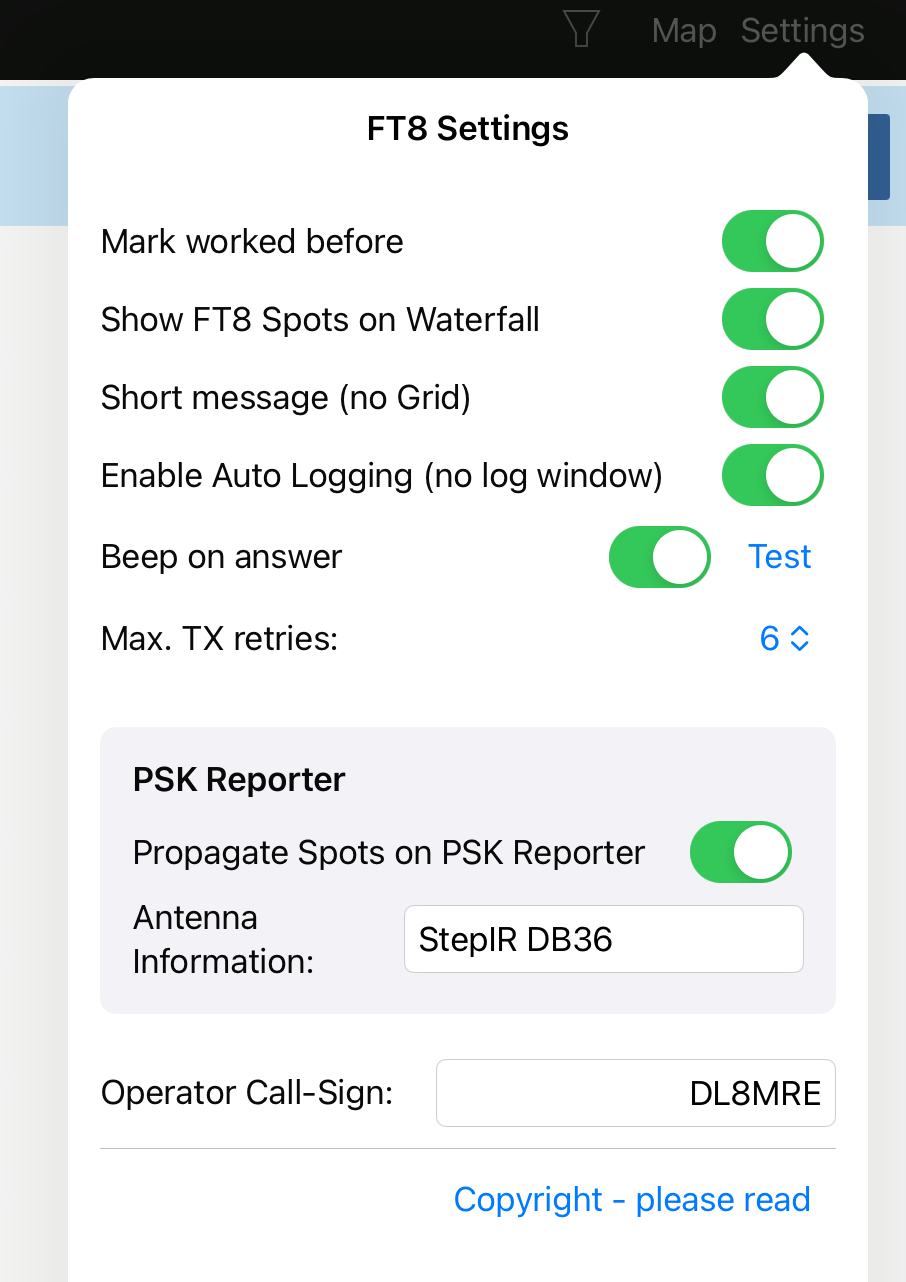
Most of these settings are self explanatory or you can just try them and will see what they do.
When TXing either while answering somebody else’s CQ or calling CQ yourself, the Max. TX retries value defines the number of tries so that you will not end up in an endless loop.
If you would enable Auto Log after QSO and even Auto Log without Log Window, all your QSOs will be logged automated without the need for any confirmation.
2.10. Filter Settings
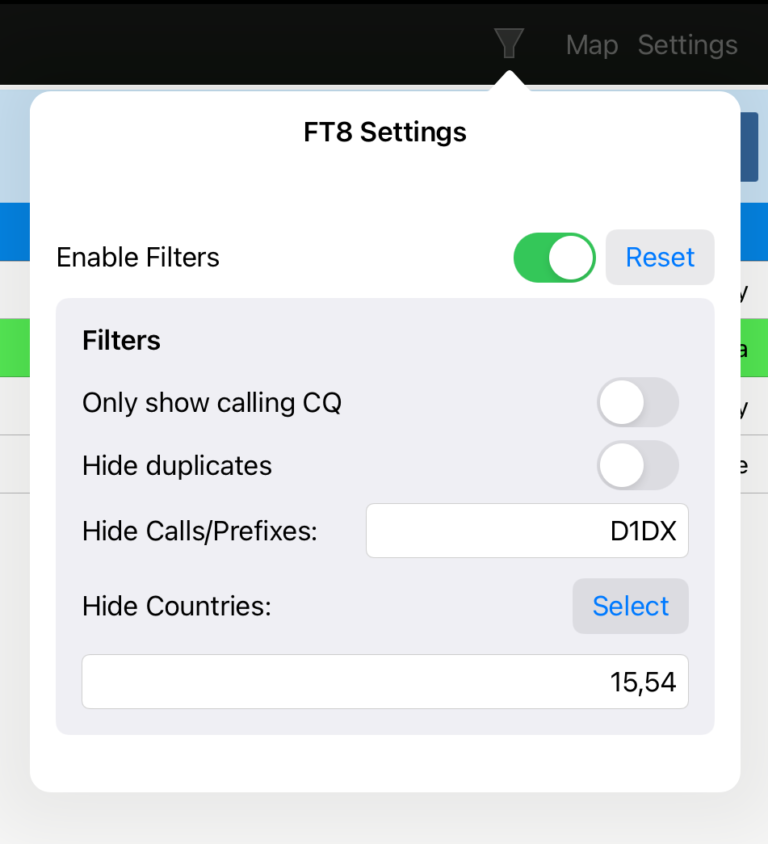
The filter settings help to reduce the number of lines in the receiving list. The filter can be enabled or disabled at the top of this settings screen.
2.11. Using FT8/FT4 for DXpeditions (Fox and Hound)
You can operate as a hound to work DXpeditions (the fox) with this app as follows: First, set the Band selector in the FT8 Tool to Manual and activate Split mode in FT8 by clicking the “…” icon and ensuring the TX = RX option is unchecked. This configuration allows you to monitor the DXpedition’s frequency, typically announced on their website, outside the standard FT8 or FT4 band range. Subsequently, transmit on the frequency where the DXpedition expects to receive your signal. Please note that if the DXpedition responds to your call with a multi-answer message, the app may not automatically log this response. In such cases, you’ll need to manually press the LOG button to log the QSO.
3. FT8 Skimmer
This Tool allows to monitor FT8 or FT4 activities on up to four Bands at the same time. This is useful, if you are waiting for good DX conditions or if you are interested in a certain DXCC or special call. You can let the App run, monitor the activities and let it ring on predefined alarm conditions.
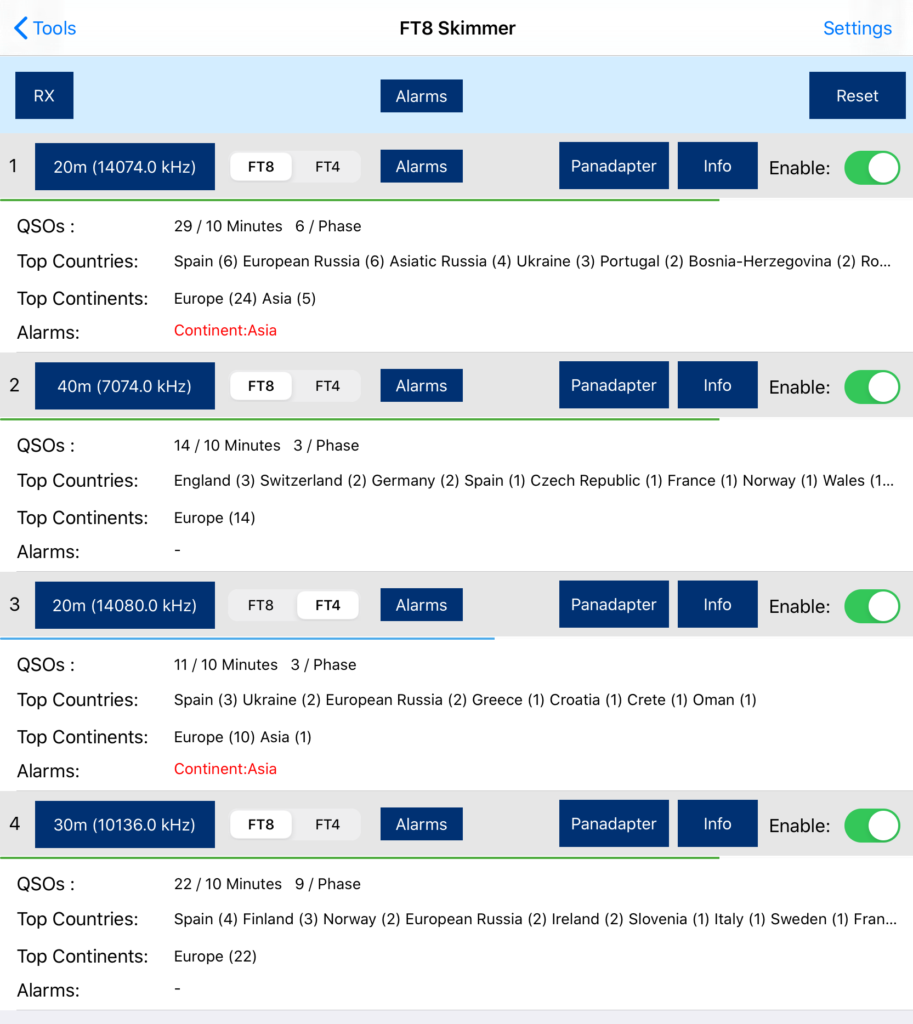
Attention
If you like to let this tool running all the time, better switch “Disconnect on close” off and “Prevent device sleep” on. These settings can be found on the App Settings screen.
3.1. How to use
Once started, you will see four monitoring panels. Each with an enable switch on the right side. Each monitor can be set to monitor a certain band in a certain mode (FT8 or FT4).
After selecting the Band, mode and enabling the monitors you like to run, tap on the RX button at the top to start all enabled monitors.
Tapping the RX button again will stop monitoring.
Once the first FT8/FT4 phases have passed, you will see information about the activity on the selected band. The first line QSOs will give you an impression about how busy this band currently is by reporting the number of QSOs during a pre defined time frame (see settings below) or per Phase.
For monitoring, the first four (two on a FlexRadio 6400) panadapters will be allocated, each with a single Slice which will be tuned to the desired frequency. By tapping on Panadapter, the App jumps to the corresponding panadapter so you can watch the activity live on the waterfall.
Note
If you leave this Tool by hitting the back button at the top, monitoring will be suspended. All allocated panadapters and slices will be released which allows you to directly open the FT8 Tool in order to work your desired station. This behavior is different to the FT8 Tool which will continue to run even if you close it.
3.2. Alarms
You can either set global alarm condition, which applies to all four monitors or alarms that only apply to a particular monitor (band). To set the alarms, either tap on the top Alarms button or the individual Alarm buttons inside each monitor.
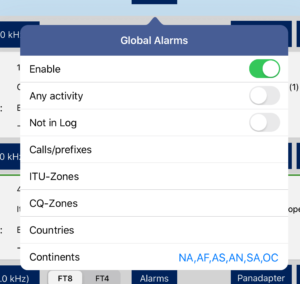
3.3. Settings
In the Settings menu for this Tool, you can select the Monitoring duration. Calls older than this time will be discarded and not counted.
If you are only interested in Band activities of CQ calling stations, just switch “Monitor only CQ calling” on.
Beep on alarm can be switched off if you don’t want to hear the alarm sound.
4. CW
The CW Mode Tool is designed for working in CW mode along with a CW decoder.
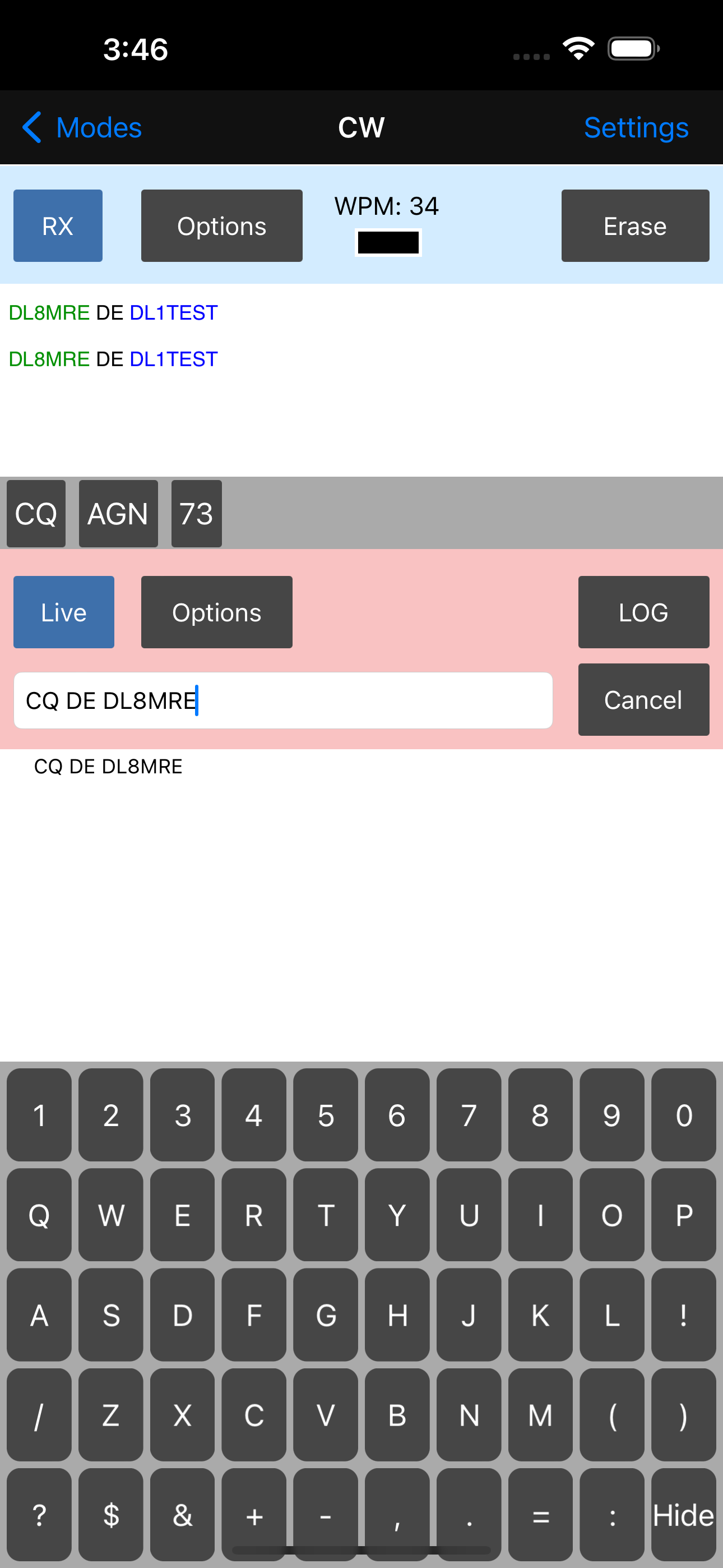
It consists of an RX section in the upper part where the decoded CW will be displayed and a TX section at the lower part.
4.1. Using the CW Mode Tool
To begin decoding CW, hit the RX button. The CW decoder will start decoding at the currently selected frequency. To optimize CW decoding, you can change decoding options using the Options button in the upper part.
If there is noise on the frequency, you may see random characters instead of well-decoded CW. To clear the receive section, hit the Erase button. Hitting Erase twice will also clear the TX section, as it does for the FT8 Tool.
The CW decoder will attempt to identify the speed of the other station, which will be displayed at the top. Identifying the speed requires receiving at least two characters, so the first characters of a submission might get lost or could be wrong. To prevent this, you can enter the expected speed as Min. and Max. WPN in the RX Options if you already know the speed of the other station.
If you have maintained CW Macros (in the Tools section of the App), these Macros will be displayed as buttons just below the decoding section.
The CW TX options can be maintained using the Options button of the TX section. When Live mode is turned on, everything you enter will be sent immediately. If Live mode is off, everything will be sent once you hit the return key.
Each submitted line will be displayed below the entry field. To repeat the transmission of a previously sent line, click on the line. To cancel any CW submission, hit the Cancel key.
To switch between the waterfall or other tools, select the tabs at the bottom. The Cancel key will hide the keyboard in case the keyboard covers the tabs at the bottom.
Hint
Instead of using the standard keyboard, you can select a special QWERTY or QWERTZ keyboard, like shown on the picture above, from the settings of the App.
5. WeFAX
This Tool allows to receive, display and store HF Fax or Weather-Fax (WeFax) transmissions often used for submitting weather maps and weather information.

To use this tool, first either tune to the desired frequency manually and select âManualâ for the Freq: selection or select one of the predefined entries of the list.
For these preselected entries, values for RX Offset, LSB and Inverted will be set automatically.
Hitting the RX button will start receiving. If the âAutoâ button is enabled, the Tool will wait for the synchronization signal until anything is displayed. Otherwise receiving starts immediate.
Using the Offset slider at the top, you can adjust the image offset if the start of the image has not been detected automatically.
The Adjust entry field can be used to adjust the slant of the image due to a clock inaccuracy.
The Erase button will clear the received image.
The Save button can be used to save the received image as .png file.
6. SSTV
This tool enables the transmission, reception and storage of Slow-Scan TV (SSTV) images.
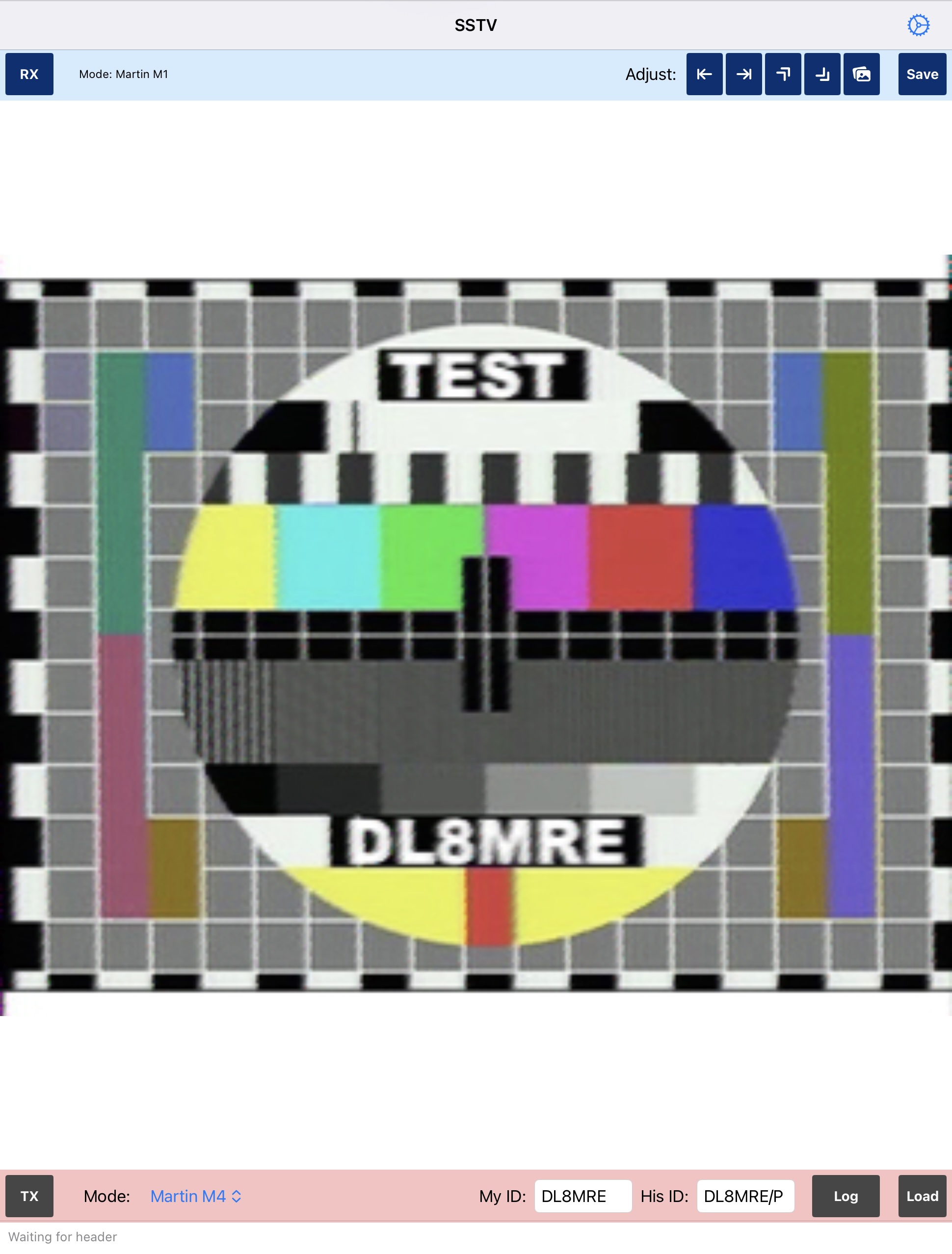
To utilize this tool, tune to a frequency where an SSTV signal is being transmitted.
Hint
The most popular SSTV frequency is 14.230 MHz (USB). Other frequencies include 21.340 MHz (USB), 7.171 and 7.110 MHz (LSB), 3.730 MHz (LSB) in the 10m Band, and 28.680 MHz (USB). Additionally, the International Space Station (ISS) occasionally transmits SSTV on 145.800 MHz (FM).
Change the mode accordingly. It is ideal to select the DIGL or DIGU mode to utilize the maximum filter width.
Pressing the RX button will start the reception process. Once an SSTV header tone is detected, the app tries to automatically identify the mode of the transmission and begins receiving the image, which will be displayed line by line during reception.
Once an image has been fully received, you can adjust the ‘slant’ and offset by using the buttons at the top right side.
The Save button allows you to save the received image as a .jpg file.
To send (transmit) an image, load the image using the Load button, select the desired mode, and hit the TX button.
Hint
Martin M1 and Scottie S1 are the most popular and provide good quality. For quick submissions, try M4, which offers very low quality but doesn’t take very long.
Note
You can add an individual text to the image once it was loaded using the Watermark button at the top. The text can also contain variables such as {CALL} or {RECRST} which will be replaced before the picture will be transmitted. For a list of variables, please see chapter Macro Variables further below in the manual.
It is common to use your own call-sign as FSK ID, which will be transmitted at the end of the SSTV image transmission. For this, your call-sign is pre-populated in the My ID field. Once a picture has been received and a FSK ID was detected, it will be transferred to the His ID field.
Hitting the Log button will open the Logbook entry screen with Mode (SSTV), Frequencies, and FSK ID pre-populated.
The following SSTV formats are supported:
Name |
Size and Color |
Martin M1 |
320 x 256 GBR |
Martin M2 |
320 x 256 GBR |
Martin M3 |
320 x 128 GBR |
Martin M4 |
320 x 128 GBR |
Scottie S1 |
320 x 256 GBR |
Scottie S2 |
320 x 256 GBR |
Scottie DX |
320 x 256 GBR |
Robot 72 |
320 x 240 YUV |
Robot 36 |
320 x 240 YUV |
Robot 24 |
320 x 240 YUV |
Robot 24 B/W |
320 x 240 BW |
Robot 12 B/W |
320 x 120 BW |
Robot 8 B/W |
320 x 120 BW |
Pasokon P3 |
640 x 496 RGB |
Pasokon P5 |
640 x 496 RGB |
Pasokon P7 |
640 x 496 RGB |
PD-50 |
320 x 256 YUV |
PD-90 |
320 x 256 YUV |
PD-120 |
640 x 496 YUV |
PD-160 |
512 x 400 YUV |
PD-180 |
640 x 496 YUV |
PD-240 |
640 x 496 YUV |
PD-290 |
800 x 616 YUV |
Wraase SC-2 120 |
320 x 256 RGB |
Wraase SC-2 180 |
320 x 256 RGB |
1. Mapping Editor
The Mapping Editor is being used by the MIDI Controller, FLic and Griffin Powermate Tools to assign functions to Controls.
You can start using this Editor in two different ways. You can either select a Default Mapping then open the Mapping Editor and alter this Mapping according your requirements.
Alternatively, you can open the Editor and tap on the Trashcan (top right corner) to delete the whole Mapping and start with an empty list.
1.2. Import / Export
By using the Folder Icon at the top, you can export or import individual Mappings (or Backups while trying out different Mapping options). This way, you can even Export and Import your Settings to another Device or share Settings with another OM.
In order to use this Import/Export feature, you need to have iCloud Drive enabled on your Device as all files will be stored on a separate SmartSDR Folder on iCloud Drive.
2. Macro Variables
You can use variables like {CALL} in CW Macros.
These variables will be replaced by values from your settings or log before being sent.
The following Macro Variables are available:
{CALL} |
Will be replaced by the Call-sign currently entered in the Log Window |
{CALLSPELL} |
Will be replaced by the Call-sign currently entered in the Log Window spelled letter by letter |
{SENTRST} |
Will be replaced by the RST Sent value of the Log Window |
{RECRST} |
Will be replaced by the RST Received value of the Log Window |
{NR} |
Will be replaced with the Contest Serial number, maintained in the Settings of the Logbook |
{COMMENT} |
Will be replaced by the Comment value of the Log Window |
{MYCALL} |
Will be replaced by your own Call-sign, maintained in the App Settings |
{TXFREQ} |
Will be replaced by current TX Frequency |
{RXFREQ} |
Will be replaced by current RX Frequency |
{FREQ} |
Same as {RXFREQ} |
{TXBAND} |
Will be replaced by current TX Band |
{RXBAND} |
Will be replaced by current RX Band |
{DATE} |
Will be replaced by the Date entered in the Log Window |
{TIME} |
Will be replaced by the current Time entered in the Log Window |
{ENTER} |
Will send a new-line character |
\n |
Same as {ENTER} |
{NOW} |
Will be replaced by the current time in UTC |
{GRID} |
Will be replaced by your Grid locator, maintained in the App Settings |
{LOG} |
Will cause the current QSO to be logged |
3. Keyboard Shortcuts
If a physical Keyboard is connected to your iPad, you can use Keyboard Shortcuts.
In order to display all available shortcut Keys, just press and hold the Command key on your Keyboard.
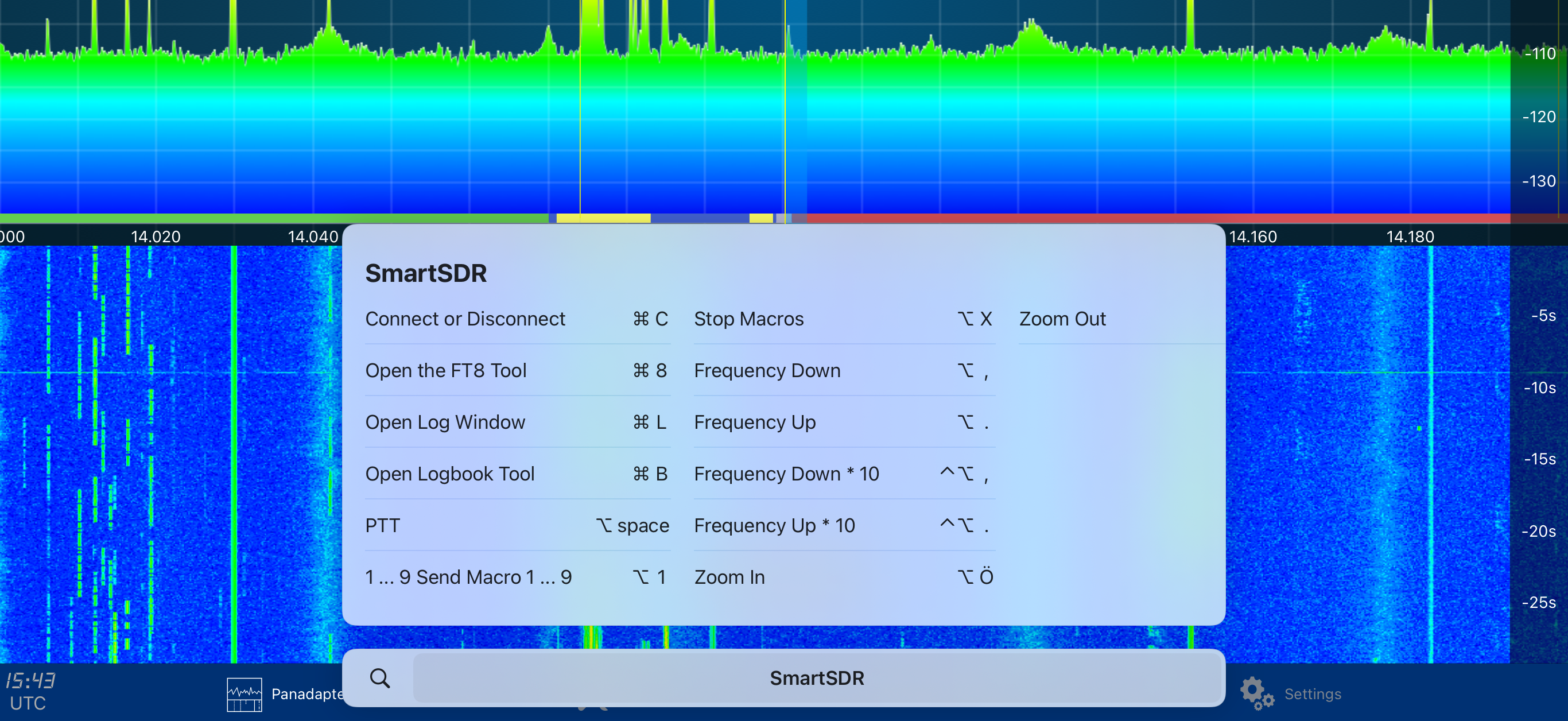
Note
This list can be scrolled horizontally.
Common Issues
Can’t connect to the Radio
You can’t connect if you accidentally disabled Local Network access for the App. You can re-enable Local Network access in the iOS Settings under Privacy -> Local Network.
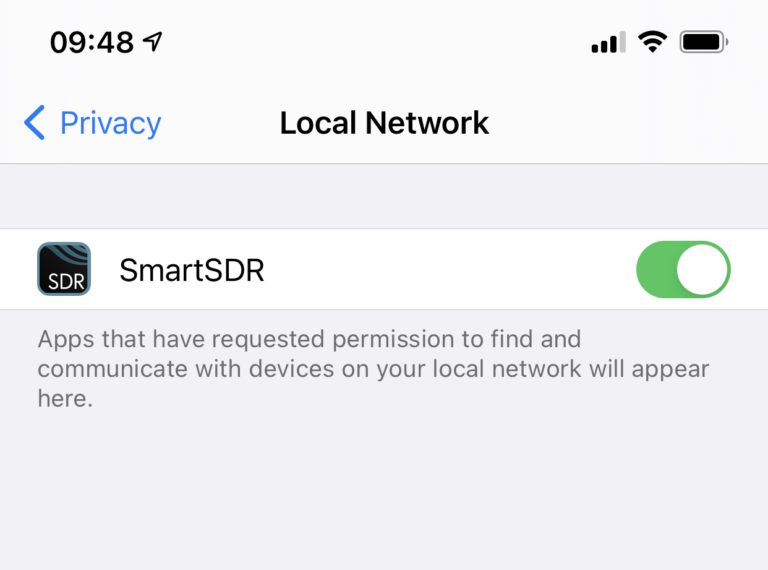
Here, you should see an entry for SmartSDR which should be enabled. If you don’t see this entry, continue to use the fixed IP until you get the permission question from iOS.
Still not able to connect to my FlexRadio (locally)
If you can’t connect to your FlexRadio by using this App, please try to connect to your Radio by using SmartSDR for Windows or your Maestro if possible. If this also fails, there might be a network issue. Sometimes it also happens that it is necessary to restart the FlexRadio in order to be able to connect again.
If SmartSDR for Windows or Maestro can connect, in normal situations, on a regular Home Network, the App should also be able to connect to your FlexRadio without any further setting.
If you still can’t connect, please check your WiFi settings. If, for instance, you are using a WiFi Guest Network connection, you will be able to browse the Internet but not to connect to your FlexRadio.
Not able to connect to my FlexRadio via SmartLink (remote)
If you encounter difficulties with SmartLink, the first troubleshooting step you should undertake is to verify that you can establish a connection without using SmartLink (local).
After you’ve successfully established a local connection, please refer to the section titled “SmartLink doesn’t connect properly” later in this chapter for more comprehensive troubleshooting guidance.
No Waterfall, Panadapter and/or Audio
If you can’t see the Waterfall but it is possible to connect to your Radio and you are even able to control the frequency, these are the most common reasons:
If you are running Firmware Version 1.x on your Radio, turn off “Network MTU” and “Reduce DAX Bandwidth” under Settings -> Show Extended Settings.
If you are accidentally using SmartLink for a local connection, while you are using WiFi at the same location where your Radio is located, you will have to use the LAN mode, not SmartLink. SmartLink is meant for remote access.
If you are trying to remote connect to your Radio using SmartLink and don’t see the Waterfall, the UDP part of the connection is not working. To fix this, please see the following point “SmartLink doesn’t connect properly”.
In other cases, a missing Waterfall indicates missing UDP data traffic. So if you are using a VPN or Firewall or a Guest WiFi access solution or are bridging two different networks, please double check the settings for these setups. UDP (and not only TCP) traffic must pass through between your Radio, over WiFi to your iPhone or iPad.
Try the “Reset Radio Client ID” button under Settings -> Show extended Settings. This button will fix an issue if your Radio might have corrupted connection settings.
Connection freezes after exactly five minutes
A few Netgrar Routers have a bug known as “False UDP Flood Detection”. This Router Bug causes the communication with this App to freeze exactly after 5 minutes. This can also happen if such a Router is installed at either end of a SmartLink connection. Unfortunately, this known bug is not yet fixed by Netgear by the time of writing but if you are affected, you may want to check for a router update. If that doesn’t help then unfortunately the only solution is to replace your Netgear Router – which is, by the way, no bad idea as Netgear Routers are well known for their bugs and security issues.
No TX Audio sound or no transmission at all
If TX audio in SSB used to work and doesn’t work any longer after re-connecting, please try to change the Microphone input source from iPad or iPhone to something else and then back to iPad or iPhone (using the right menu, button above the PROC button).
If this doesn’t help, common causes of missing or low Microphone transmission sound are:
Most common: Wrong Microphone input selection. (Use the right menu and ensure iPhone or iPad is selected as Microphone input. This is the button above the “PROC” button)
Confused between currently selected (active) and TX Slice (ensure that TX mode is on for the Slice you are currently expecting transmission)
DAX enabled (DAX needs to be disabled. Ensure that DAX is grayed out by using the right menu)
Wrong mode selection (e.g. CW instead of LSB/USB)
Low Microphone gain (Use the right Menu and ensure the gain slider is set high enough)
Low general “Microphone adjust” gain (Use the slider in the left Audio menu at least at center position)
If you are using SSB with VOX, check if the VOX threshold value is low enough to get triggered.
If the issue persists, try to switch to another Microphone Profile (right menu, button left from +ACC)
Distorted TX signal, especially on FT8
To monitor your TX signal, turn on “Show TX in Waterfall” from the Flex-6xxx settings Menu -> Transmit. With this setting enabled, you can see the shape of our TX signal on the Panadapter.
If you see, that your signal is distorted, try to lower the FPS slider in the left Audio menu. Also the Rate slider may help but mainly the FPS slider.
Another source for a disrupted TX signal could be network issues. To verify this, open the Network Stats tool. Some Errors are normal but the percentage should always be below 5 %.
No Sound, too low or no sound at all from the iPhone/iPad Speaker
Common causes of no or low sound output from the iPhone/iPad are:
Audio is muted (Speaker Icon at the top)
Under Audio (left menu) “iPad Audio” (or “iPhone Audio”), not switched on
Current selected Slice muted (Speaker Icon on Slice detail screen)
Current selected Slice volume too low (Tap on Audio on the Slice Detail screen and use the Volume Slider)
iPhone/iPad Volume set too low (Use the physical buttons at the side of your iPhone/iPad to increase the volume)
A Bluetooth or physical headset is connected and audio comes out of this accessory and not the internal speaker
Volume adjust slider in the settings screen set too low
In settings, set “Default to Speaker” to on and disable “Allow Stereo” may increase output volume
Too low Microphone gain
To increase the Microphone gain, you can not only use the Slider in the right Menu but also the Mic Boost setting on the Flex Settings screen as well as the “Microphone adjust” slider in the left Audio menu (not the Flex Settings) screen.
Can not select the iPad (or iPhone) microphone
If the Microphone selection always jumps back from iPad (or iPhone) to MIC, just select another MIC Profile (the button left from the +ACC button).
Note
A Microphone profile can only be used once at a time from a device. If the same profile is being used by a Maestro or the M-Model front-panel or even from another SmartSDR instance, it will not work.
No Bluetooth Headset output
Ensure you have audio even without the Headset
Ensure you have audio on your Headset without using the App
Ensure the Setting “Default to Speaker” in the Settings screen is switched off
Ensure audio gain of the headset is set high enough
Toggle the top speaker icon to mute and un-mute to see if the Headset starts working then.
Use the control center (opens when sliding in from the bottom) to double check if your Headset is available for selection and is selected for audio output.
Distorted or interrupted sound and waterfall
The FlexRadio submits a huge amount of data to the App and the App has to process these packages real quick. This uses up a high percentage of the Network and CPU. For this reason, the Network needs to be very responsive and the CPU of your device need not to be strained by other Apps or tasks in the background.
For the Network, please ensure the best performance as possible. For WiFi, ensure you have a proper connection on a channel that is not being used by somebody else. Ideally use the 5 GHz band as this is usually not yet as busy as 2.4 GHz Band. If on the road and using the Cell network, ensure you have LTE / 4G available with enough bandwidth. For your local Network, use good Switches, good Network cables and a 1 GBit/s Network, if possible.
On your iPad / iPhone try the following settings:
Turn Bluetooth off to see if this helps (iOS Settings -> Bluetooth)
If you can’t turn Bluetooth off, remove all paired but no longer needed devices. iOS is looking for these devices from time to time which degrades network traffic.
Turn off location Services (iOS Settings -> Privacy -> Location Services)
Turn off Background App refresh (iOS Settings -> General -> Background App refresh)
Turn off automatic downloads (iOS Settings -> iTunes & App Store -> everything under AUTOMATIC DOWNLOADS)
Change the NET Setting of the App to Slow (App Settings -> Show Extended Settings -> Net Speed -> Slow)
Change FPS and Rate of the App to lower values (App -> left Menu -> Disp)
If one of these settings fixes the issue, you can then try to narrow down the root cause of the issue.
Another cause for Distortions can be slow DX-Cluster updates. If you have DX-Cluster enabled, please switch it off to see if the problems discontinue. If that’s the case, please try a different DX-Cluster Server or increase the update interval.
Headset only Mono
Headsets can not be used in Stereo due to restrictions of iOS. iOS reverts audio output to headsets back to mono as soon as the Microphone is being used like for a regular phone call where stereo is not supported.
There is no solution yet as this needs to be fixed by Apple.
However, it is at least worth a try to select the “Allow Stereo” setting from the Settings screen of the App.
CWX Speed and Delay settings are not regarded
Most likely, you switched off CWX Sync in the Radio CW Settings. To enable CWX Sync, connect to your radio. Then select the FLEX-6xxx Settings tap at the bottom. Here, select CW and switch CWX Sync to on.
SmartLink doesn’t connect properly
If SmartLink did work until recently and you have an issue all of a sudden, try to power cycle your Network Router, then wait until your Internet connection is back then power-cycle your FlexRadio.
If that doesn’t fix your problem, proceed as follows:
After setting up SmartLink with SmartSDR for Windows or Mac, always try the SmartLink test button and check if it turns green. If it’s not green, you will need to sort this issue out on your Radio, SmartSDR and your Router before you continue.
Next, ensure that your iPad/iPhone is not connected to your network via WiFi (e.g. disable WiFi)
Start the App, change the “Connection Type” to “SmartLink” (as mentioned before) and try to connect
You shout see the SmartLink setup screen titled “Setting up SmartLink”. In case you have not yet entered your SmartLink credentials, you will be prompted for them now. This screen should not end with an error. In case of an error, either the SmartLink server can not be contacted or your credentials are not correct. If this screen disappears without an error, all is well.
Next, try to connect to your Radio (Tap on the Panadapter screen or the “Con” button) and you should see your Radio in the Radio chooser.
If you tap on the Radio, and it doesn’t connect at all or drops you back, proceed as follows:
Back on the Radio chooser, tap on the (i) Icon for your Radio
Scroll down and locate the “Remote TCP Port” and “Remote UDP Port” and double check if these are the same ports you have configured for SmartLink and manually forwarded in your router. If you are using UPnP, there might be different ports and they don’t have to be manually forwarded but in no case can these ports be anything equal to or below zero.
If these ports don’t match or are equal to or below zero, try to setup SmartLink again on your Radio, use manual settings and forward the same ports on your router.
Here are some other considerations regarding SmartLink:
If your internet provider like (T-Mobile) only supports IPv6, try to use the IPv6 switch in the “Show Extended Settings” of the App.
It is sometimes necessary to power-cycle the Radio when SmartLink Settings have been changed.
The most common issue with SmartLink is an issue with “Automatic” setup mode of SmartLink. It may work for some time after the initial SmartLink setup but then, all of a sudden, it discontinues to work. For this reason it is recommended NOT TO USE THE AUTOMATIC MODE but the Manual mode instead. The setup instructions here can be used to setup SmartLink (or change an existing setup) in Manual mode.
In the past (around 2018) the was a change of the MAC Address of the FlexRadio network interfaces which may cause some trouble with your Router settings because the Router still assumes your Radio has still the same MAC Address and thus, still uses the wrong IP Address for your Radio. In this case, switch off your Radio, try to delete all traces of your Radio in your Router and start over registering SmartLink and configuring your Router.
Before assuming an issue with the this App, try either to connect to your Radio from another Network using SmartSDR for Windows (e.g. visit a public WiFi spot) or ask a HAM fellow to try to connect.
There are countless resources at the FlexRadio and community website with information on how to setup SmartLink. Just head to these websites or use Google.
However, here are two resources:
My SmartLink reference guide: https://go-to.me/smartlink-reference-guide.php
About Port Forwarding: https://go-to.me/about-port-forward.php


